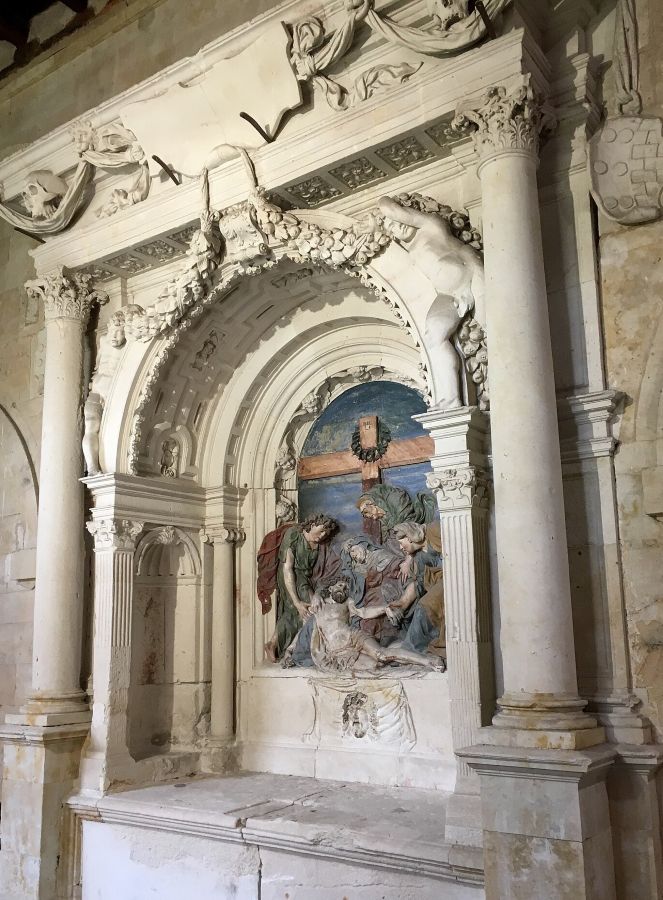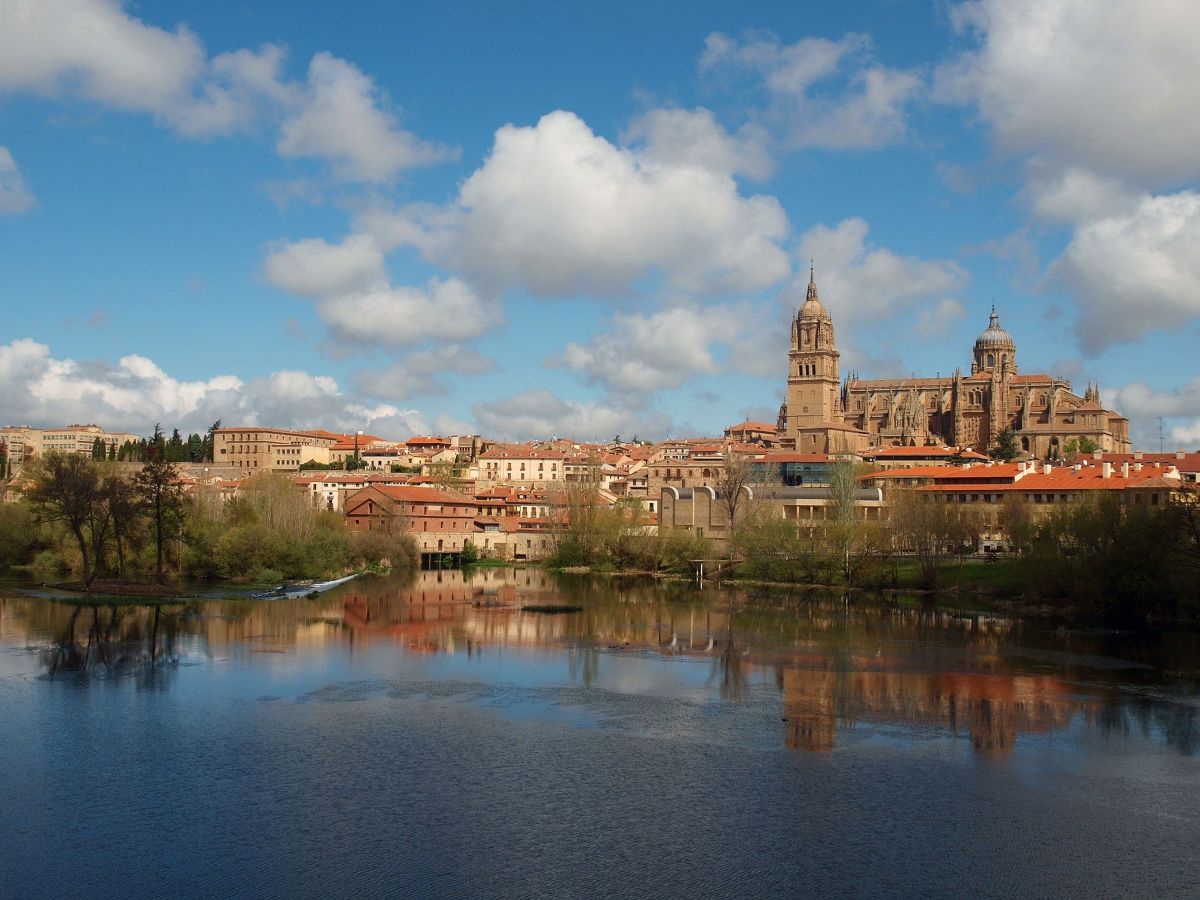Cervantes said: ‘Salamanca makes all those who have enjoyed the pleasant experience of living there yearn to return’. A city with a rich historical and cultural legacy, with an abundance of medieval architecture, nicknamed La Dorada (The Golden) for its golden sandstone buildings that seem to glow in the sunlight. Its University was one of the most important in Europe for centuries.
Walk through the streets of Salamanca
Strolling along St Paul’s Street you’ll find some of the buildings not to be missed on a visit to Salamanca, such as the Salina Palace, the Orellana Palace, the Clavero Tower and St Paul’s Church in Colón Square, the Dueñas Convent and the imposing St Stephen’s Church and Convent.
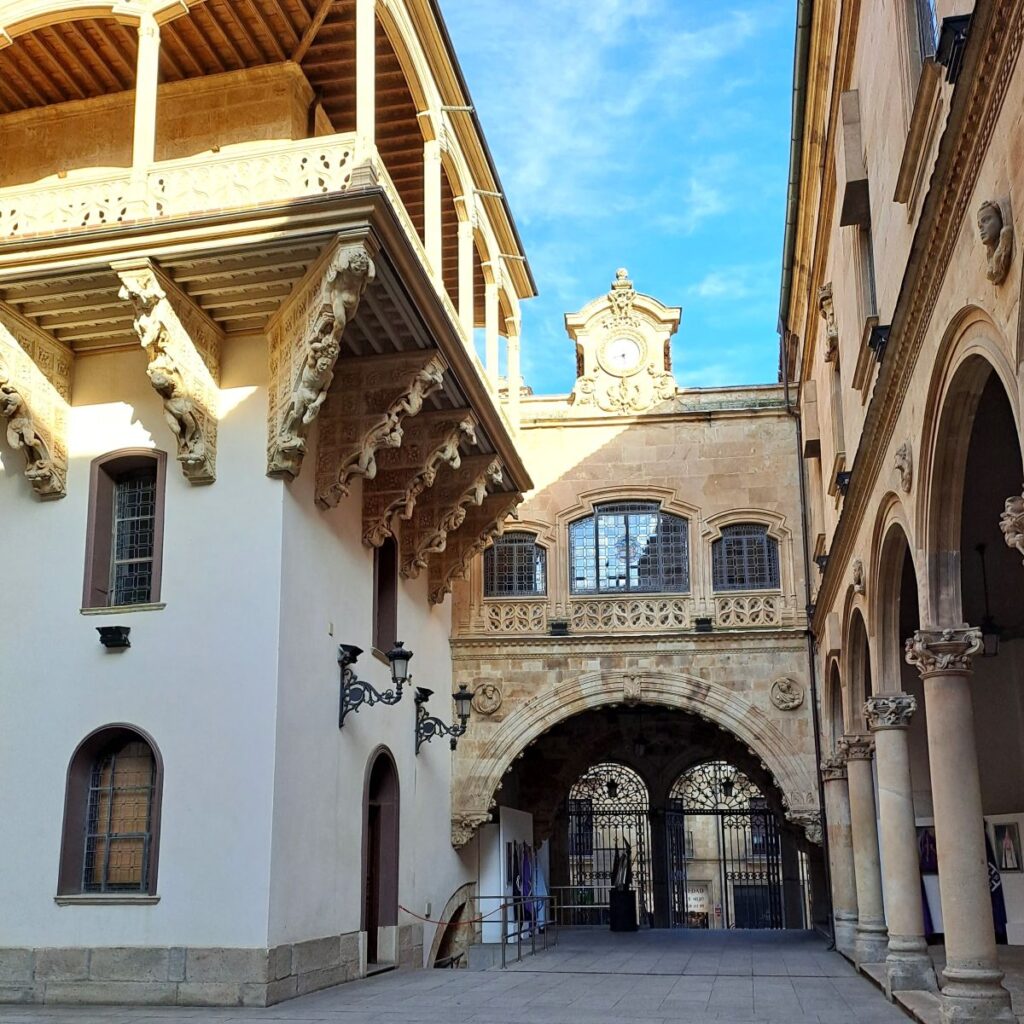
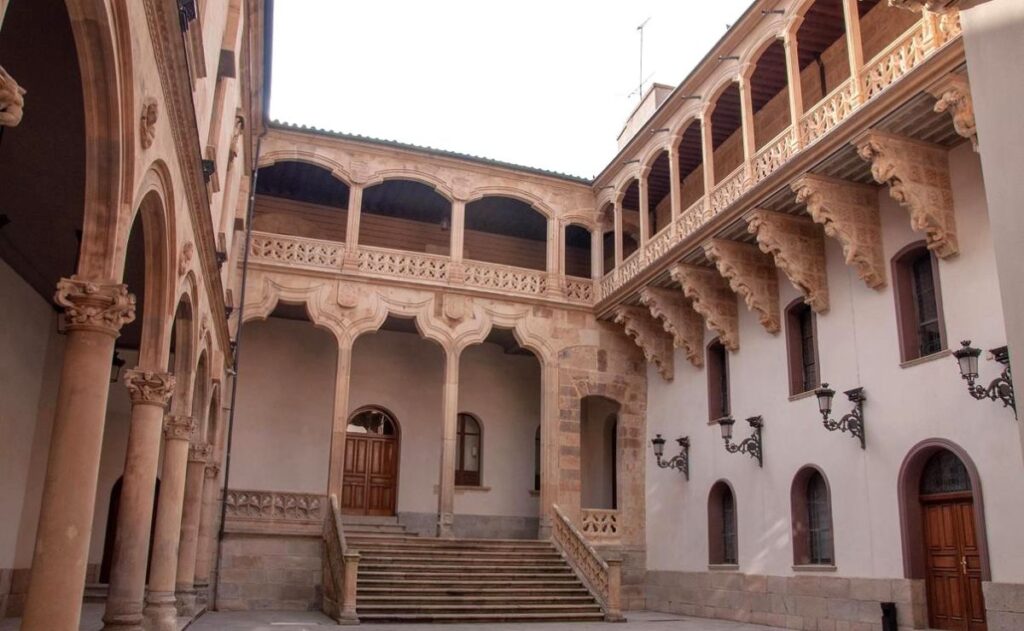
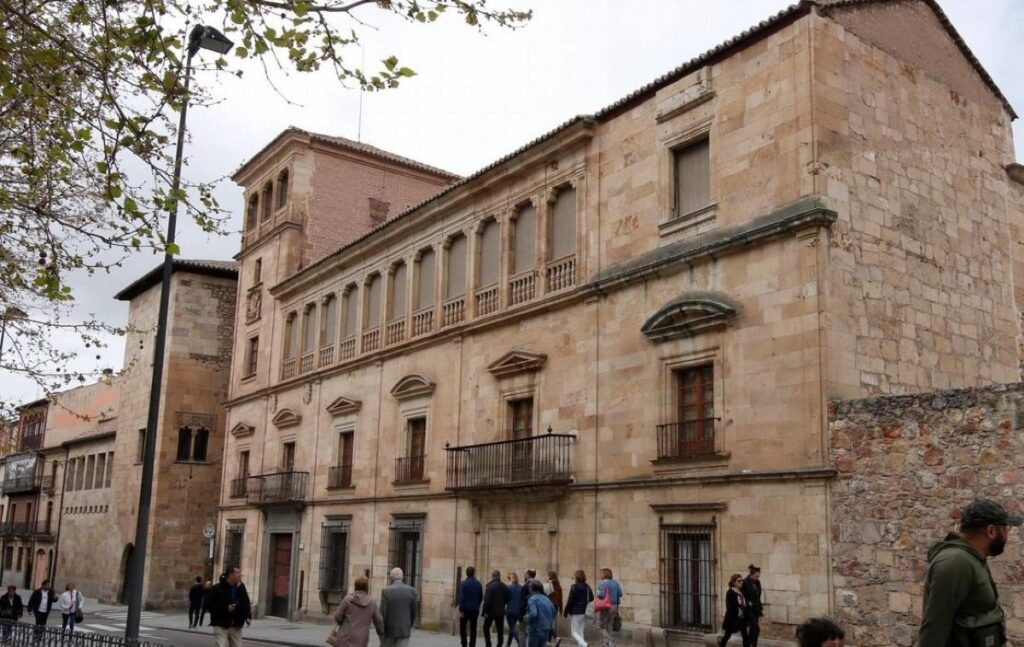

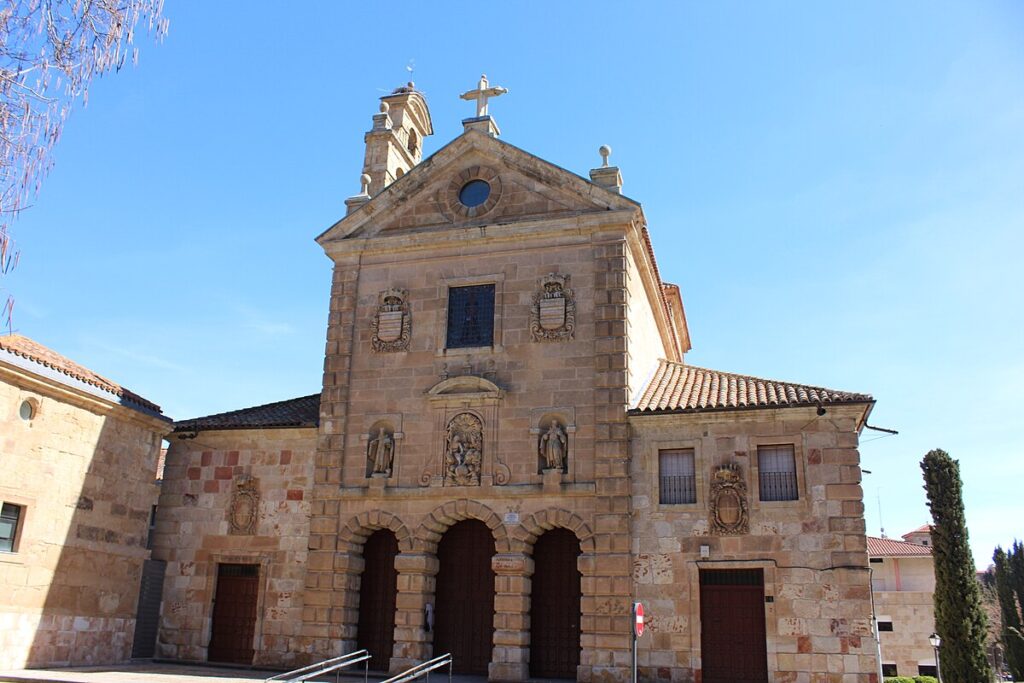
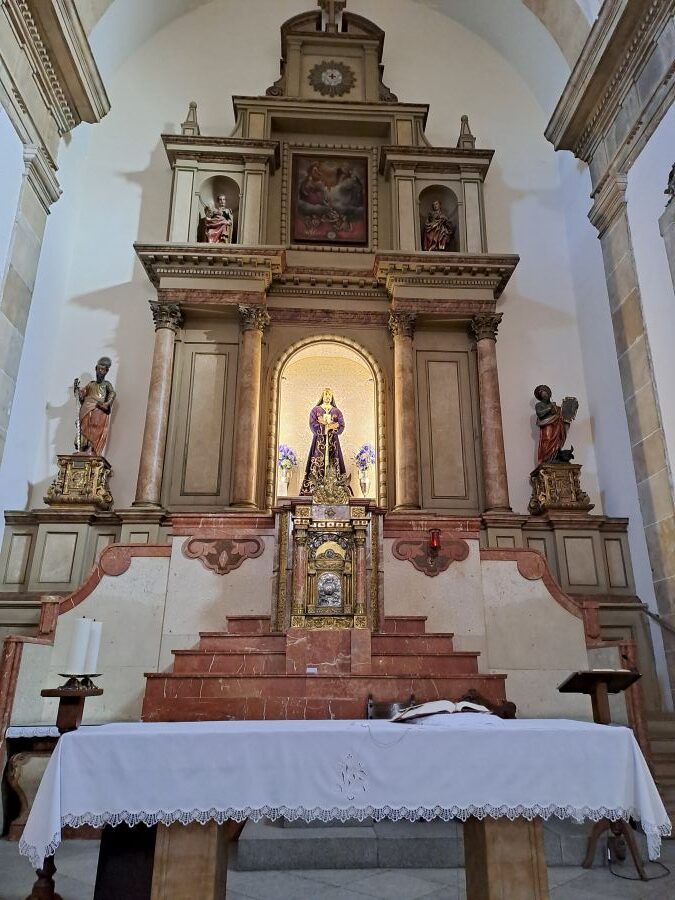


On Compañía street you’ll find the Gothic-style Shell House, built at the end of the 15th century, and the Pontifical University of Salamanca.
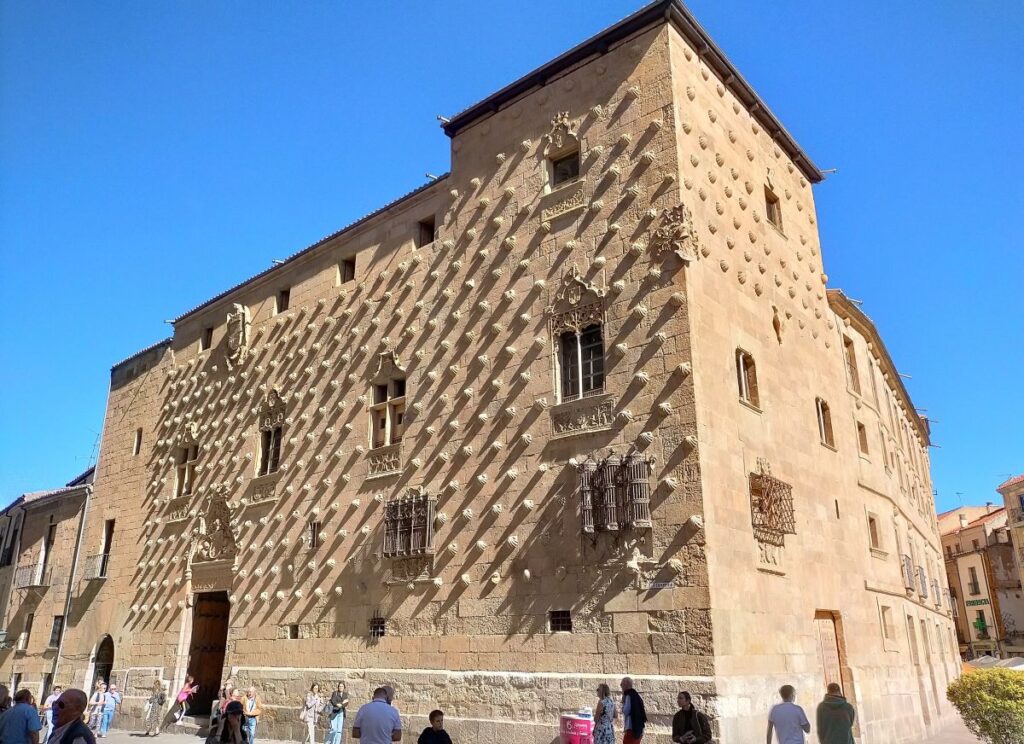
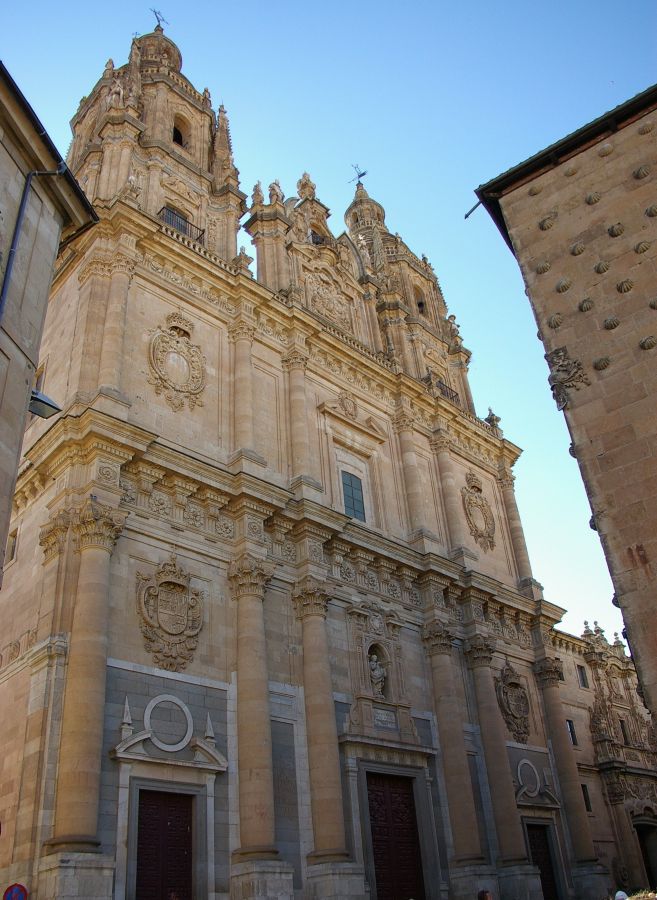
On our last day in Salamanca we took a guided tour of the Old and New Cathedrals.
New Cathedral
The idea of building a new cathedral arose at the end of the 15th century, due to the growth in the city’s population as a result of the heyday and fame of the University, and the Old Cathedral became too small for so many people.
At the beginning of the 16th century, in 1509, King Ferdinand II the Catholic ordered architects Antón Egas and Alonso Rodríguez to design the layout of the new cathedral. Fortunately, the old cathedral could not be destroyed, as it was necessary for worship, and the new one was designed parallel to the old one in the Gothic style. The first stone was laid in 1512, when Francisco de Bobadilla was bishop of Salamanca, and in 1513 construction began on the New Cathedral, dedicated to the Assumption of the Virgin Mary. Construction was interrupted for much of the 17th century due to a lack of budget, but it was finished two centuries later in 1733, characterised by a mixture of late Gothic, Renaissance and Baroque styles. The Old Cathedral has been preserved, contrary to what was originally thought.
The cathedral suffered the devastating effects of the Lisbon earthquake, which occurred two years later, and the original dome by Joaquín Churriguera had to be rebuilt, a work that was magnificently realised by Juan de Sagarvinaga, and the bell tower reinforced.
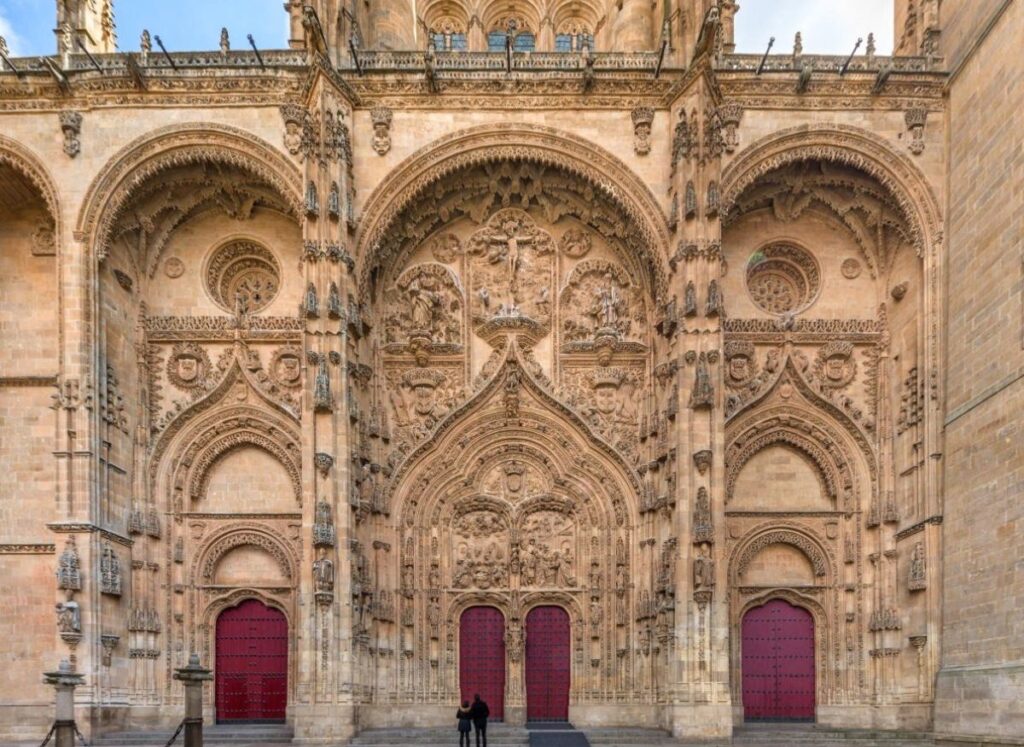
The Portal of the Nativity is the main façade, in which the tympanum over the central door depicts the scenes of the Birth and the Epiphany, under a magnificent ogival arch with images of Calvary – the crucified Christ who closes the cycle of his life – flanked by effigies of Saints Peter and Paul. The other two openings have no decoration on the tympanum.
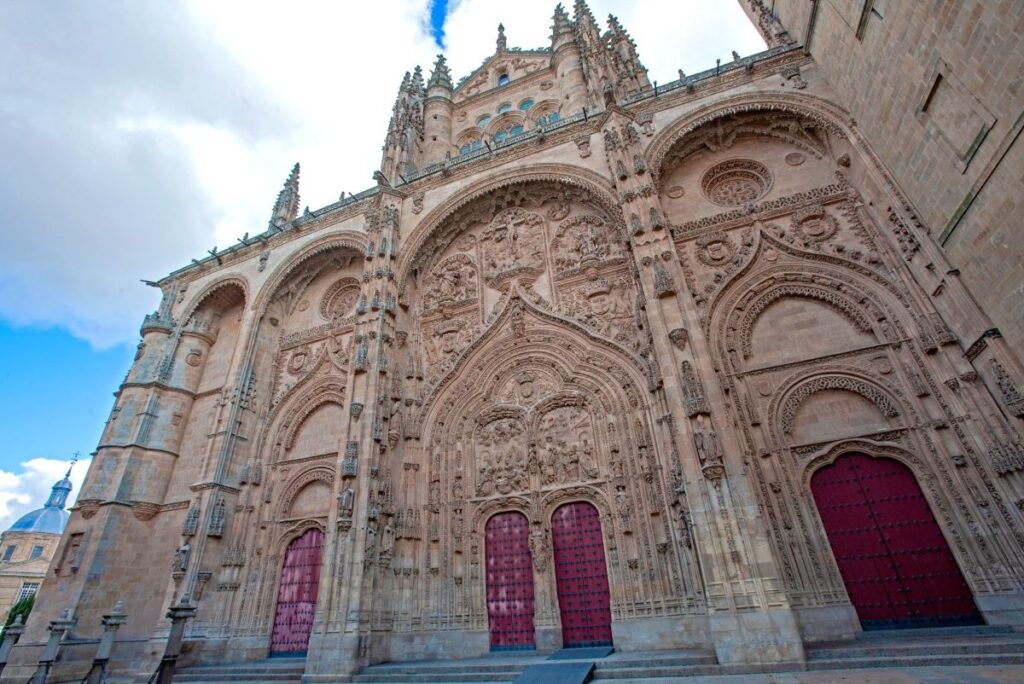
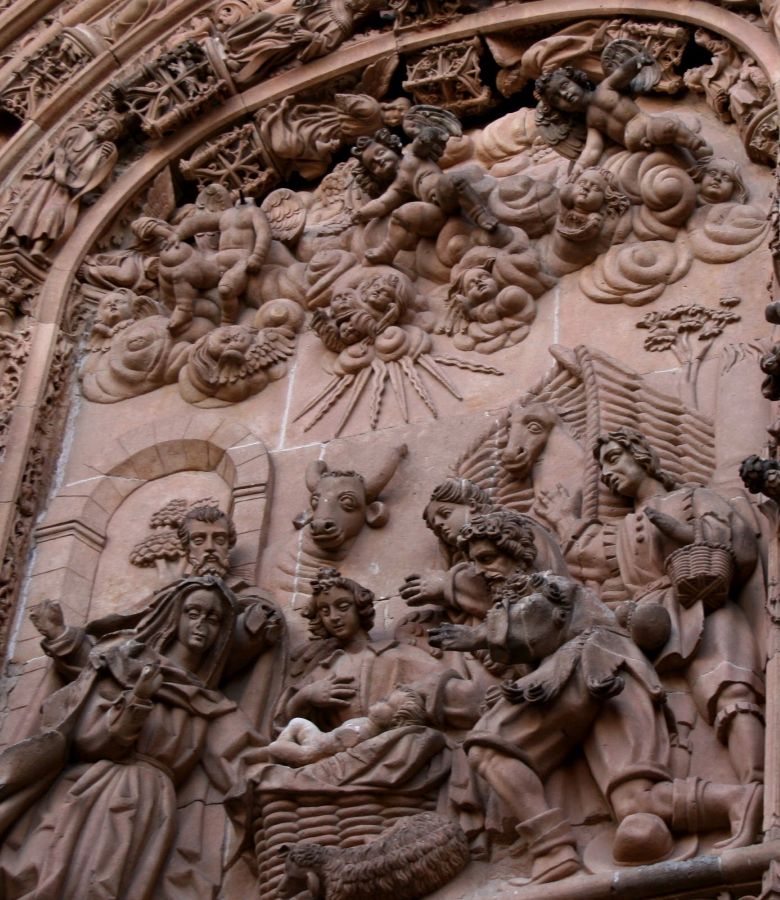
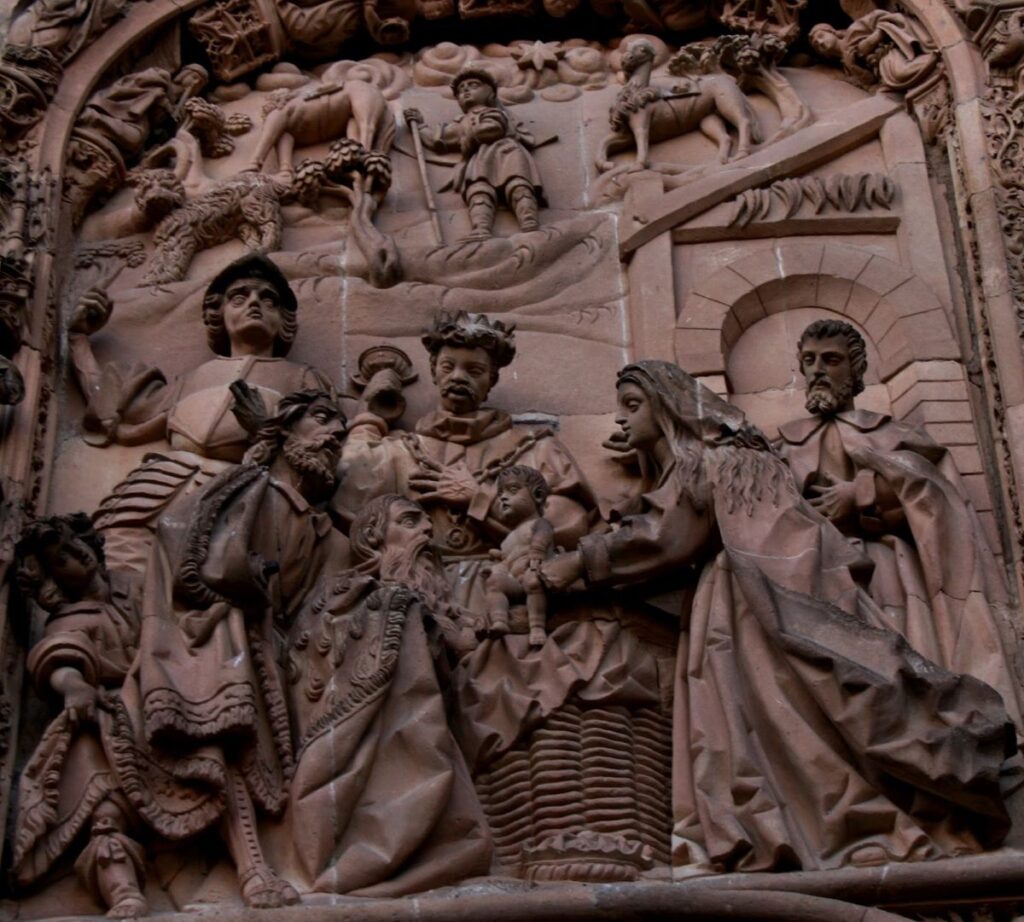
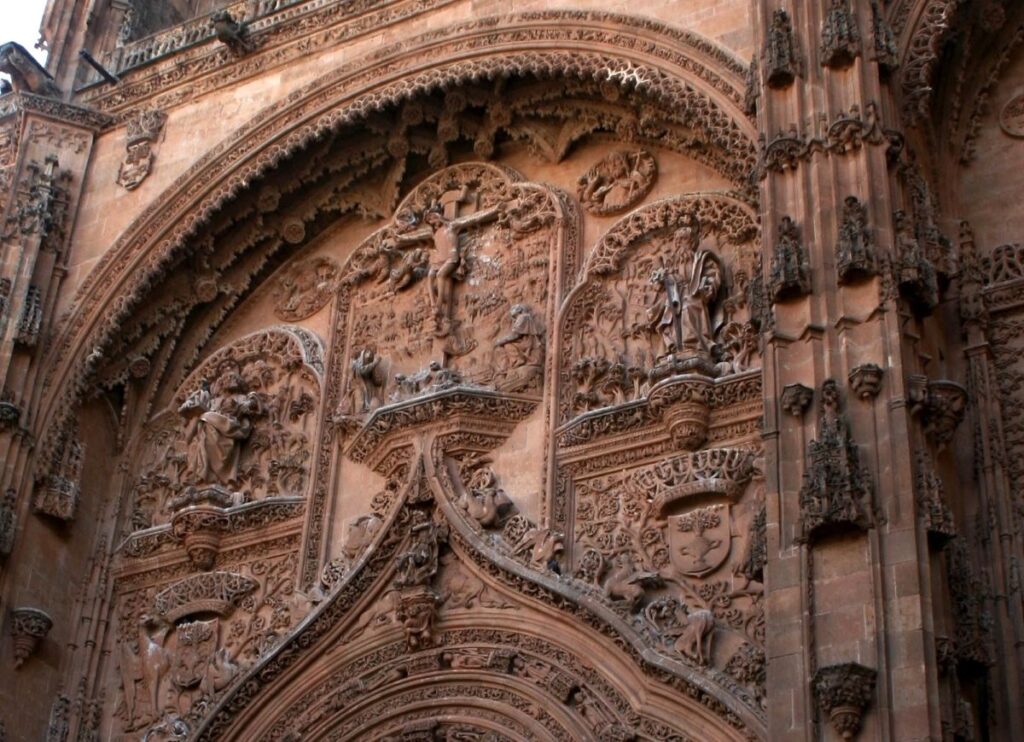
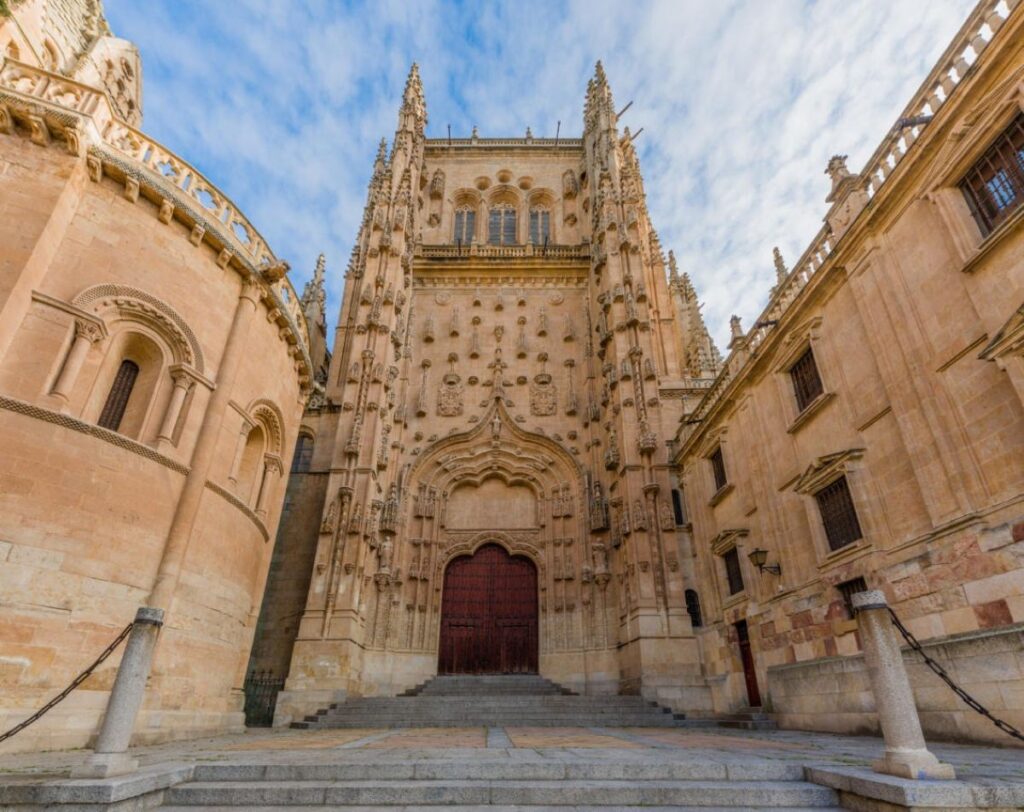
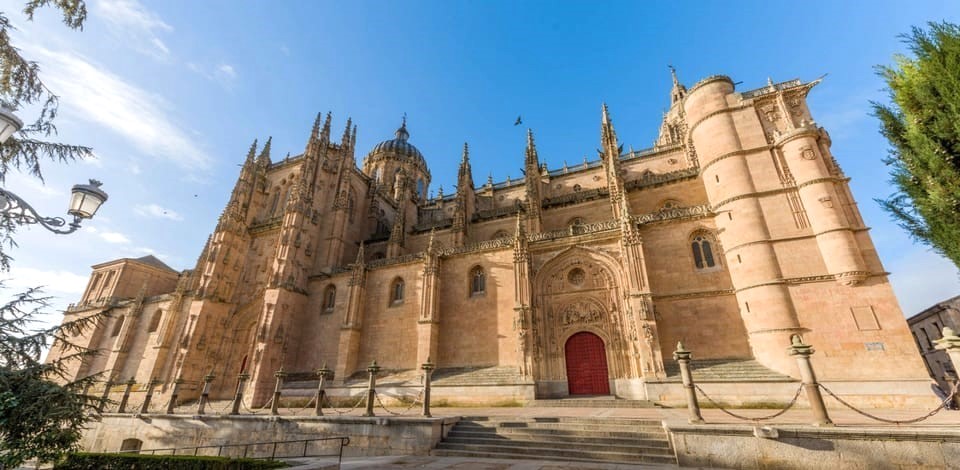
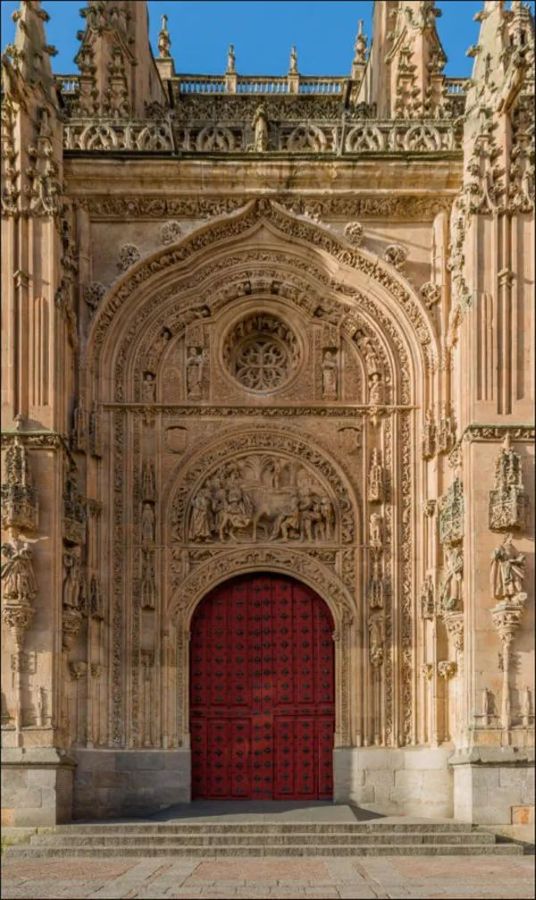
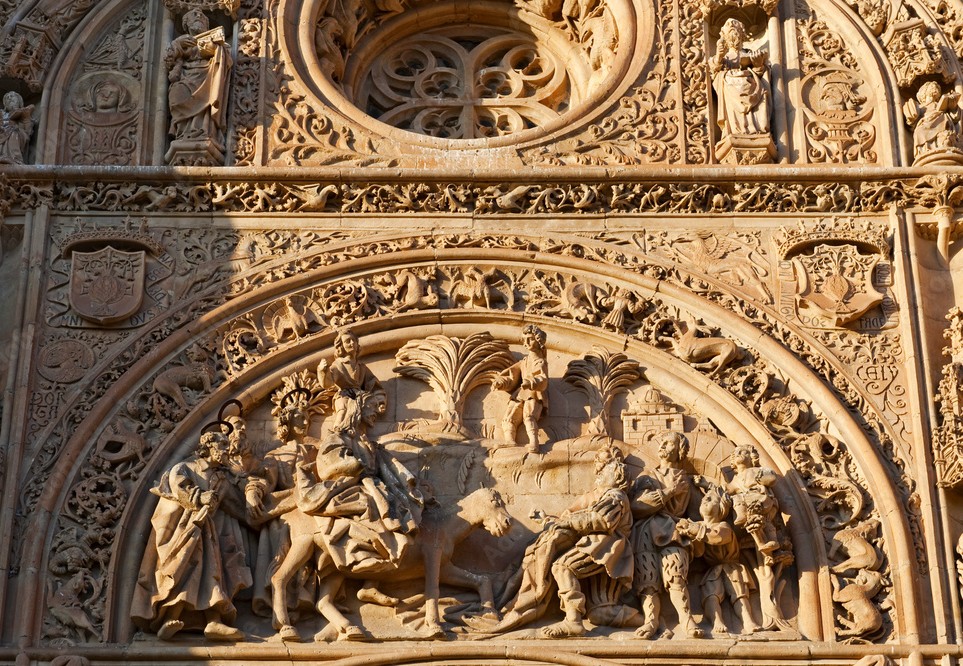
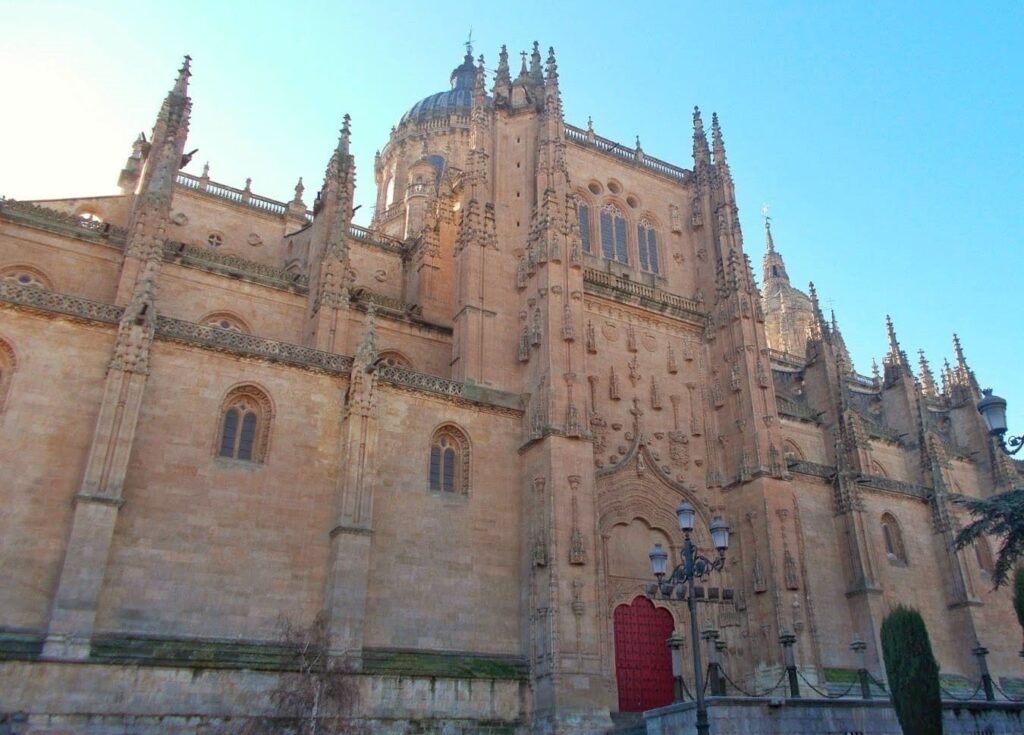
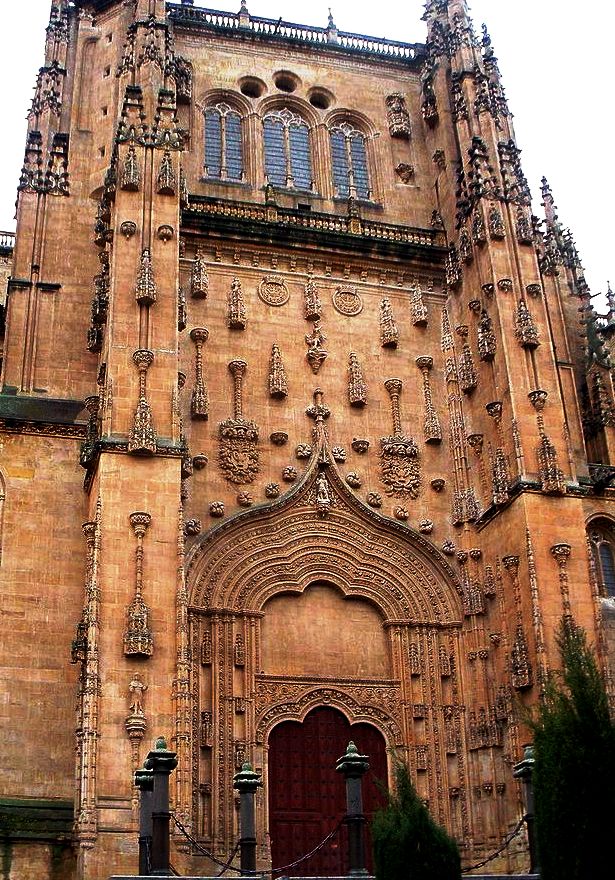
Main Chapel
In the centre, the Main Chapel, built in the second half of the 18th century under a velvet canopy, houses an image of the Virgin of the Assumption made in 1624 by Esteban de Rueda, a jasper and marble tabernacle by Gavilán Tomé, and the silver urns with the remains of Saint John of Sahagún (patron saint of Salamanca) and Saint Thomas of Villanueva. It is topped by a sumptuous polychrome and gilded vault.
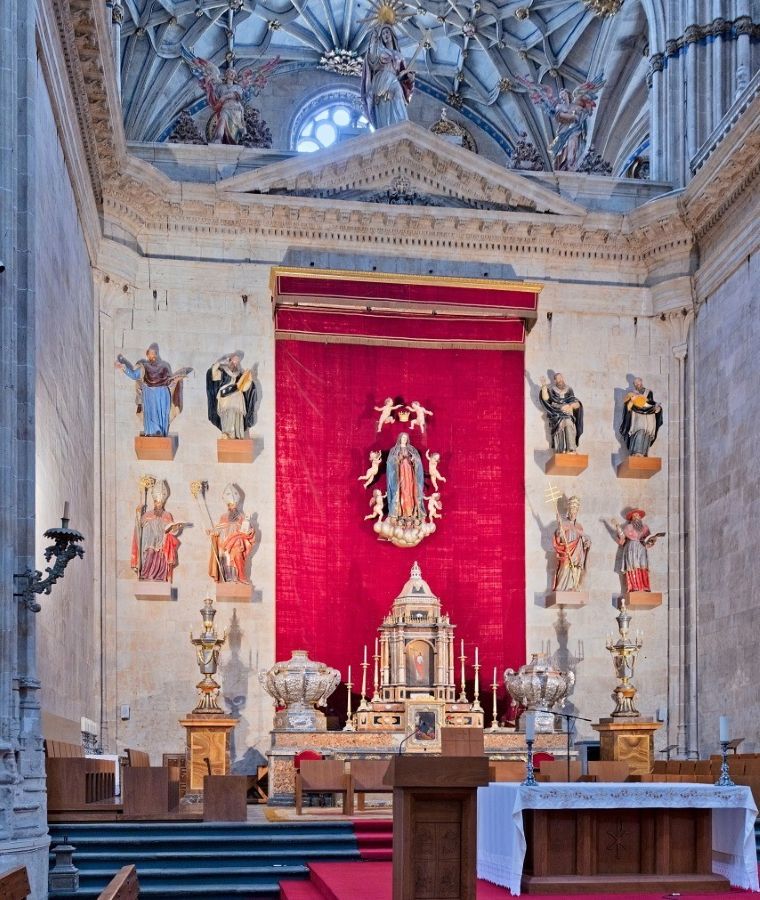
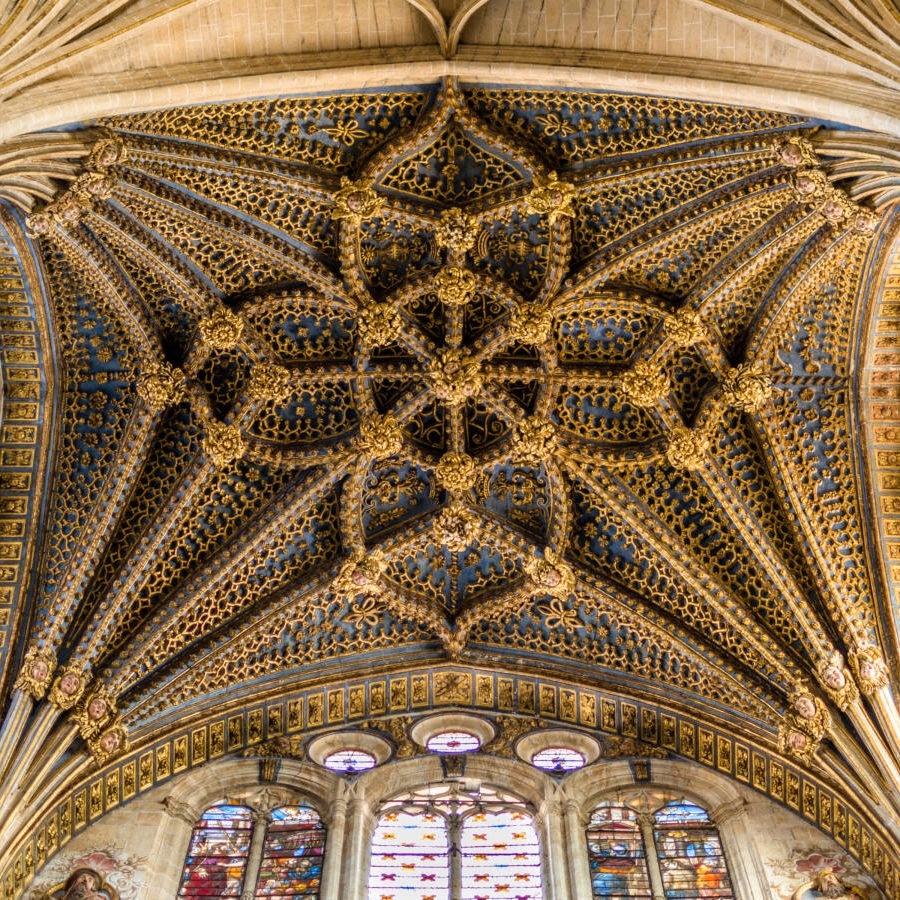
The Canons’ Choir, at the centre of the central nave, built between the 16th and 17th centuries (1710 and 1733) according to plans by Joaquín Benito and Alberto de Churriguera, is a remarkable work of Gothic and Renaissance style. The high choir and low choir in carved wood depict biblical scenes, figures of saints and virgins and decorative motifs that reflect the artistic mastery of the time.
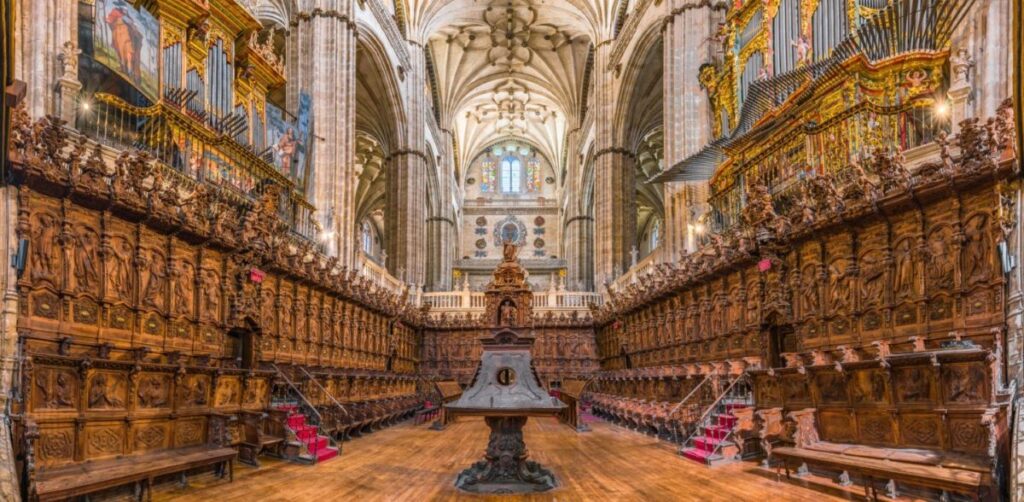
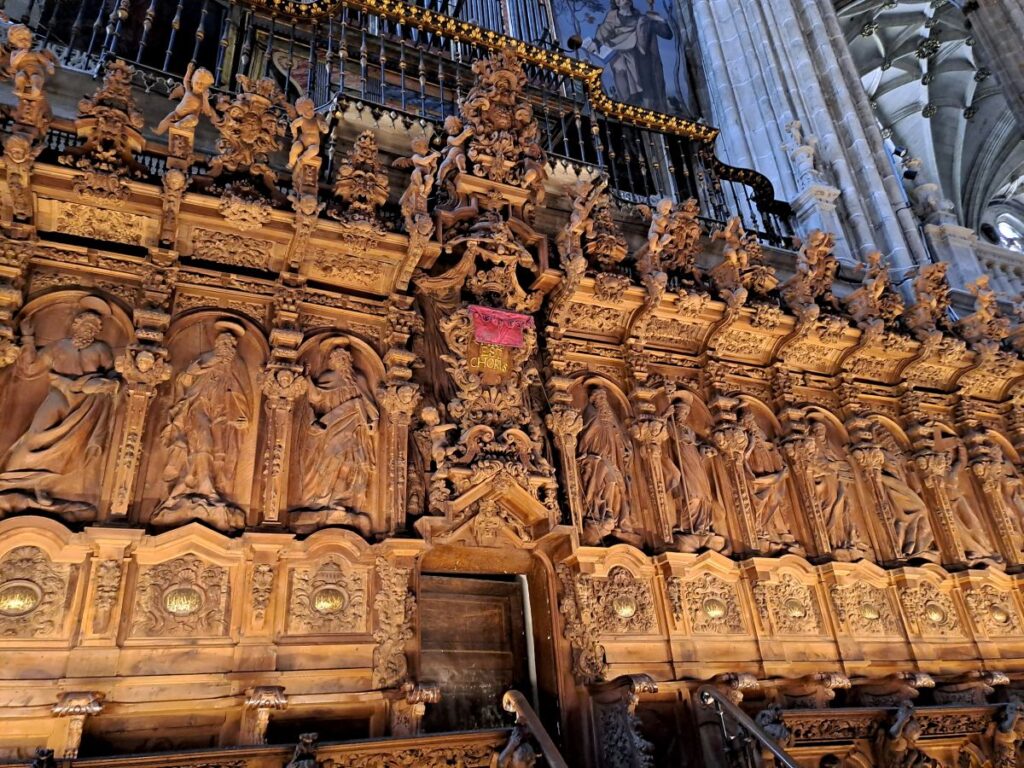
There are two organs in the Choir: the one in the Gospel nave, in the Baroque style, built in 1744 by Pedro Echaverría, and the one on the Epistle side, in the Renaissance style, built in the 16th century by Damián Luis.
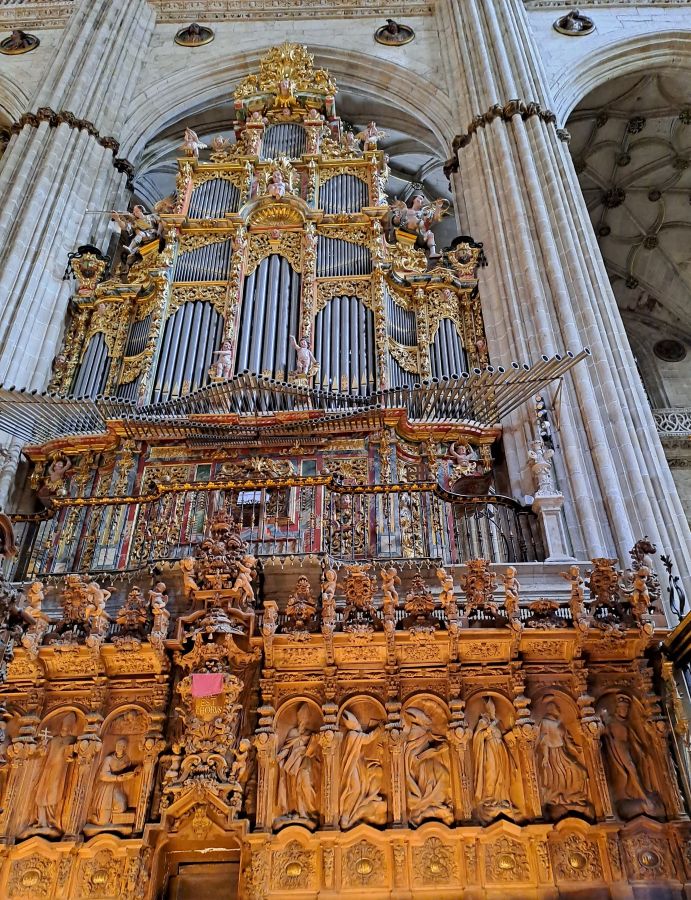
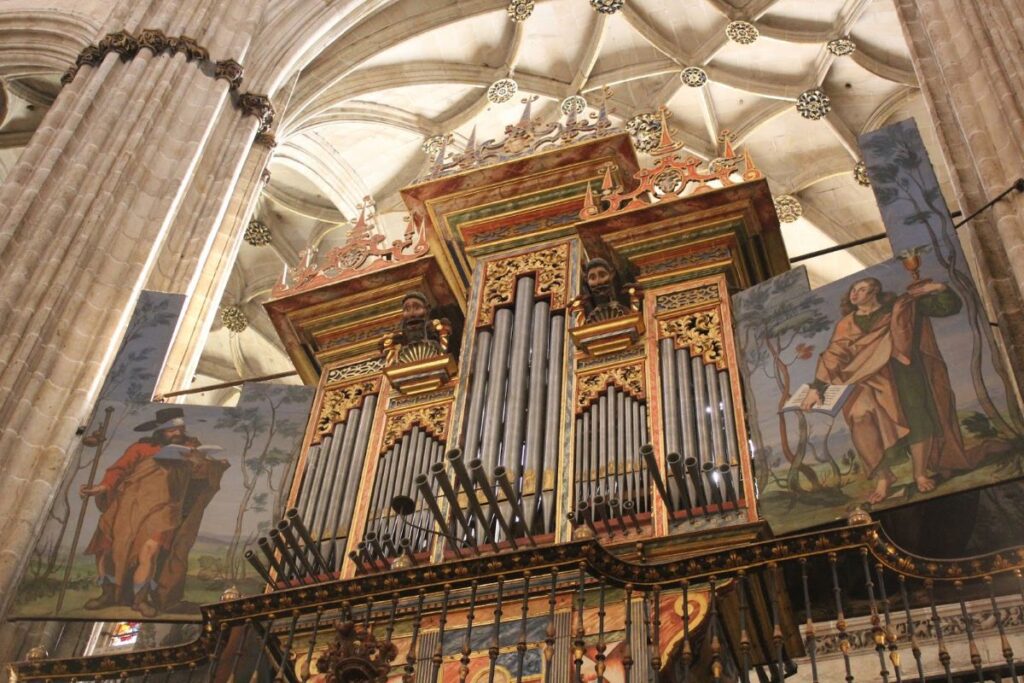
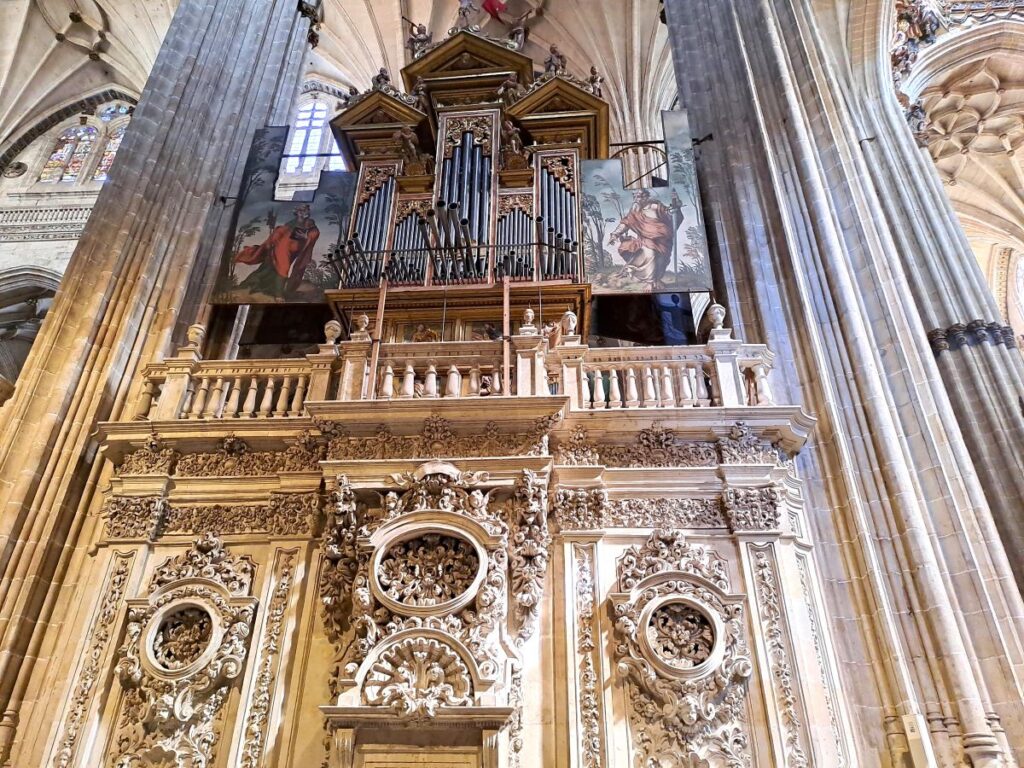
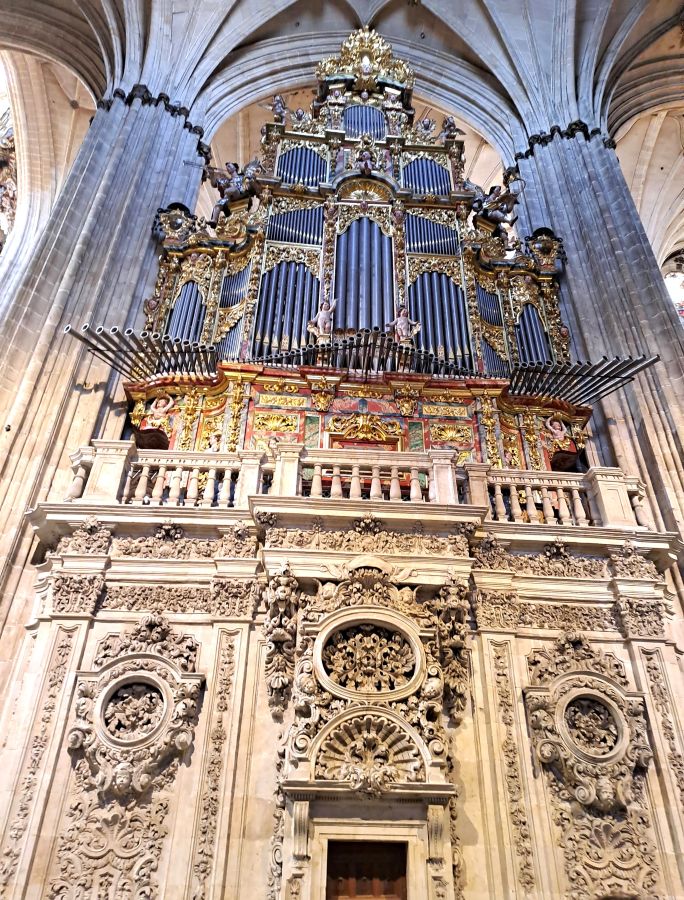
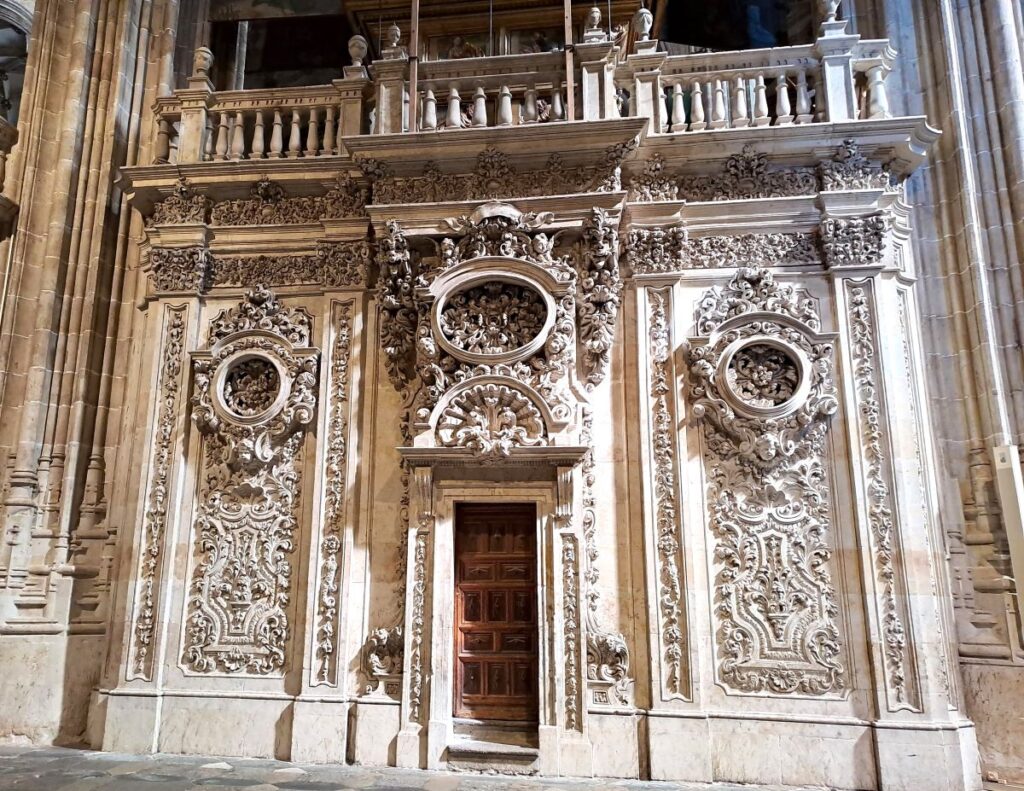
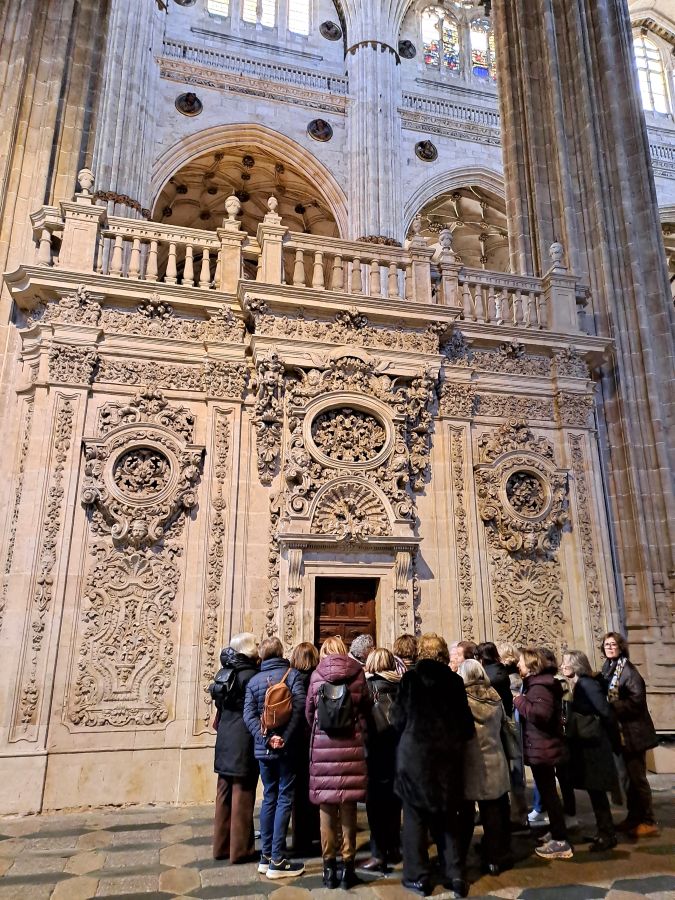
Transept
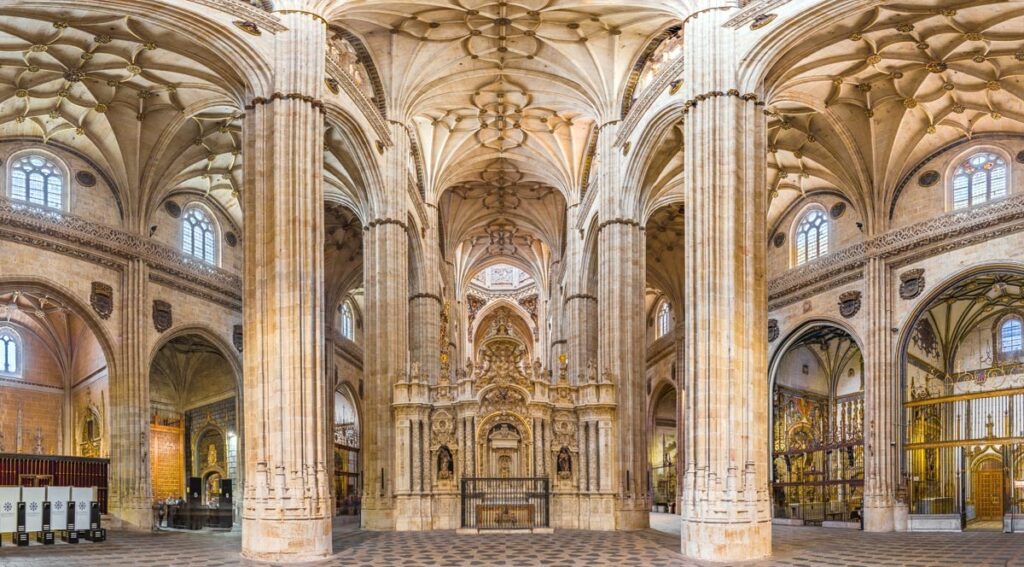
The transept, located between the main nave and the choir, stands out for its elaborate ornamentation and the sculptures that decorate its panels. The image of Saint Mary of Forgiveness, made in the mid-16th century, was placed in the centre, and those of Saint Anne and Saint John the Baptist, the work of Juan de Juni, were placed on the sides.

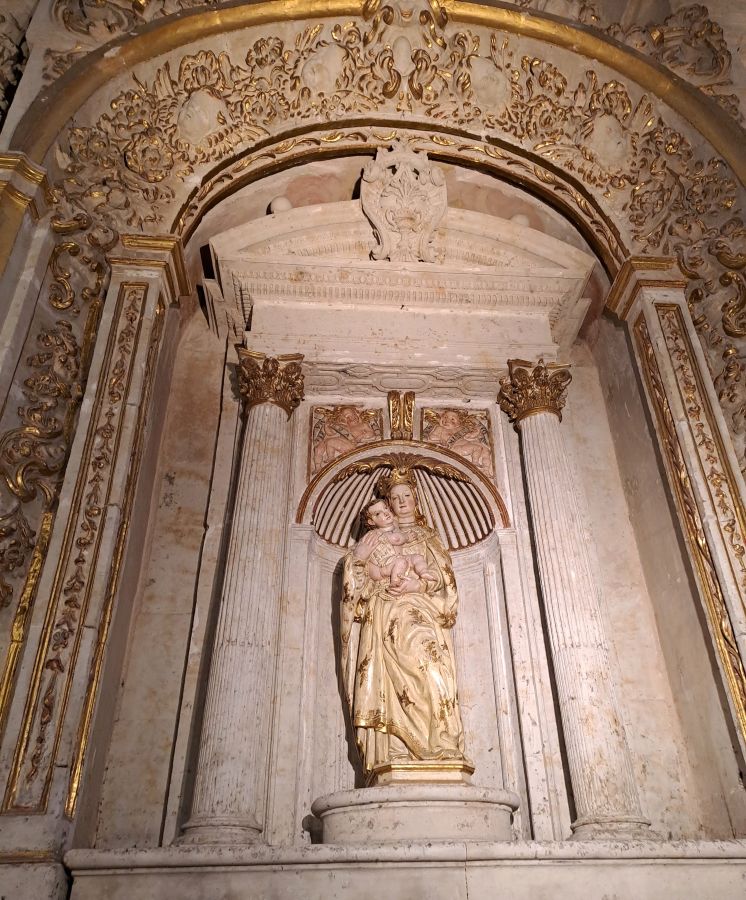
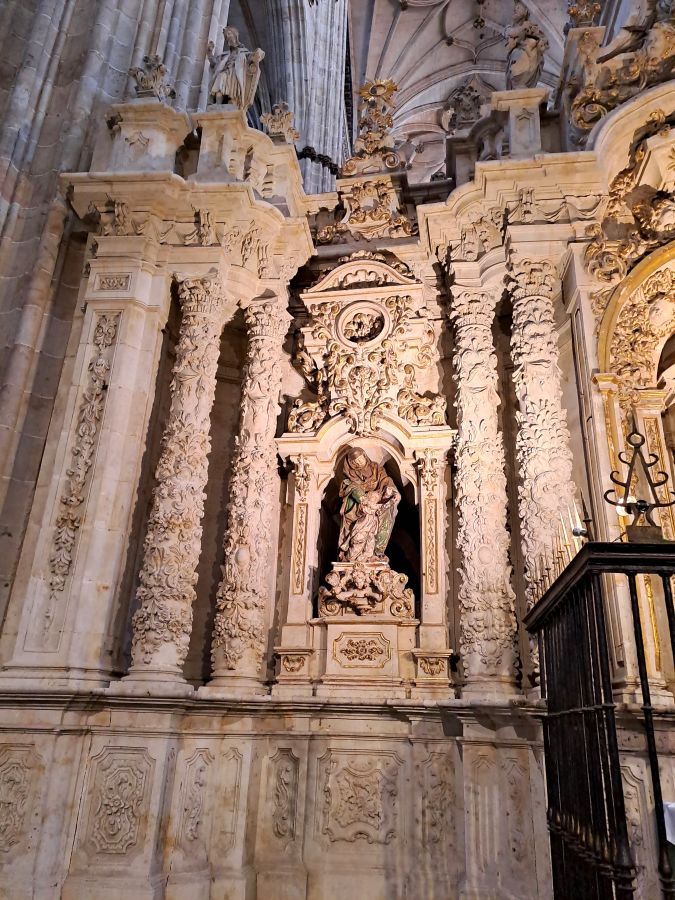
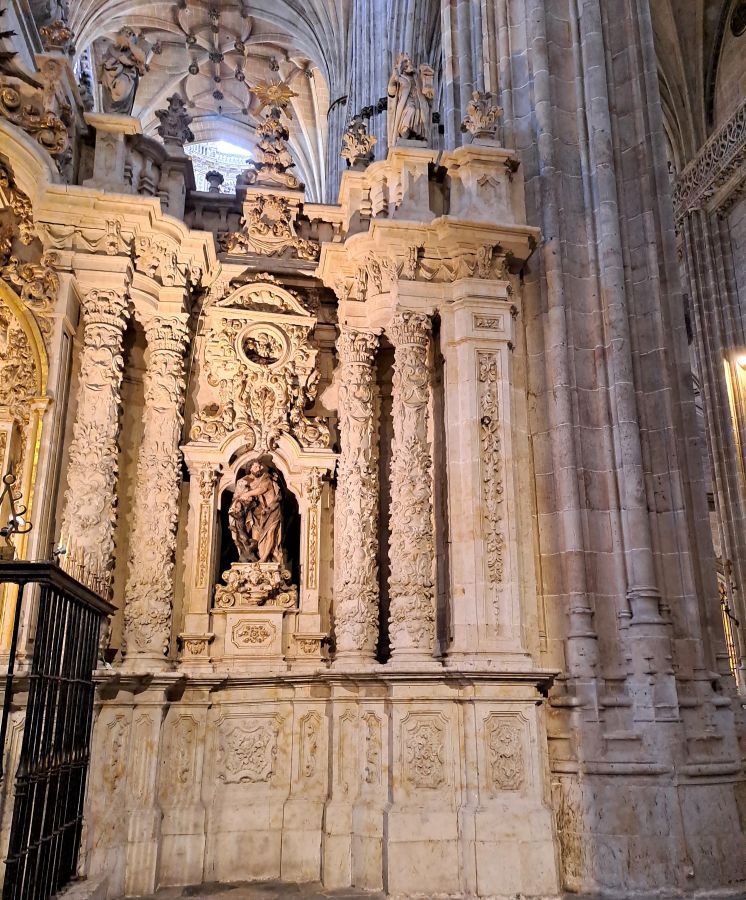

Another notable element of the interior of the New Cathedral of Salamanca is its dome, which rises above the transept and is decorated with frescoes depicting scenes from the life of Christ and the Virgin Mary. This dome is an example of the Renaissance style and is considered one of the most beautiful in Spain.
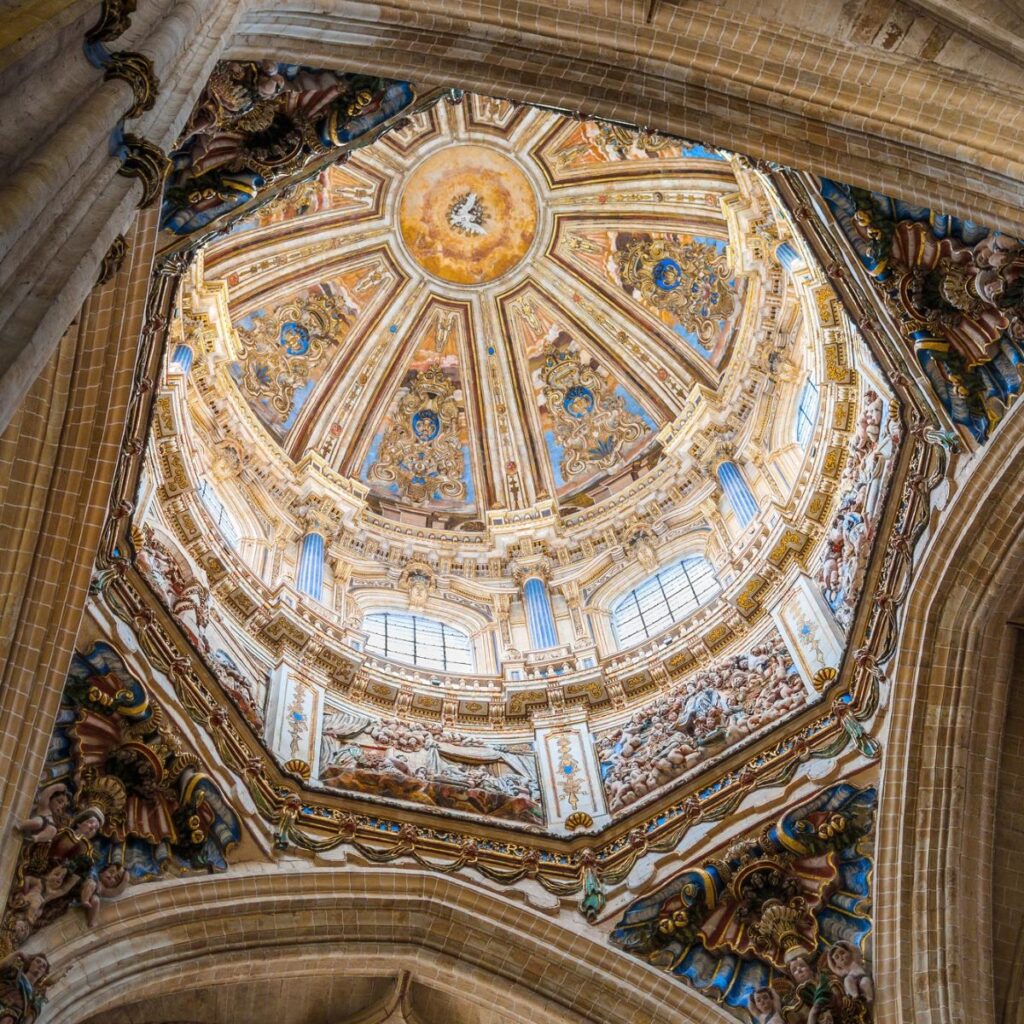
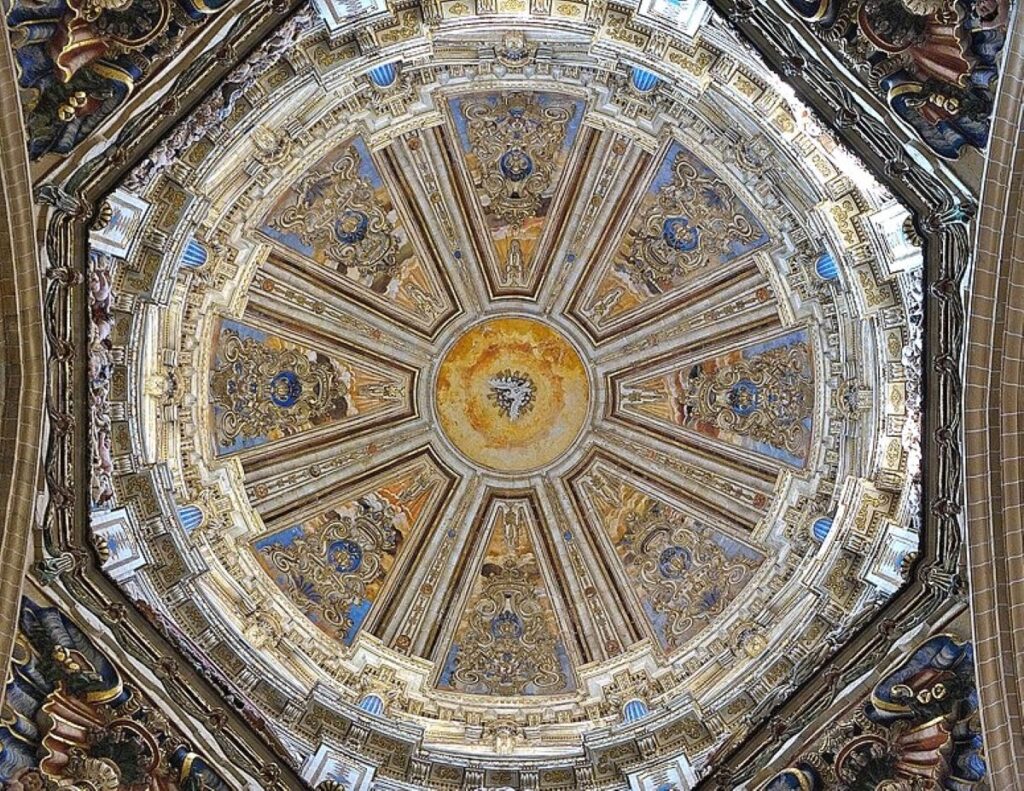
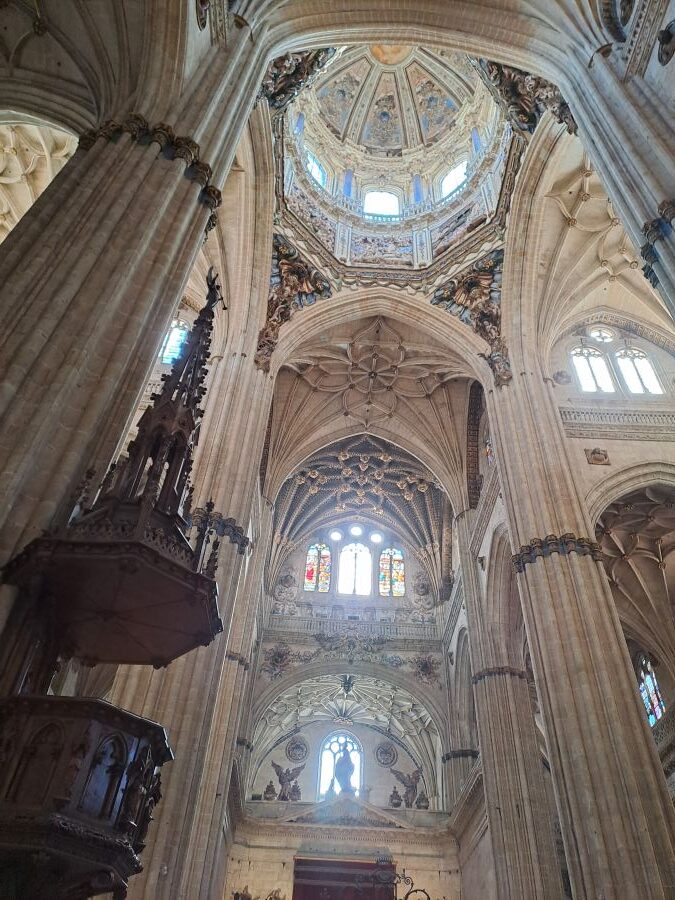
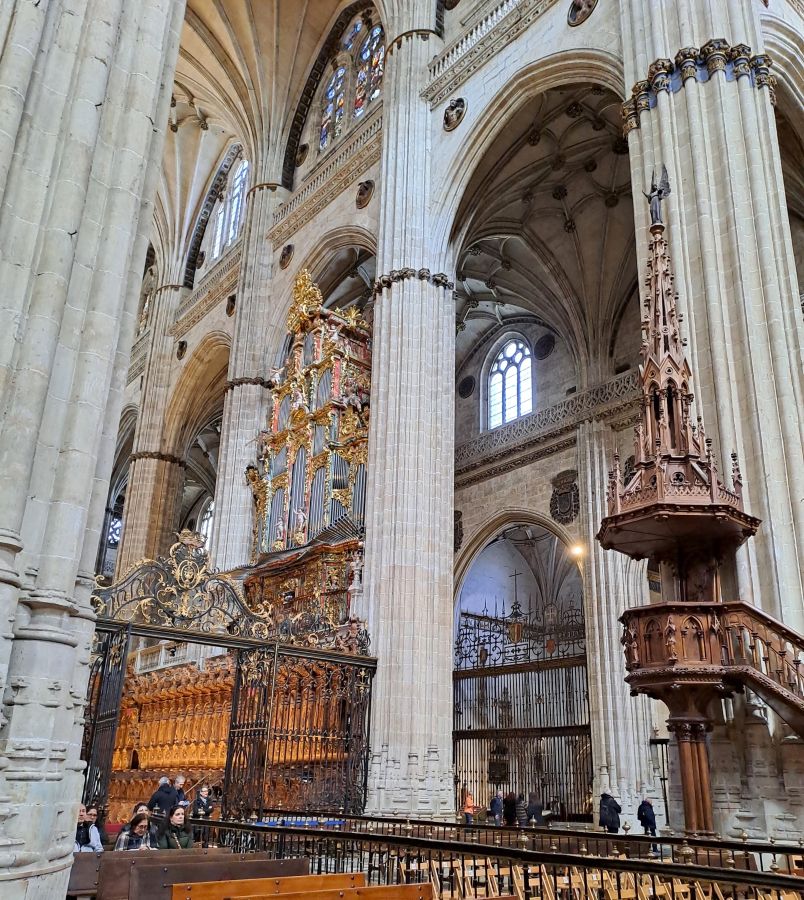
The chapels in the nave of the Gospel were all built by Juan Gil de Hontañon.
Chapels in the Gospel nave
The Chapel of Saint Clement, built in 1661, has an altarpiece with paintings of the Virgin of Relief and Saint Clement. Next door is the Chapel of Saint James the Greater and Saint Teresa of Jesus.
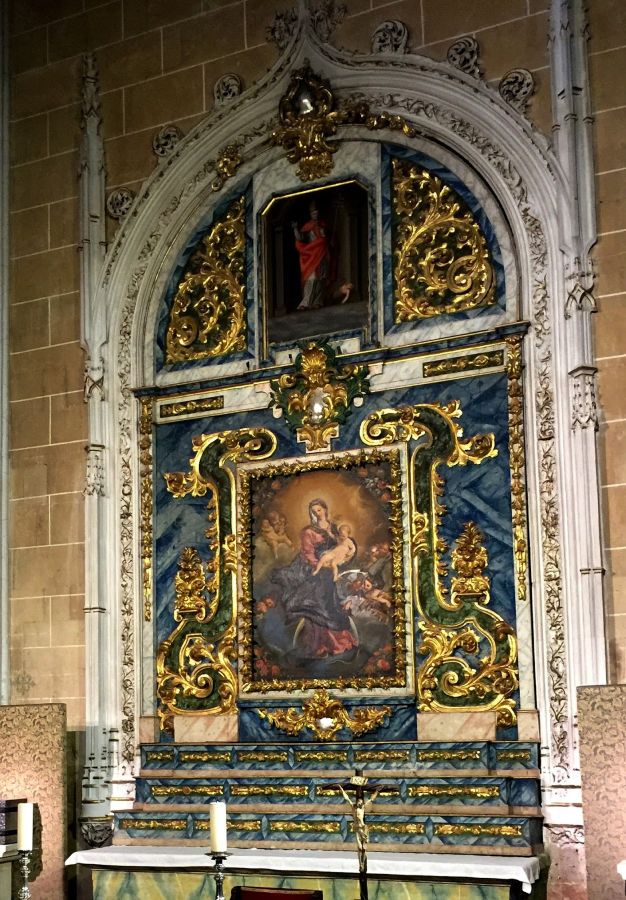

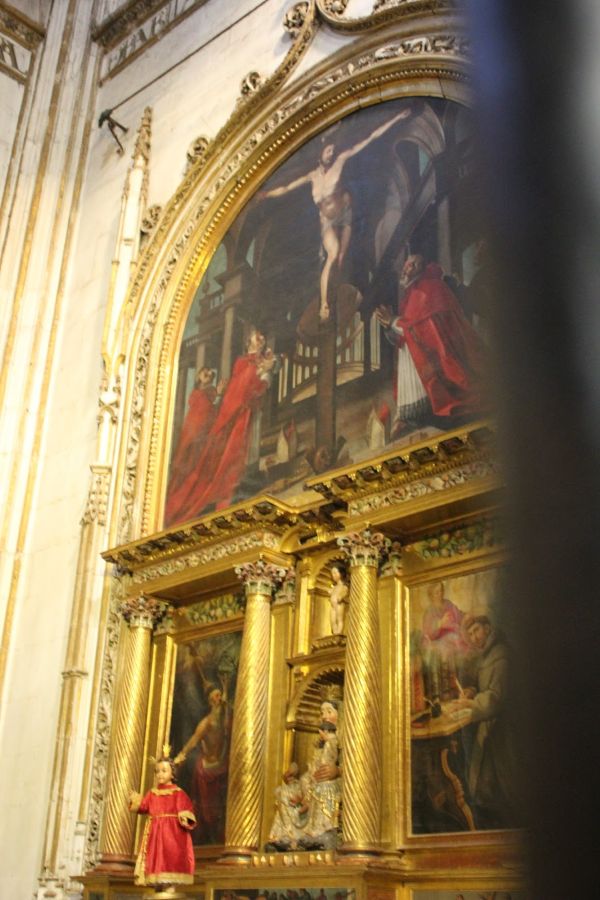
The chapel of Saint Anthony of Padua has an altarpiece and an image of the Franciscan saint from the second half of the 18th century.
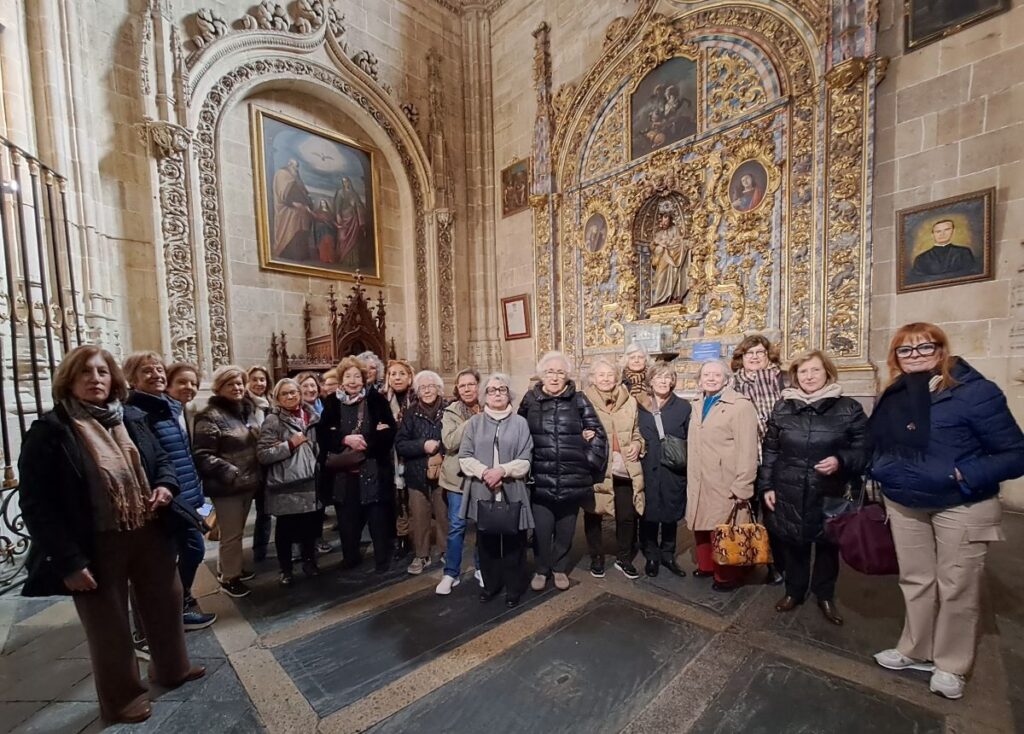
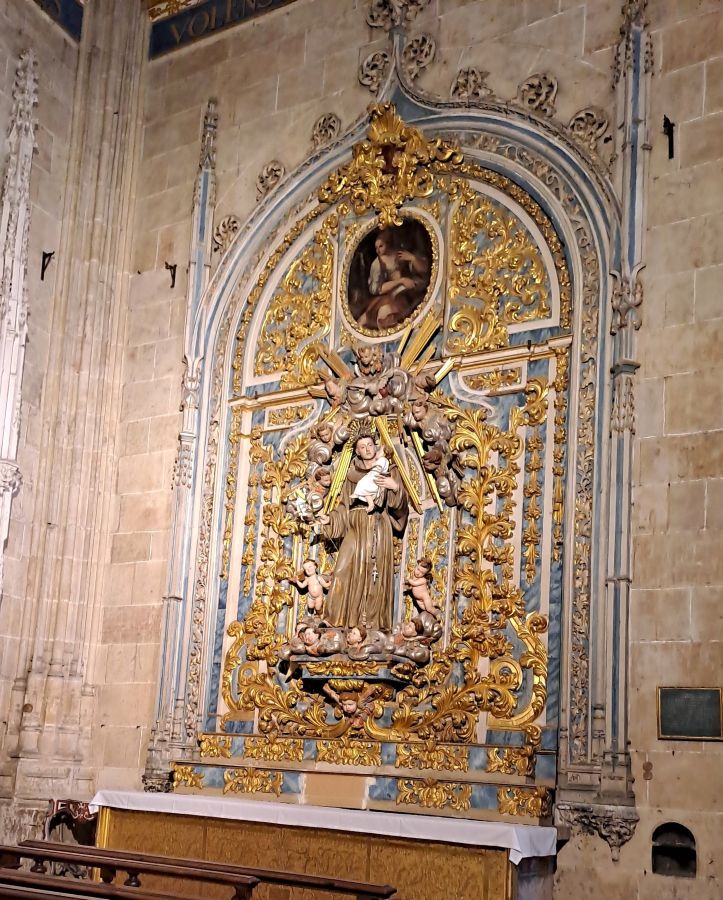
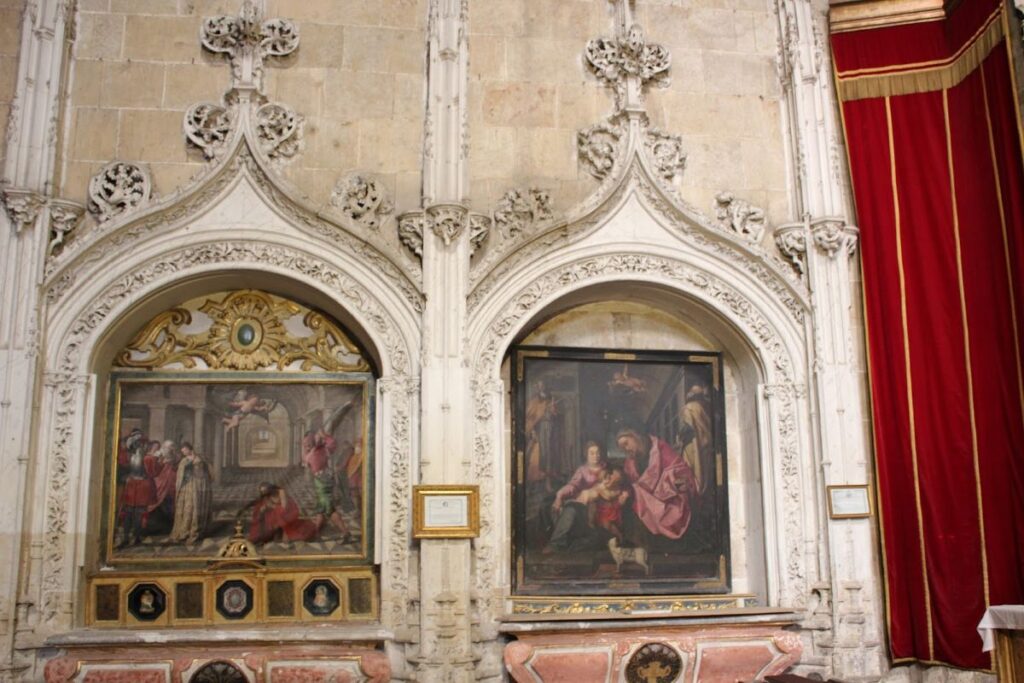
Chapel of Christ of the Agony from the 16th century, in front of the tomb of Bishop Francisco de Bobadilla, who died in 1529. It was he who laid the foundation stone of the New Cathedral.
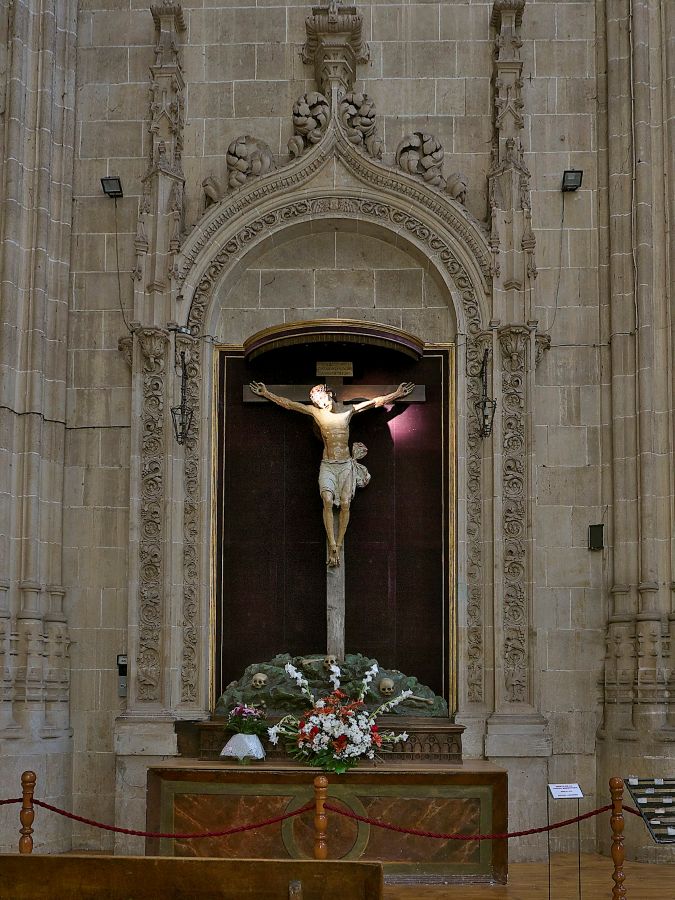
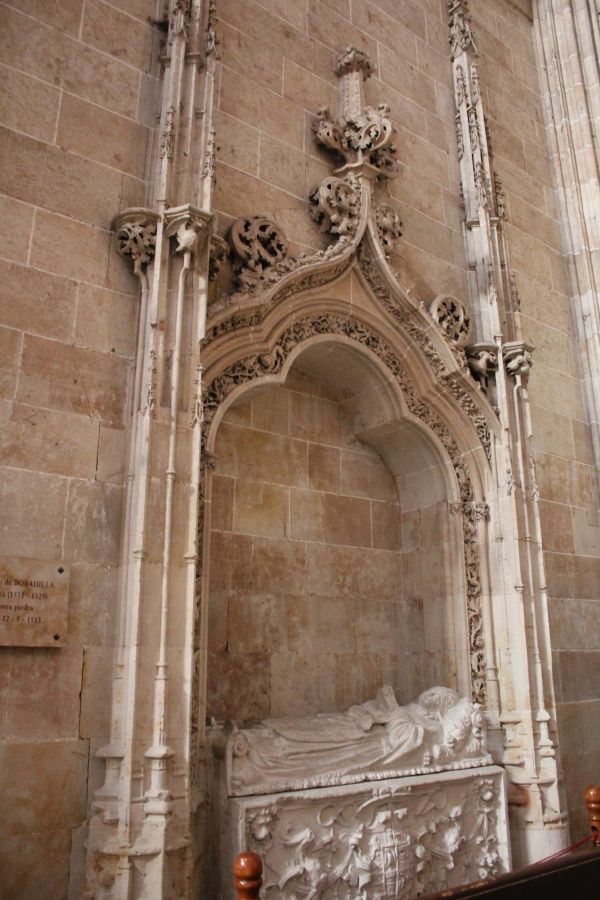
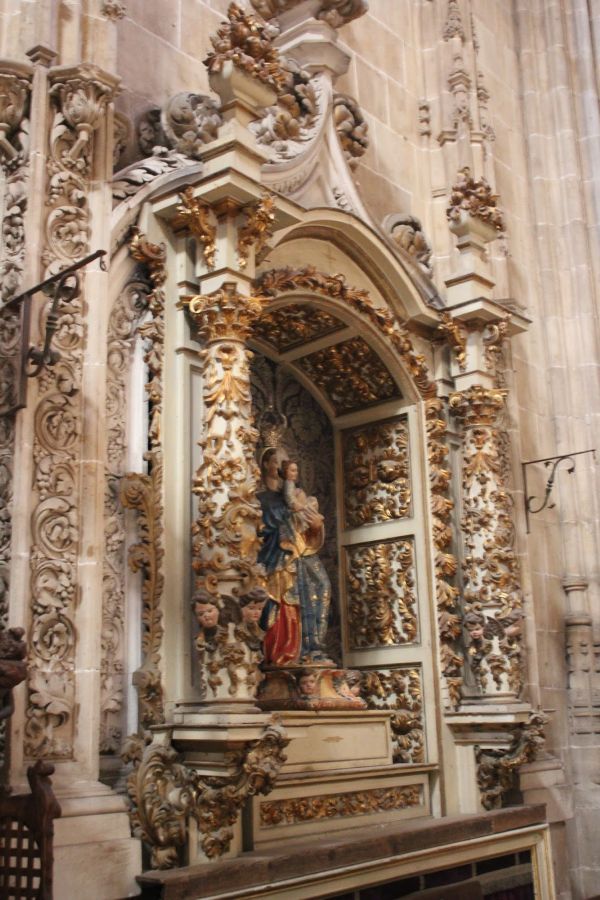
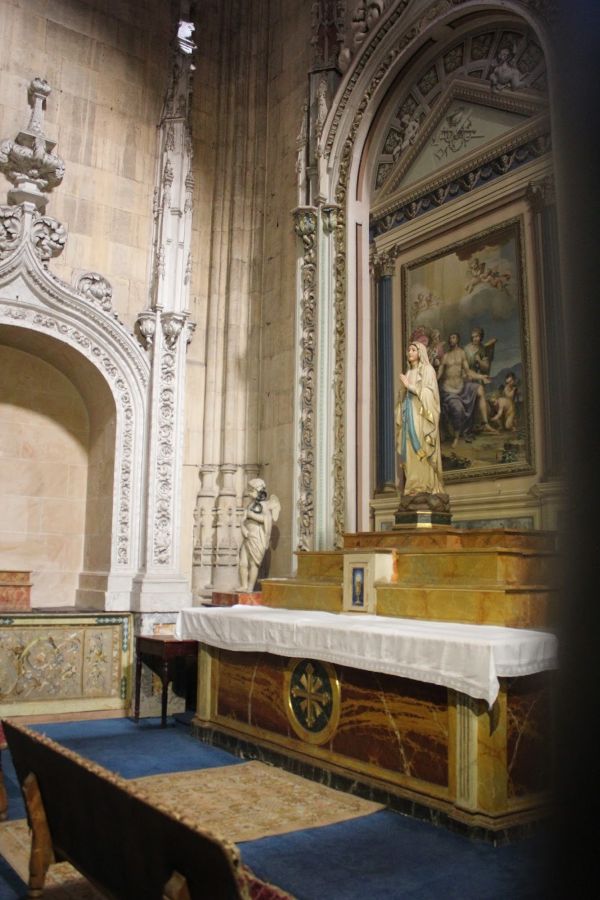
Chapel of the Virgin of the Pillar, with a Gothic sculpture of the Virgin carrying a pillar in her right hand and holding Jesus in her left.
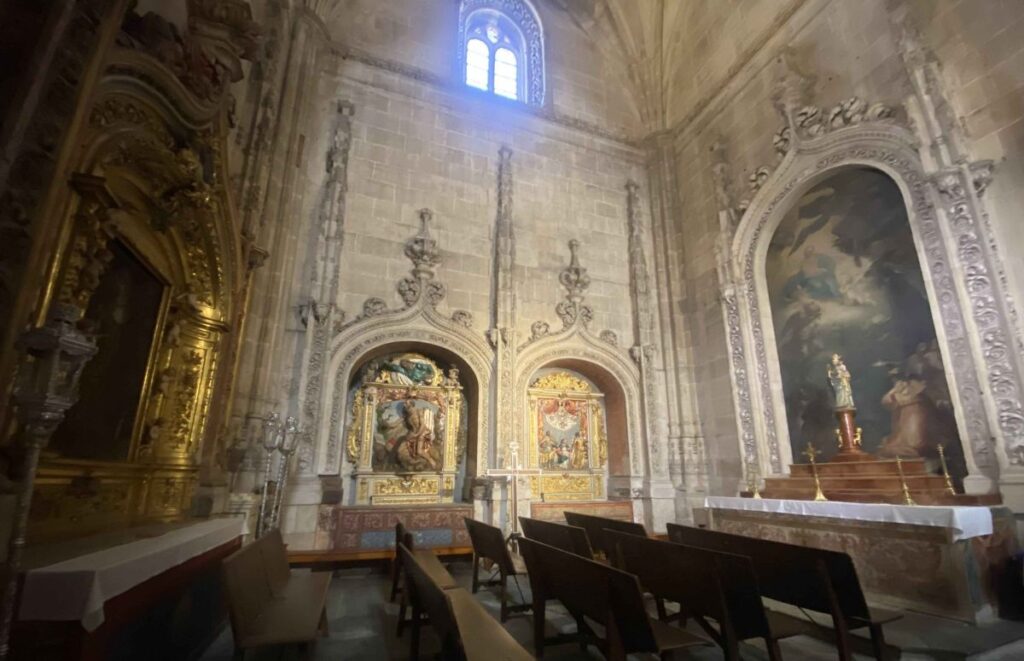
Chapels in the nave transept
Continuing our tour of the cathedral, we reached the chapels of the transept nave of the chancel, with a beautiful Gothic vault, where in the Chapel of Our Lady of Solitude, with a beautiful Baroque altarpiece by Joaquín Churriguera, a team was carefully arranging the Virgin’s vestments.
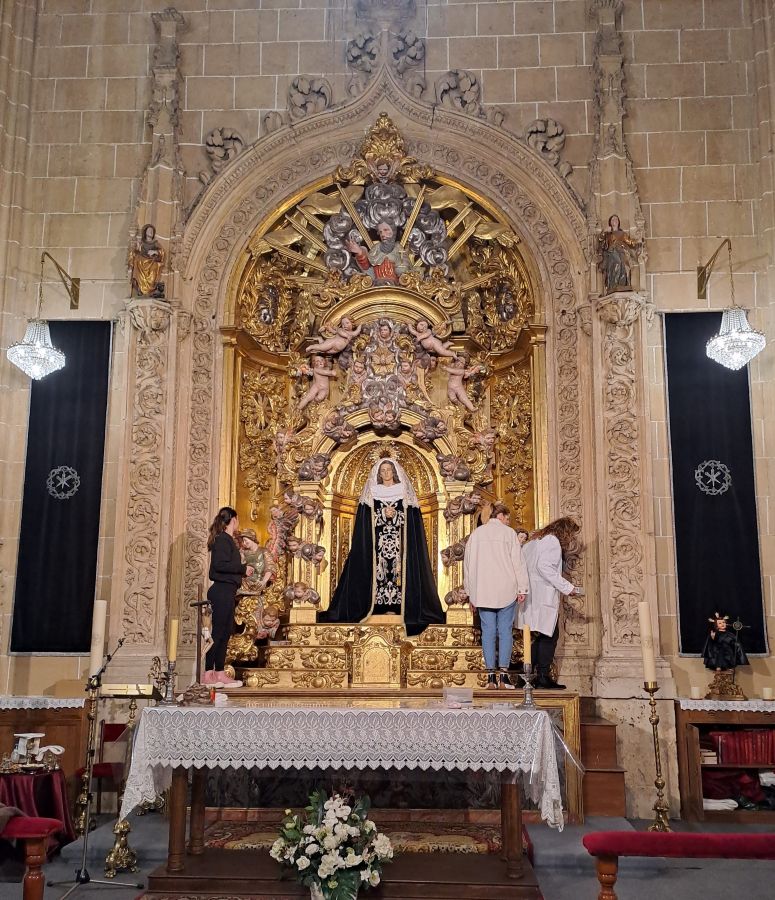
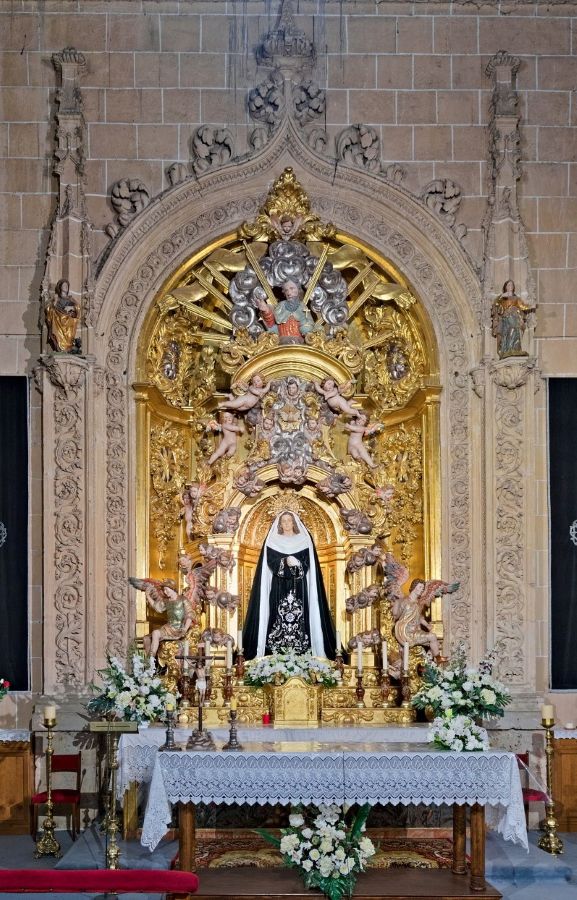
Chapel of the Holy Christ of Battles, with a Baroque altarpiece from the first half of the 18th century by Alberto de Churriguera. The name comes from the small Romanesque crucified Christ from the 12th century that is said to have belonged to El Cid and carried Bishop Jerónimo in his battles against the Muslims. This chapel also houses the Virgin of Carmel, the work of Antonio de Paz.
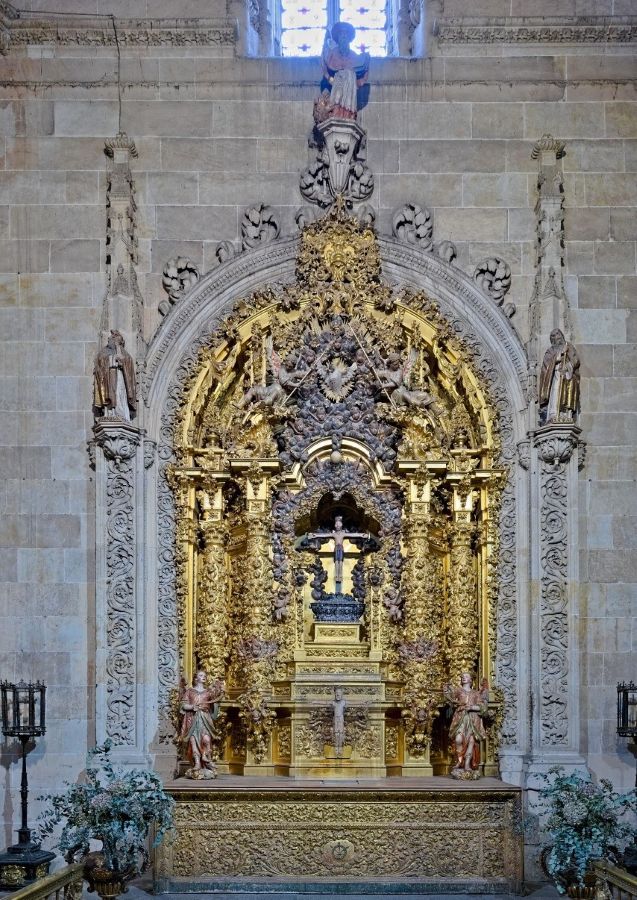
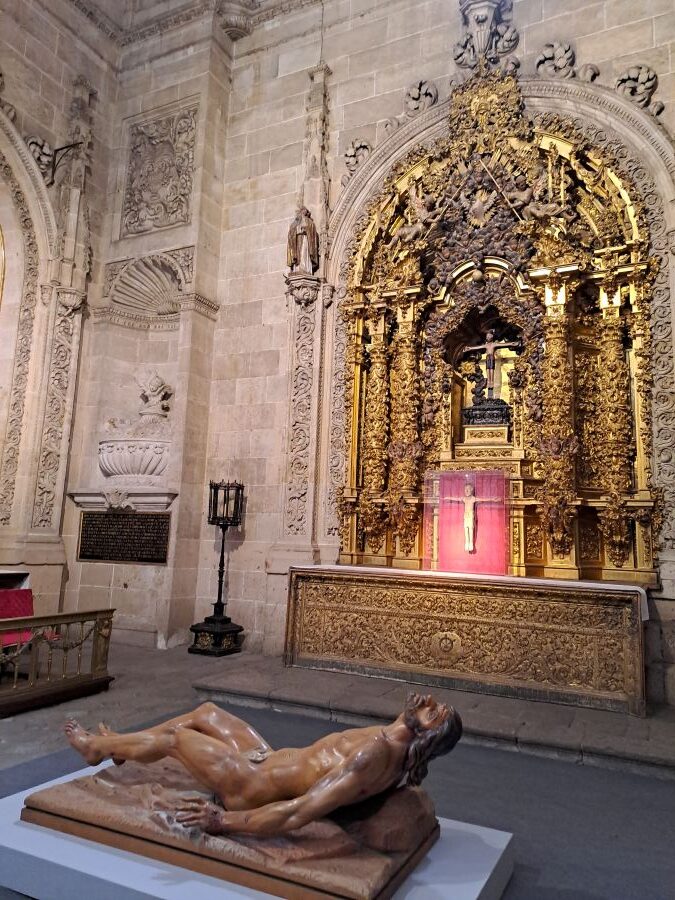
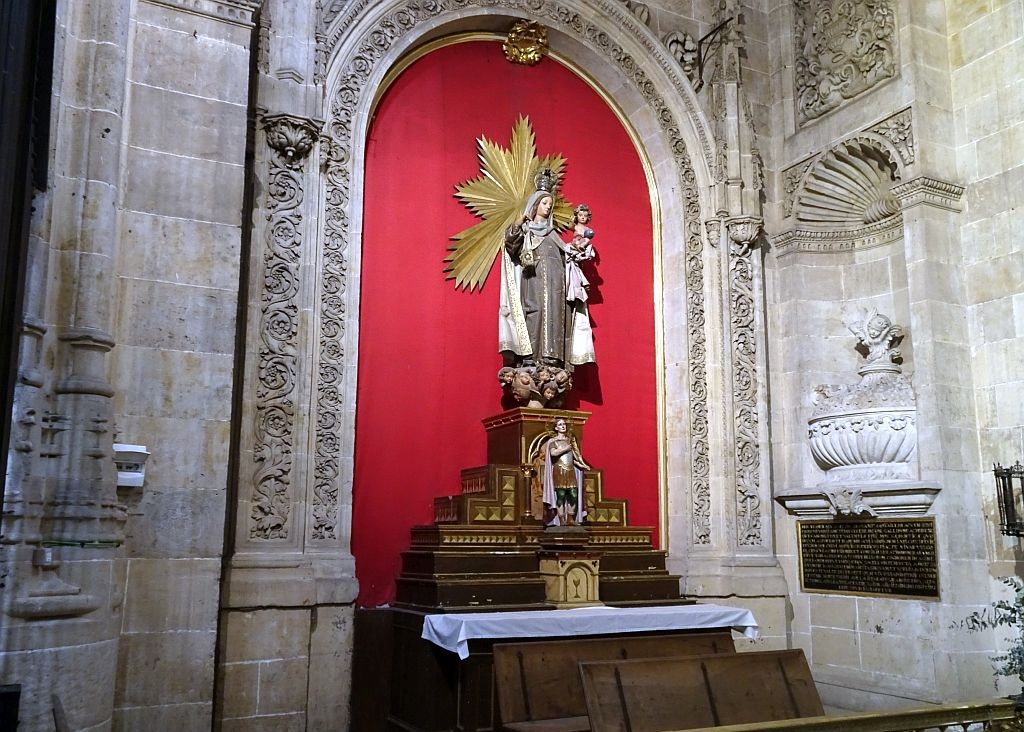
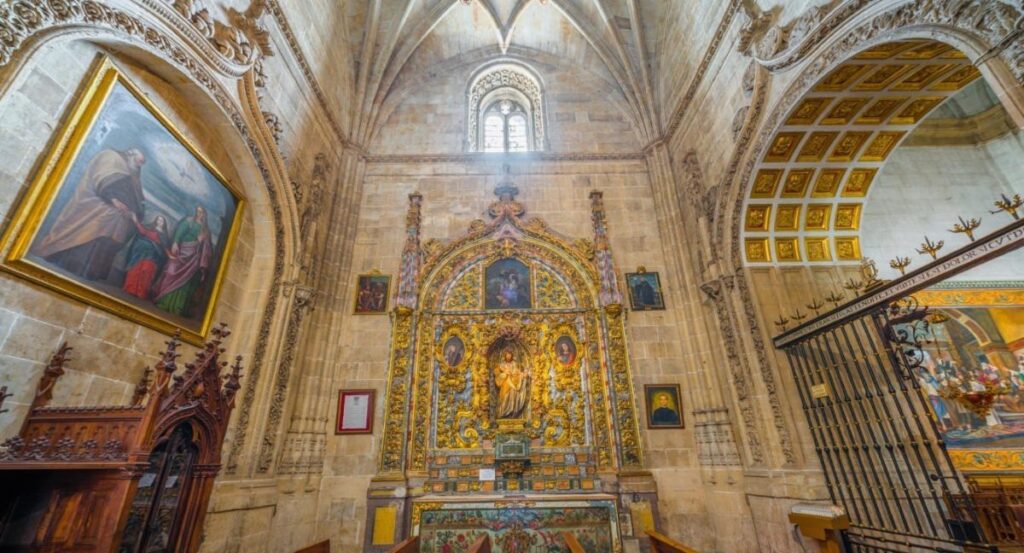
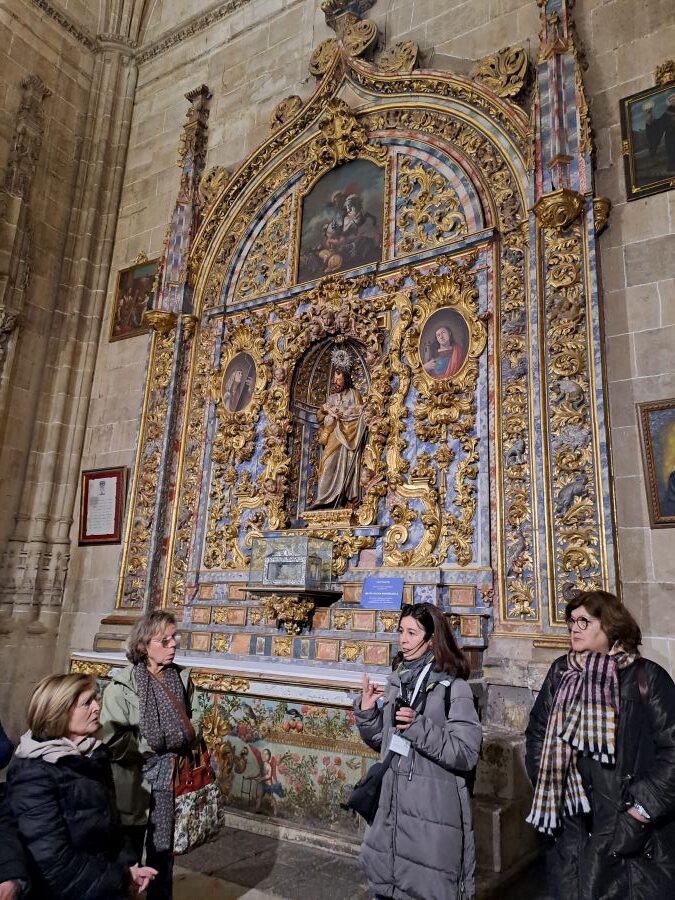
Chapel of Pity or Our Lady of Sorrows – next to the chapel of Saint Joseph, separated by a railing, with a neoclassical altarpiece by Juan Sagarvinaga, crowned with the image of God and angels. The sculpture of the Virgin, by Luis Salvador Carmona, dates from 1760.
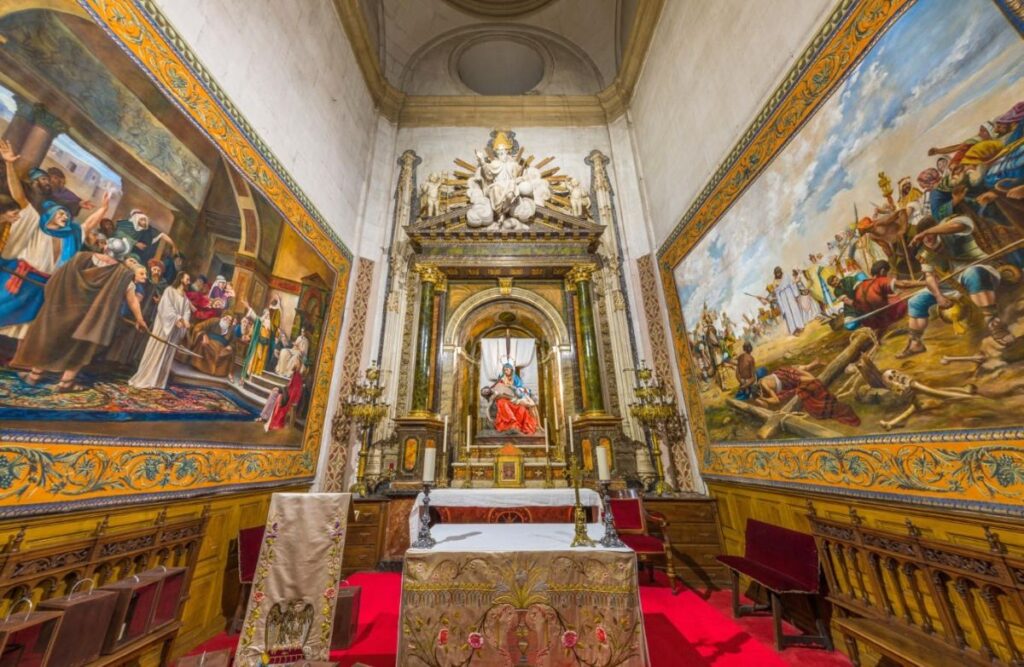
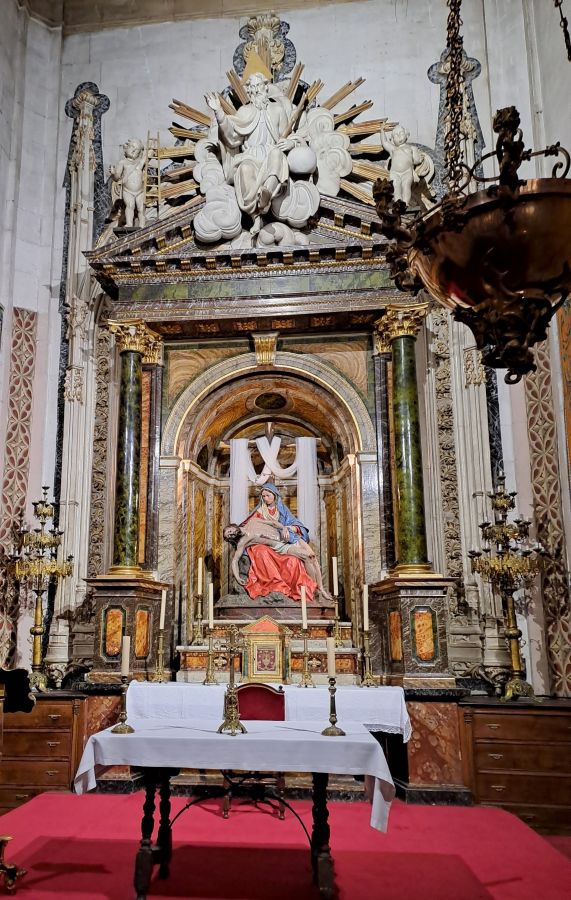
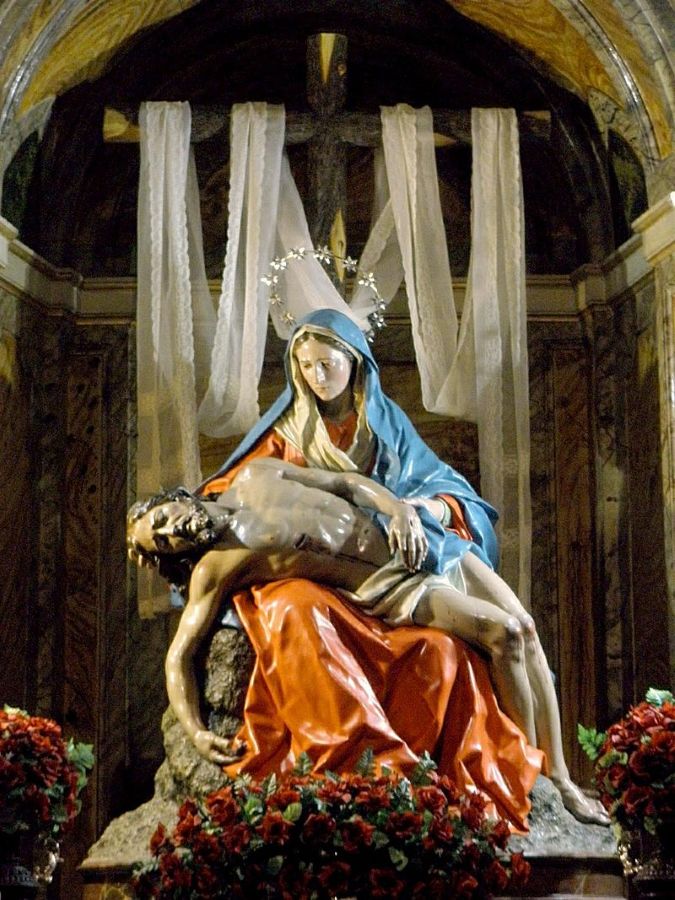
Chapels of the Epistle
Then there are the chapels on the Epistle side. The Chapel of Saint Nicholas of Bari (below) has two altarpieces, a baroque one dedicated to Saint Nicholas and a neoclassical one dedicated to the Immaculate Conception.
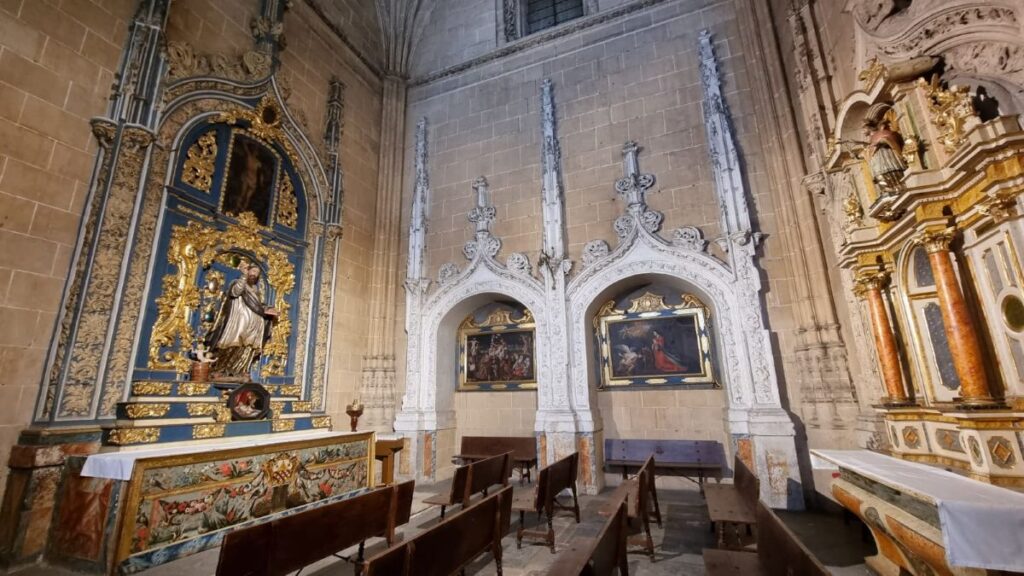
Chapel of the Nazarene – has the best collection of Italian paintings in the whole cathedral, with an altarpiece of Christ with the Cross on his back and Veronica by Carlo Maratta, and above it the penitent Magdalene by Romanelli. In the arches, ‘The Slaughter of the Innocents’ and ‘The Expulsion of the Merchants from the Temple’, attributed to Micco Spadaro, both recently restored.
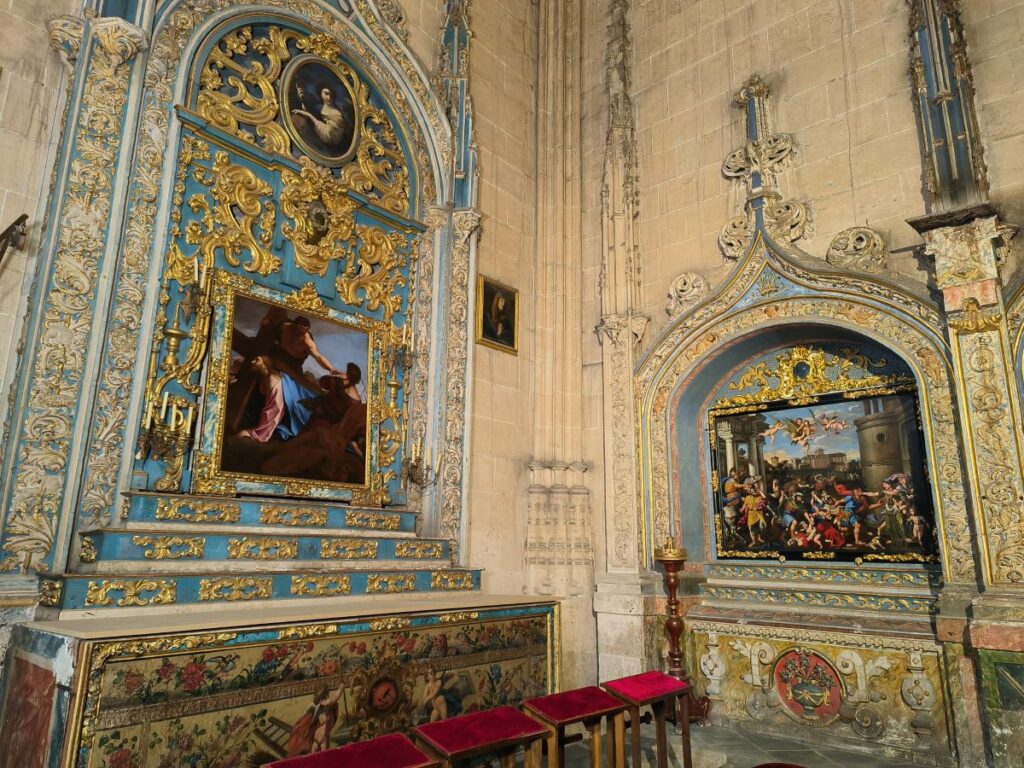
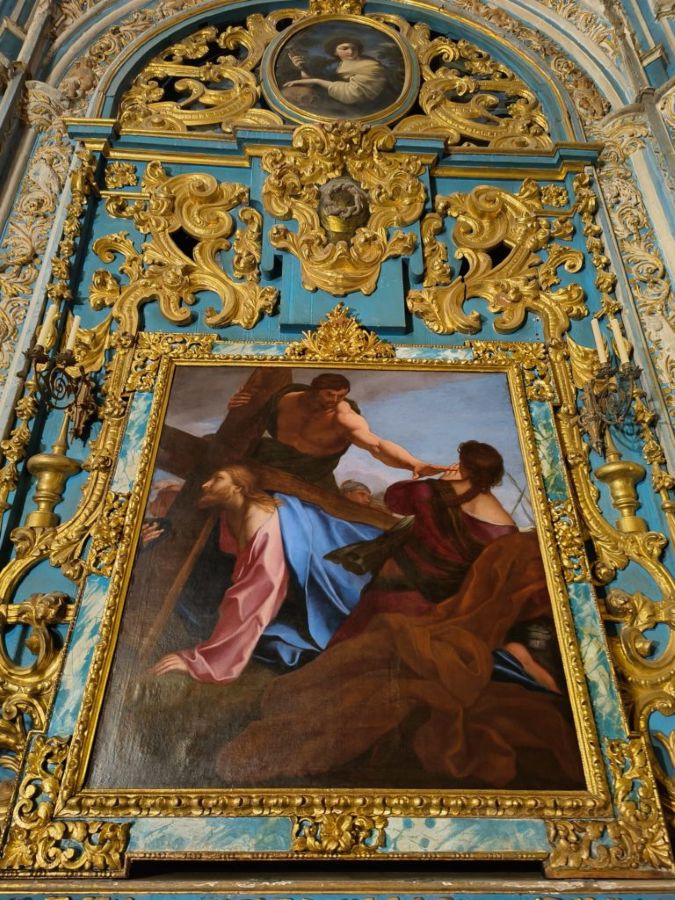
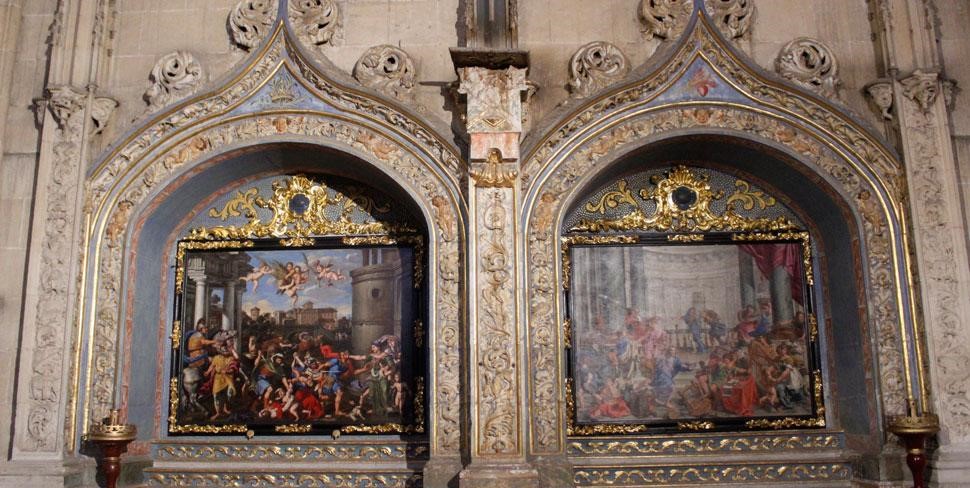
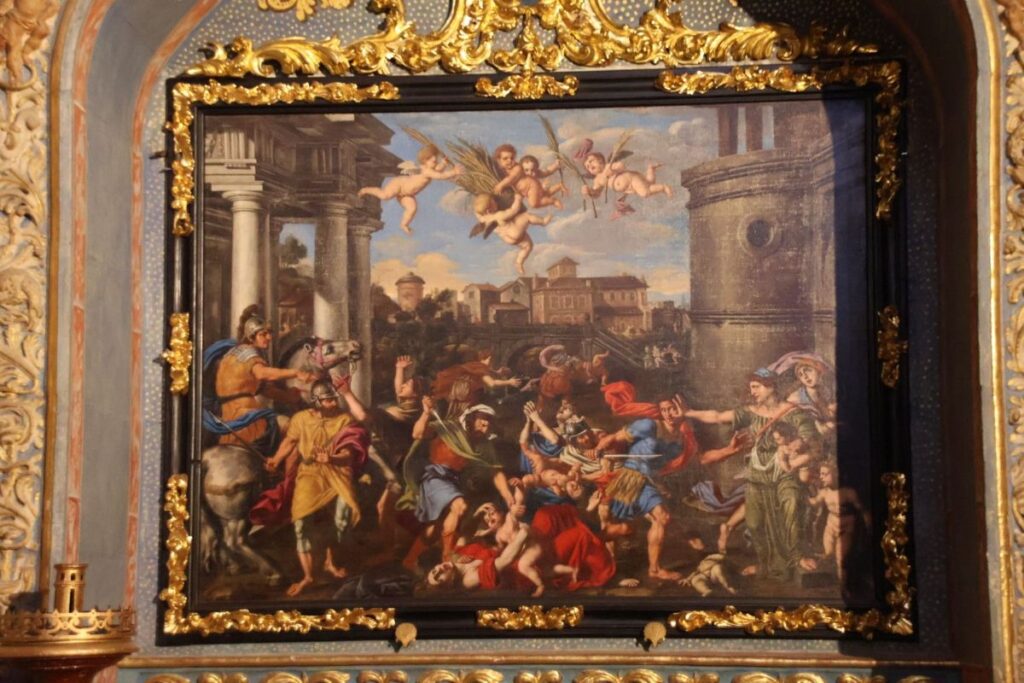
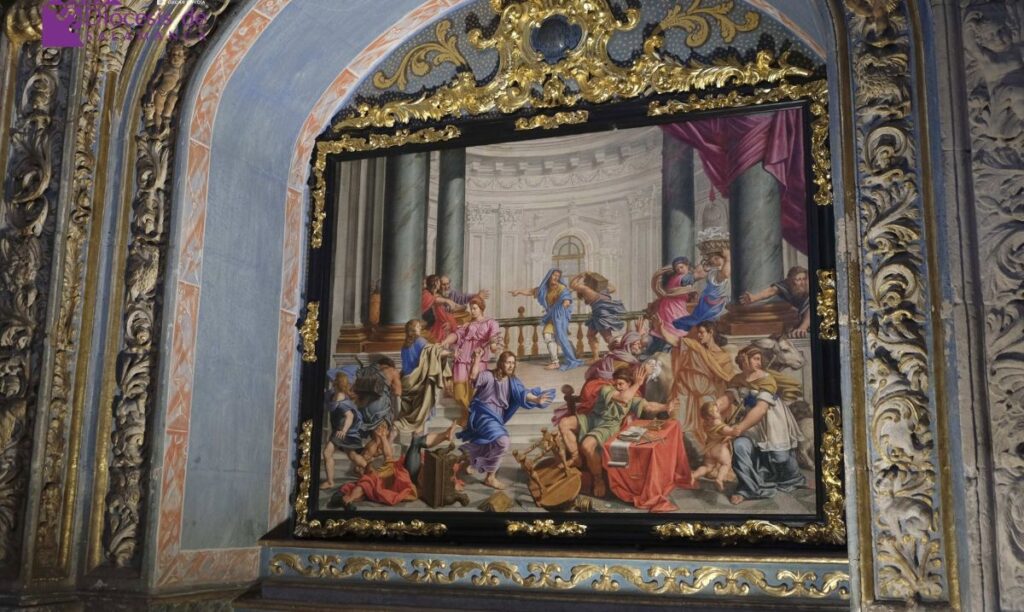
The Chapel of the Virgen del Desagravio (Virgin of Disgrace), below left, was built in 1664 as an act of atonement to house a canvas of the Immaculate Conception that had been outraged by opponents of the Dogma of the Immaculate Conception.


The Chapel of Saint Bartholomew, above right, is topped by a painting of the Virgin with Jesus and Saint Juanito by Luis de Morales.
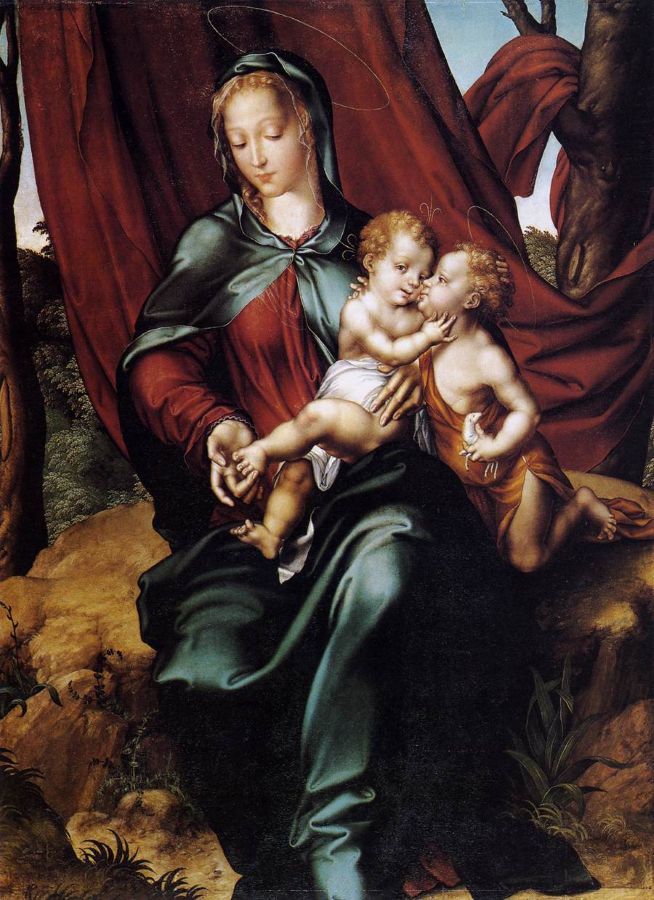
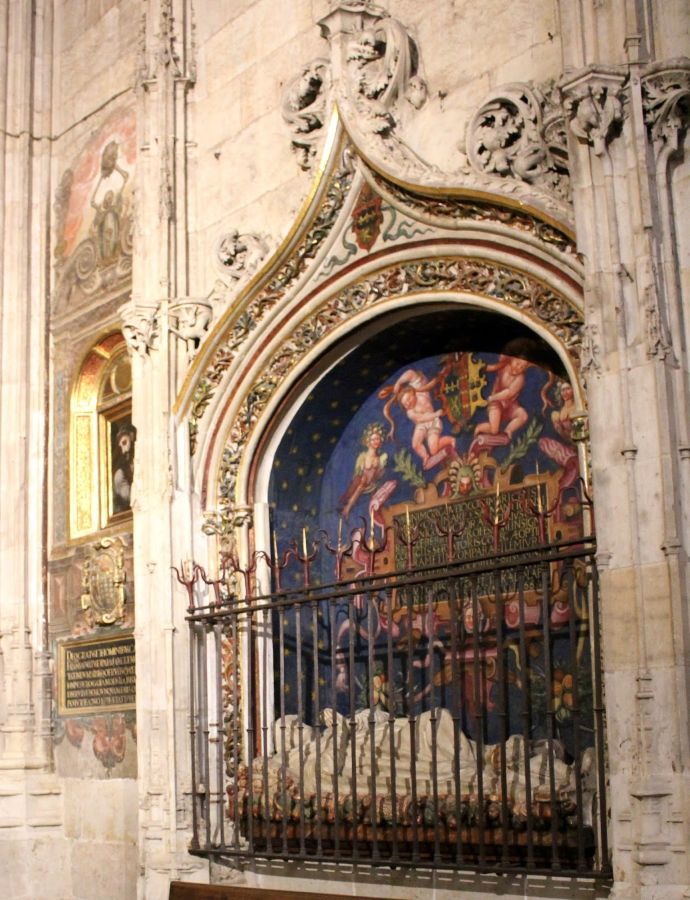
The Golden Chapel, or All Saints’ Chapel, is famous for its impressive altarpiece and the exquisite golden decoration that gives it its name. Built in the 15th century, in 1515, this chapel, the work of Juan de Álava, is an exceptional example of the Gothic style, with a design that includes columns, arches and 110 detailed sculptures depicting scenes from the Old and New Testaments, the Virgin and the saints.
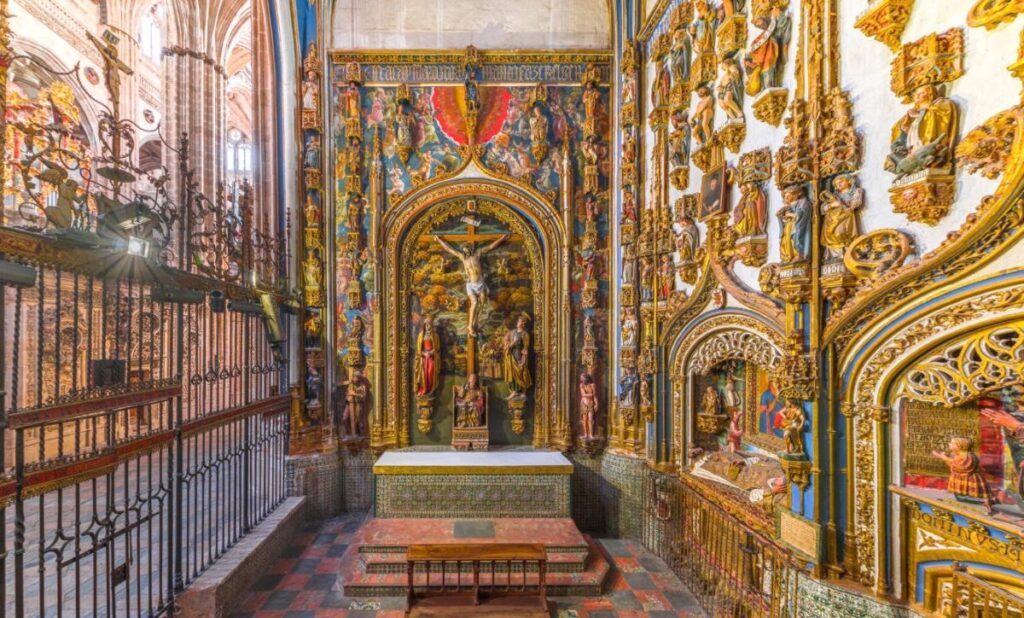
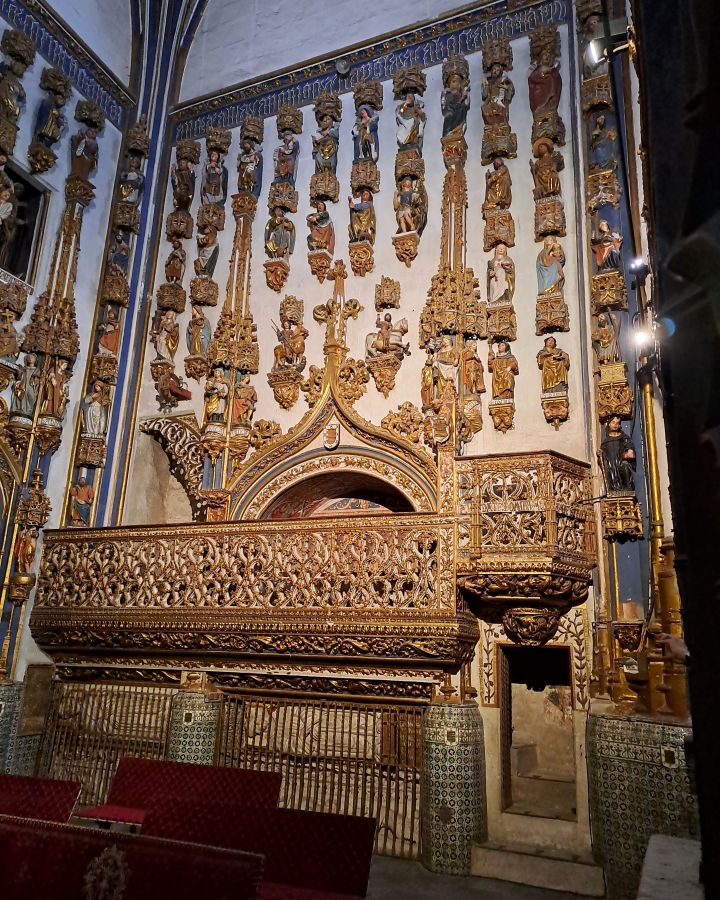
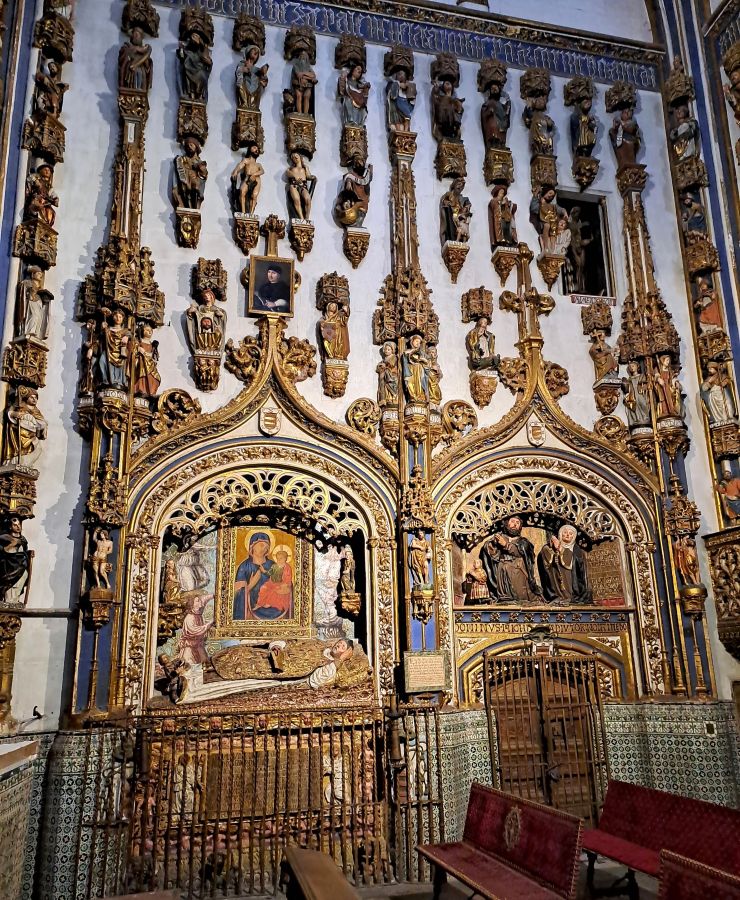
Chapel of the President, with a precious altarpiece with detailed gilding and religious art paintings by Fernández Navarrete, 18th century.


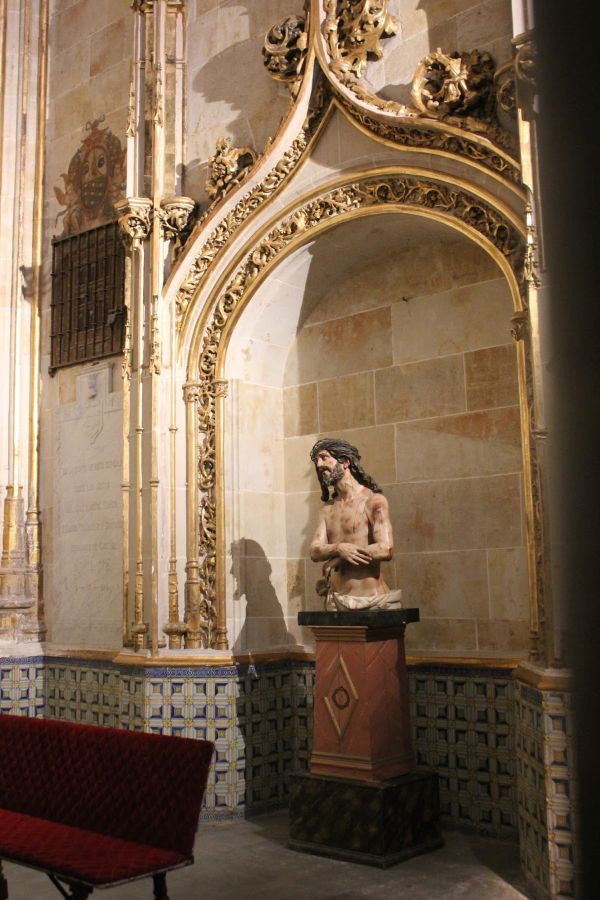
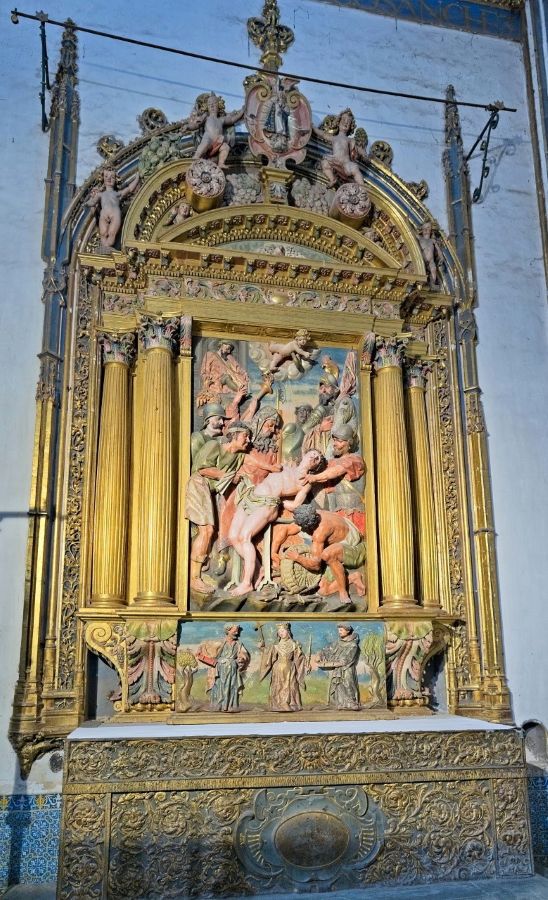
Old Cathedral
Salamanca’s Old Cathedral, or St Mary’s Cathedral, was founded by Bishop Jerónimo de Périgord. Built between the 12th and 13th centuries in the Romanesque style, it is dedicated to Saint Mary of the Thirst. Romanesque in design throughout, the building is covered in vaults in a transition to Gothic, making the cathedral a beautiful blend of the two styles. From the beginning of its construction, the temple was designed for both religious and defensive purposes, with a distinctive character of a crenellated fortress, and a first defensive bastion had to be built in the south tower. The church has a Latin cross plan, three naves, three apses and a transept with a dome. Part of the transept was destroyed for the construction of the New Cathedral.
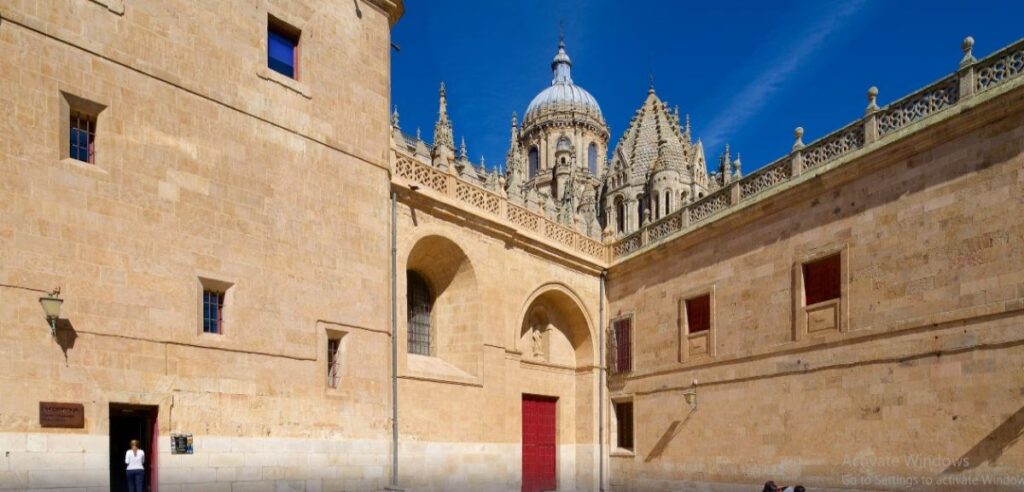
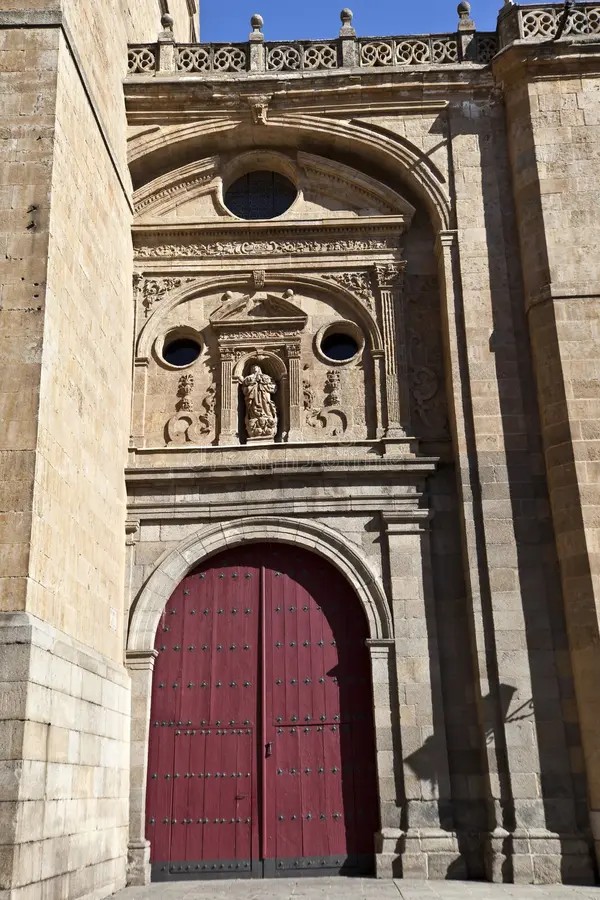
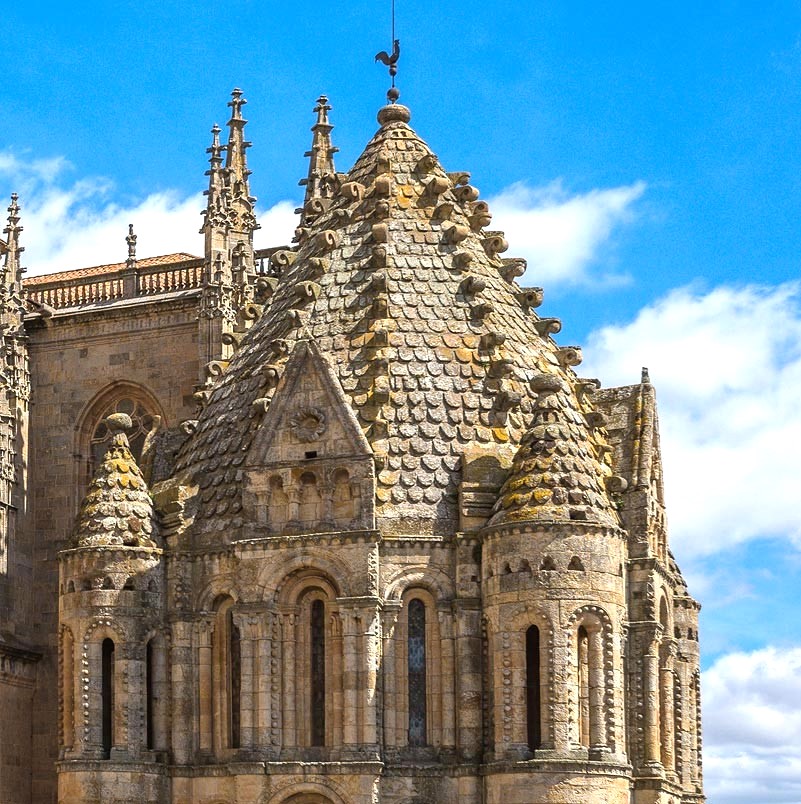
Rooster’s Tower – a beautiful dome built around 1150, it has a conical shape and rests on an octagonal drum with sixteen columns, illuminated by thirty-two windows and decorated with scales. It is crowned by the rooster-shaped weather vane from which it takes its name.
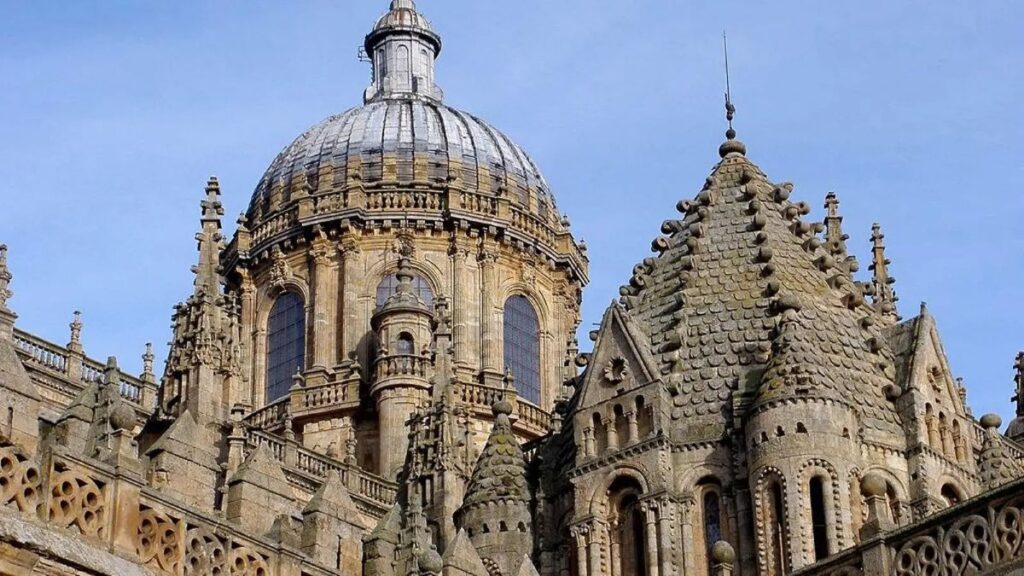
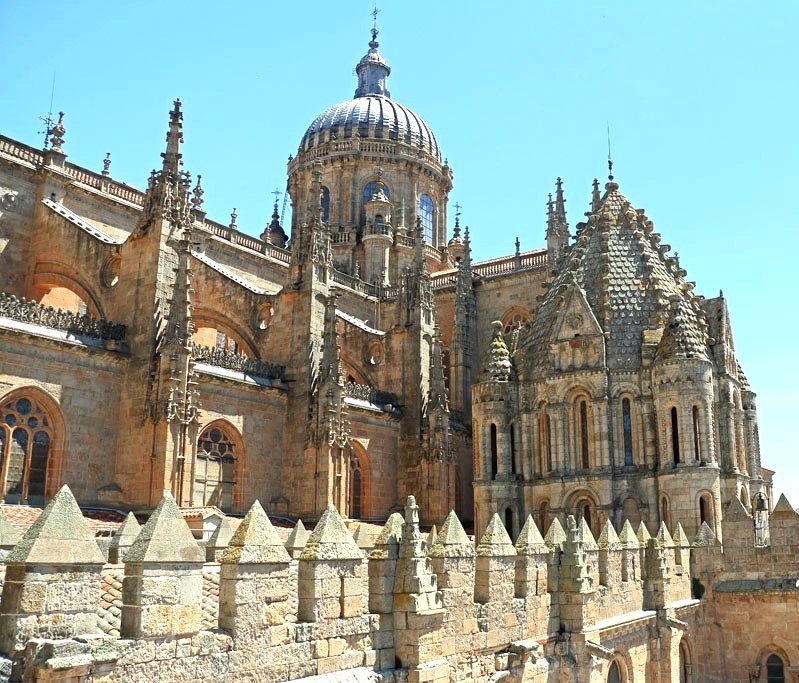
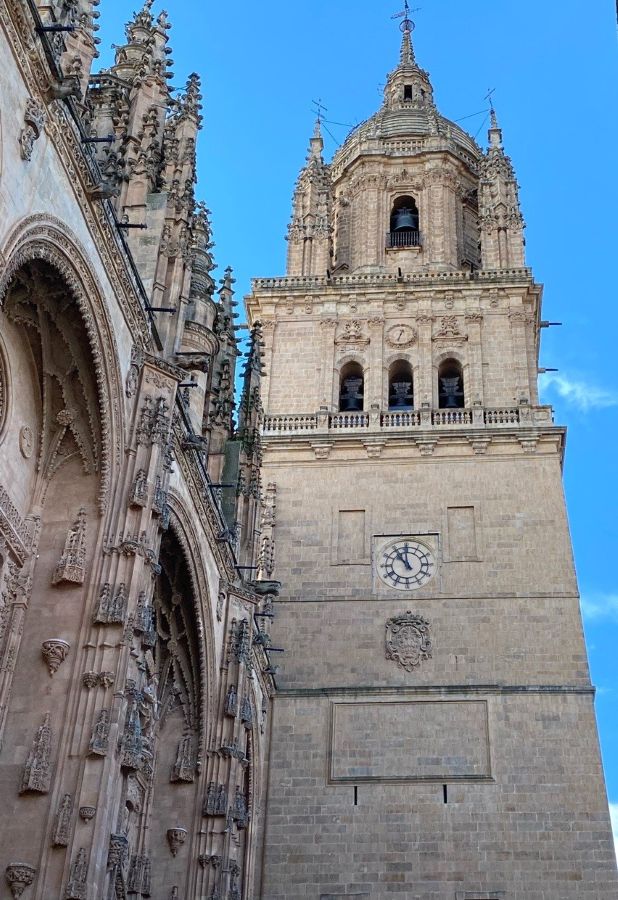
The Old Cathedral of Salamanca also has the Bell Tower, on the north side, with a square floor plan, shared by the two cathedrals of Salamanca and used for surveillance purposes, and the Mocha Tower, on the south, topped with battlements and used for defence purposes. The earthquake that struck Lisbon in 1755 caused damage throughout the Iberian Peninsula and ruined the Bell Tower, which had already been damaged by a fire in 1705, so it had to be reinforced and slightly tilted.
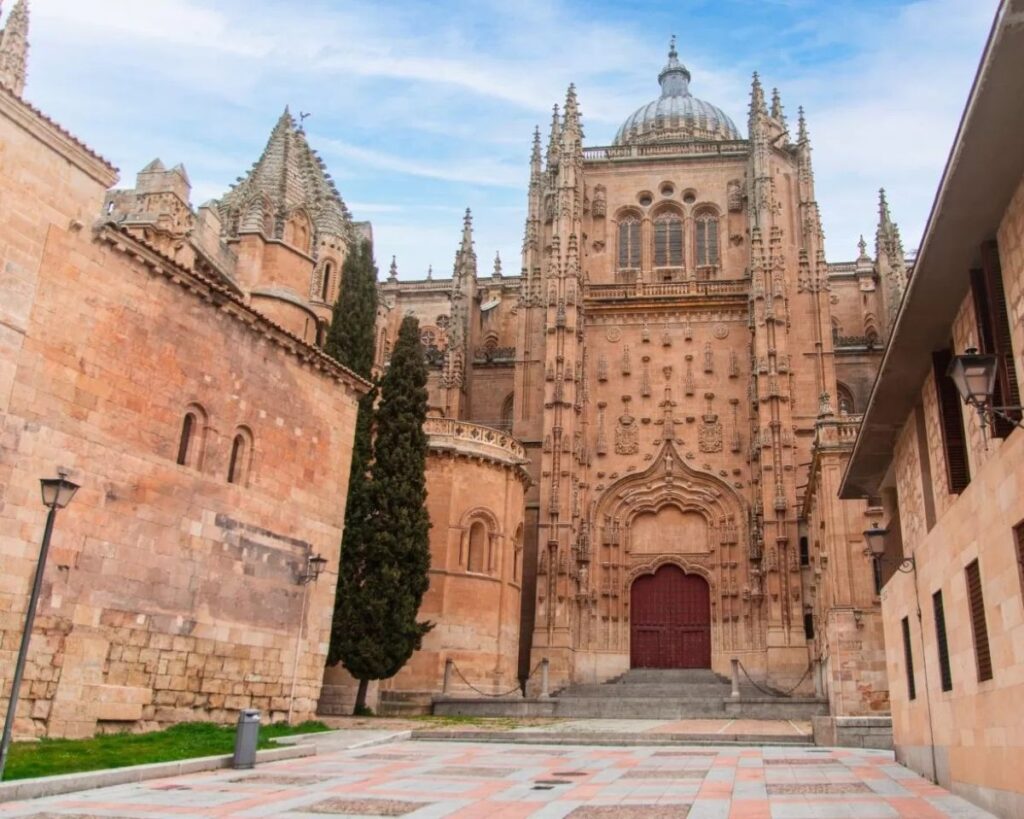
The main facade of Salamanca’s Old Cathedral has lost some of its artistic value due to the major remodelling that took place in the temple during the 17th century.
Main Chapel
In the main chapel is the marvellous altarpiece by the Delli brothers, which occupies the same spot for which it was originally designed and visually recounts some of the main episodes in the History of Salvation, from the birth of the Virgin to her coronation, all of which is followed by the Last Judgement. The altarpiece is made up of fifty-three panels, distributed in eleven rows and five bodies or heights, in order from bottom to top and from left to right. In the fourth sphere, the Last Judgement crowns the whole.
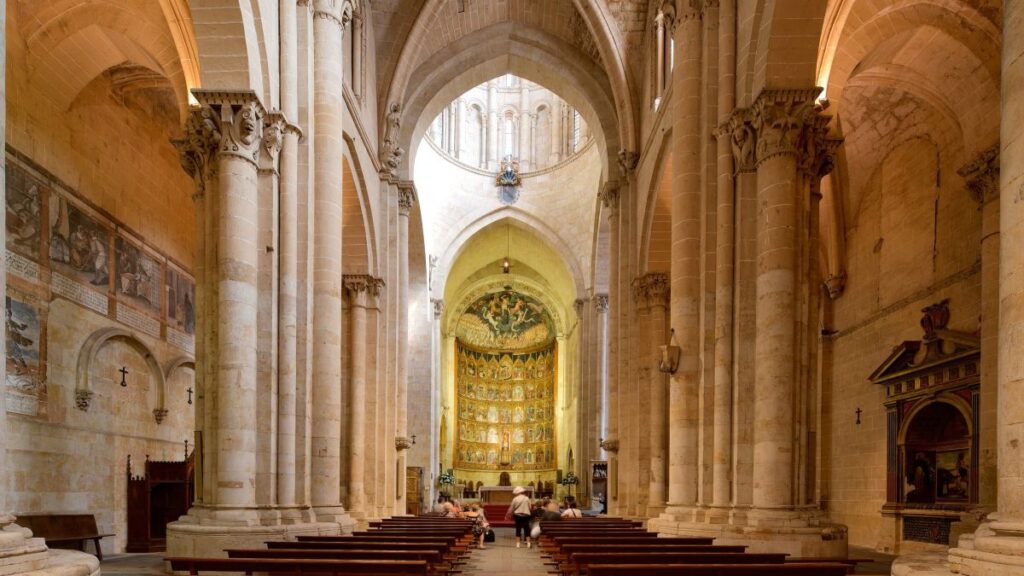
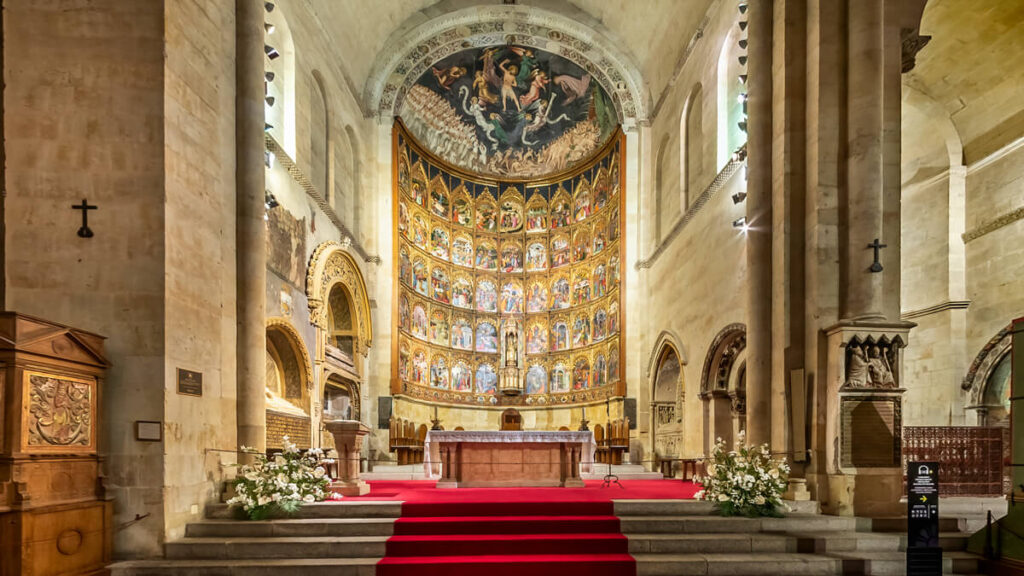
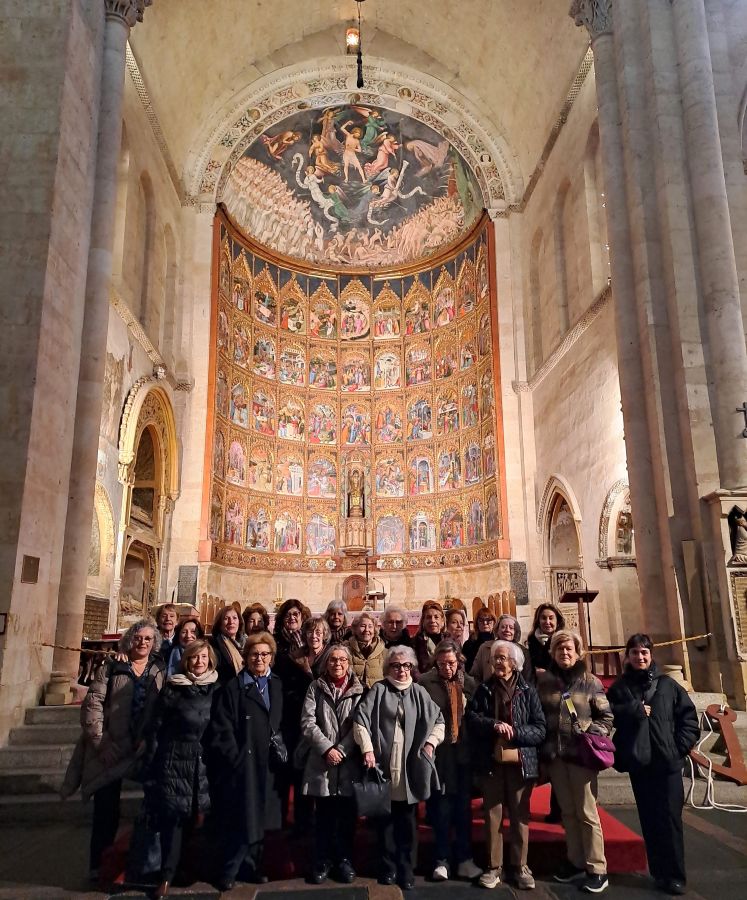
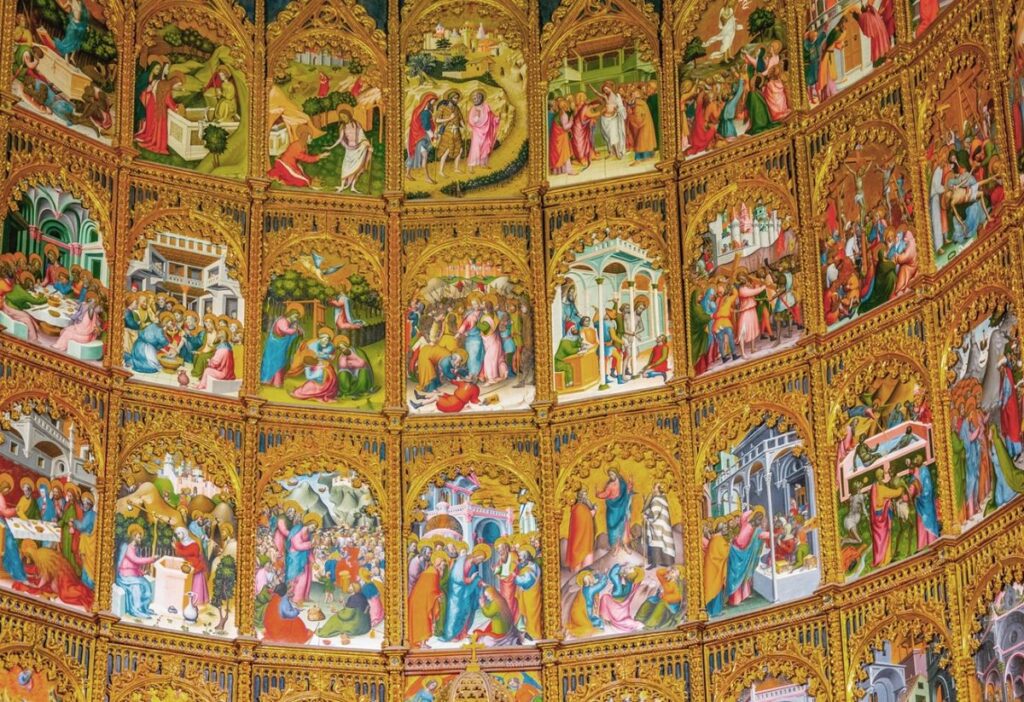
The 12th century image of the Virgin of La Vega, patron saint of Salamanca, is made of wood covered in gilded bronze with inlays of enamel and precious stones, the fruit of donations from the Salamancans. It has presided over the altarpiece since the mid-20th century.
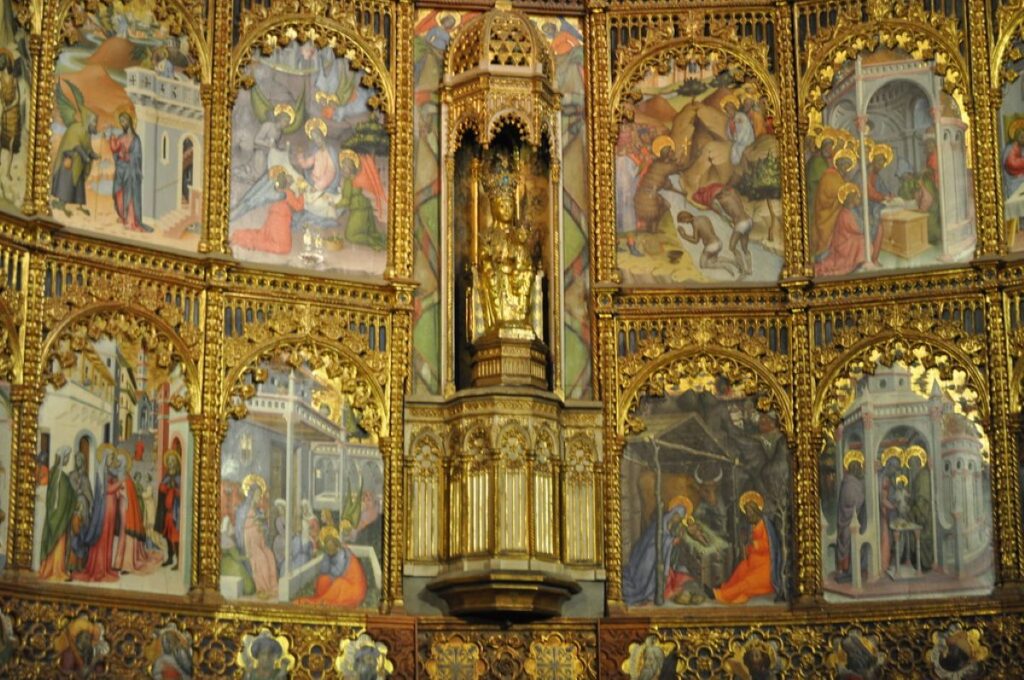
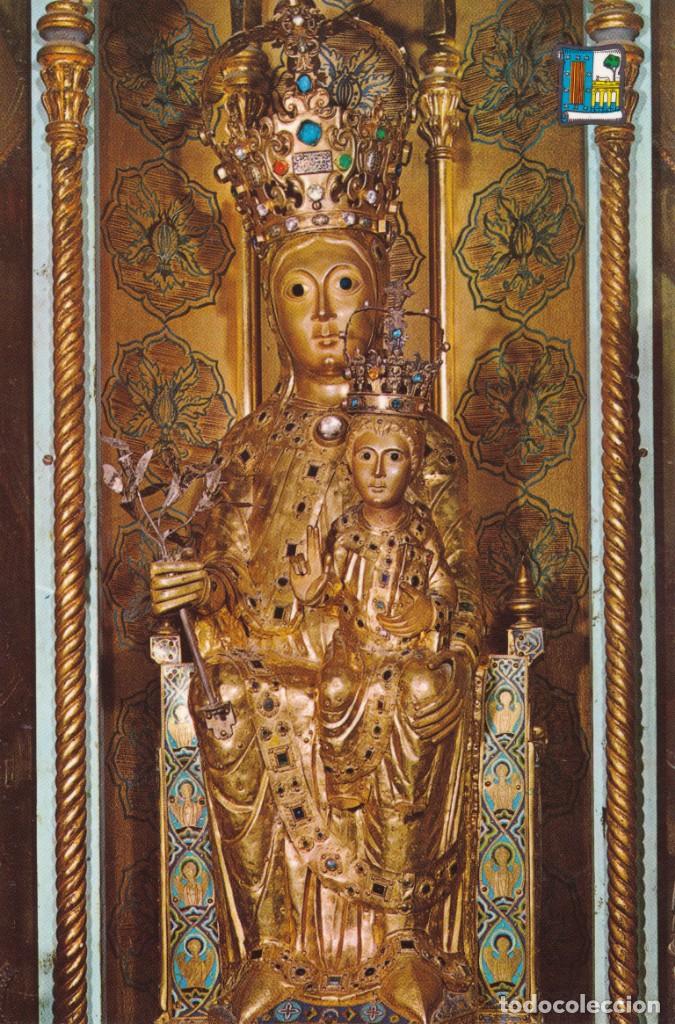
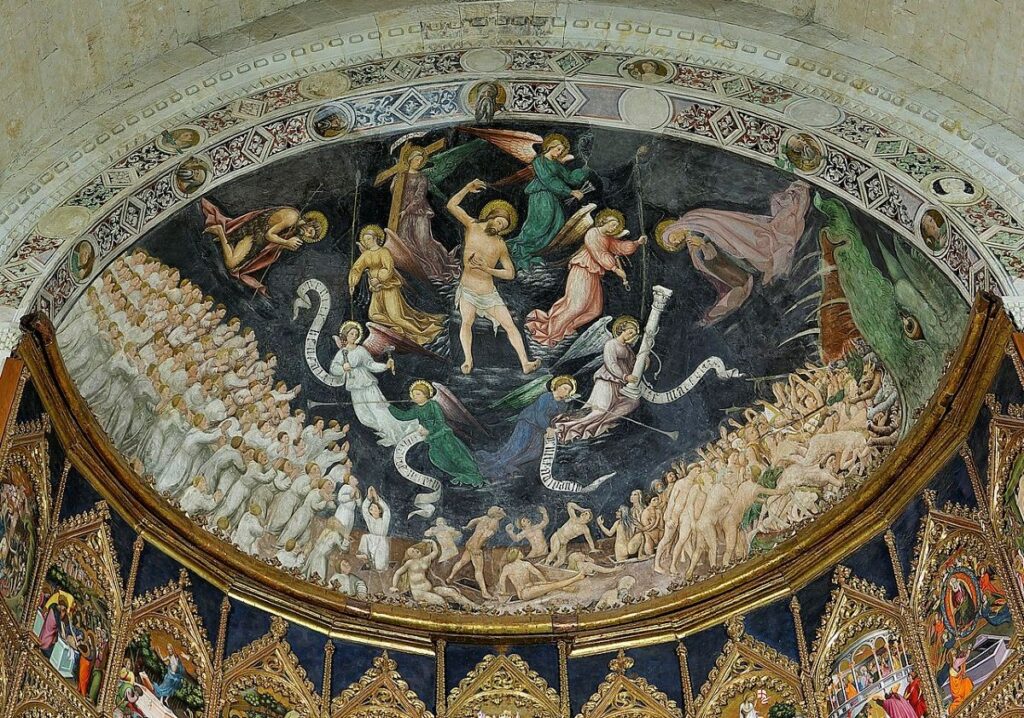
At Jesus’ feet, we see the Virgin Mary and John the Evangelist on their knees. To their right, the saved dressed in white and, to the left, the naked condemned who seem to be walking towards the mouth of a giant monster. The altar of Saint Mary the White, on the side wall, has frescoes of the 18 miracles of Christ of Battles above it (below).
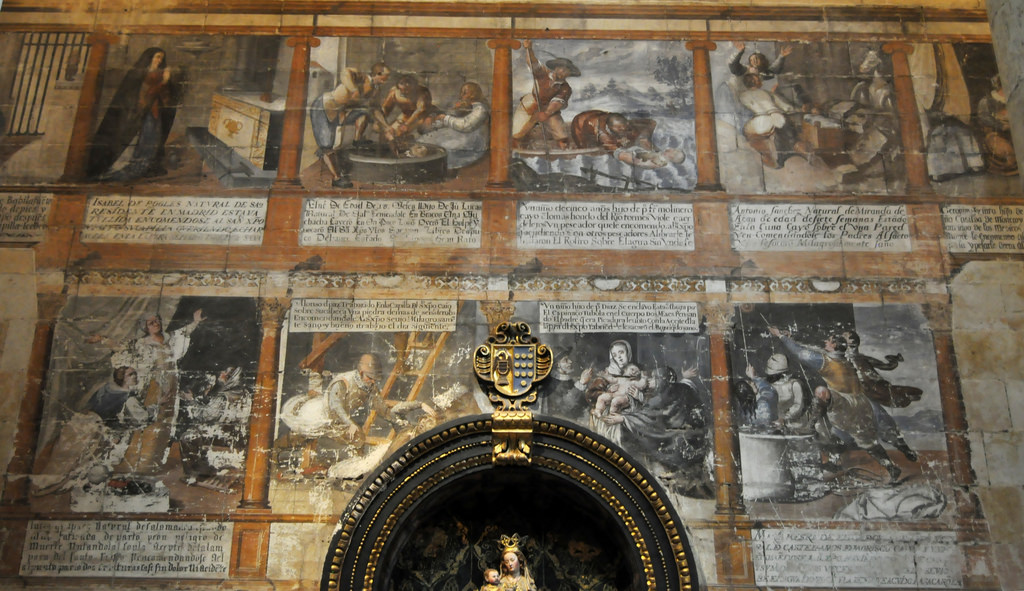

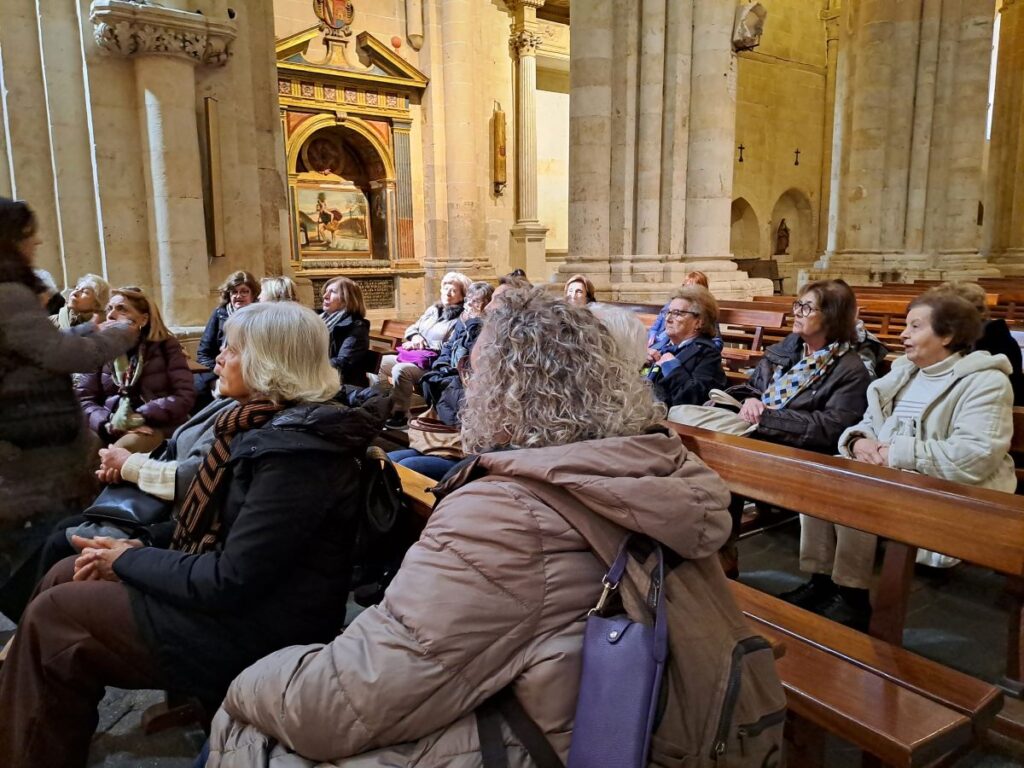
On the side walls of the altarpiece, on both the Gospel and Epistle sides, there are tombs of illustrious personalities and relatives of kings, some of them in arcosolium.
Chapels
The Chapel of Saint Martin, also known as the Chapel of Olive Oil (it was once converted into an olive oil warehouse), is located in the lower part of the Bell Tower on the Gospel side. The outside wall of this chapel has a painting of Saint Martin sharing his cloak with a poor man. But the main highlights are the beautiful Gothic paintings, adorned with shields of the kingdoms of León and Castile, by Antón Sánchez de Segovia, and the false altarpiece around a three-dimensional image of the Virgin Theotokos. You can also find several tombs of bishops, including Bishop Rodrigo Díaz, from 1339, and Pedro Péres, the chapel’s founder.
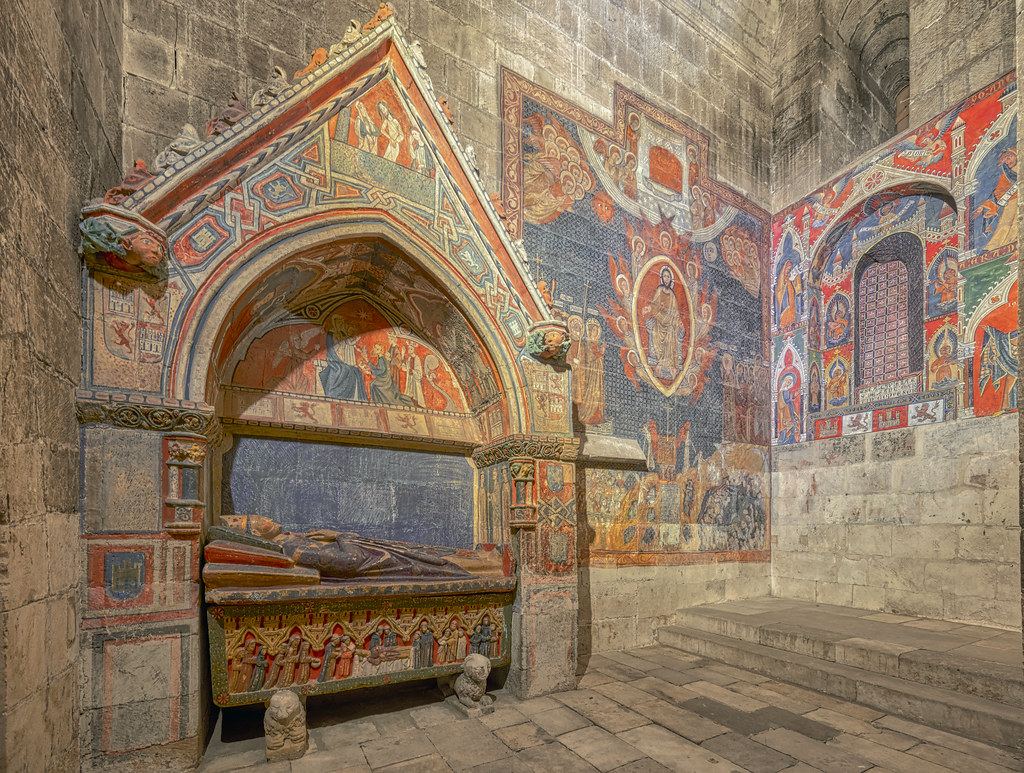
The tomb of Bishop Rodrigo Díez, dating from 1339, in the shape of an arcosolium, with a mural painting of the Adoration of the Shepherds on the emblems of Castile and León, a sarcophagus with a scene of the burial in relief, on which rests the figure reclining in a cassock.

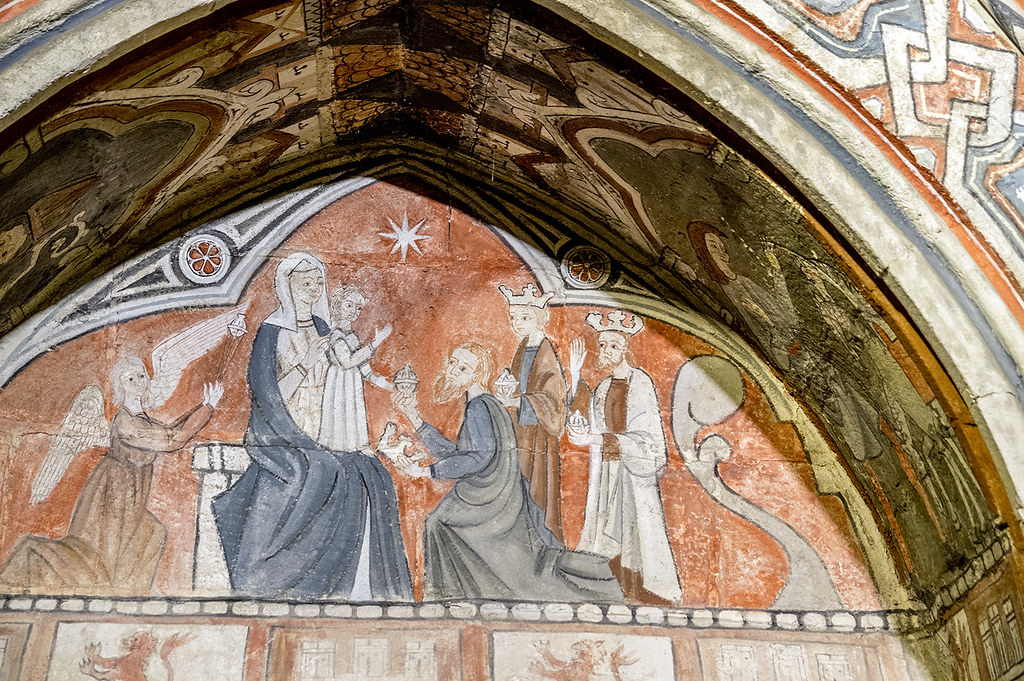
On the north wall of the chapel, like a tapestry, is the Last Judgement, from the 14th century. In the centre, Christ descends to earth in an oval, almond-shaped halo, surrounded by angels and seraphim showing the wounds on his hands, feet and side, a sign of his sacrifice for the salvation of humanity. He is flanked by the heavenly court, made up of the Virgin Mary and John the Baptist and the Apostles. Below the image of Christ is the altar with the insignia Christi, i.e. the instruments of the Passion: the cross, the cane with the sponge soaked in vinegar, the spear, the crown of thorns, the nails and the scourge. On the sides of the altar, two angels blow the trumpets of judgement, announcing the Last Judgement. Under the altar is the crowd of martyrs. At the bottom of the painting, from left to right, we see Paradise, Purgatory, Limbo and Hell – the description of the realms of life after death, separating the saved from the damned.
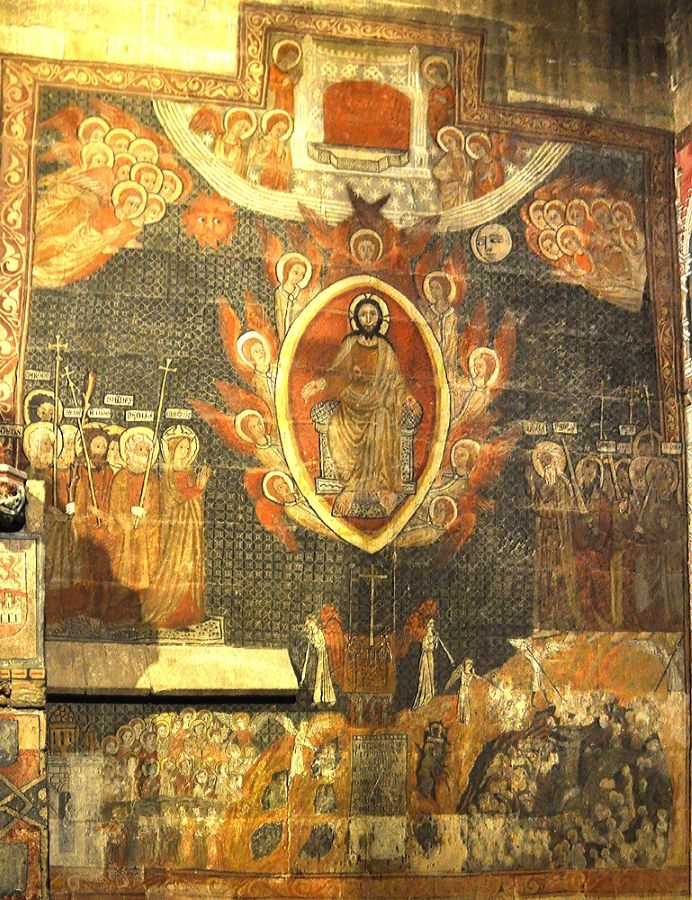
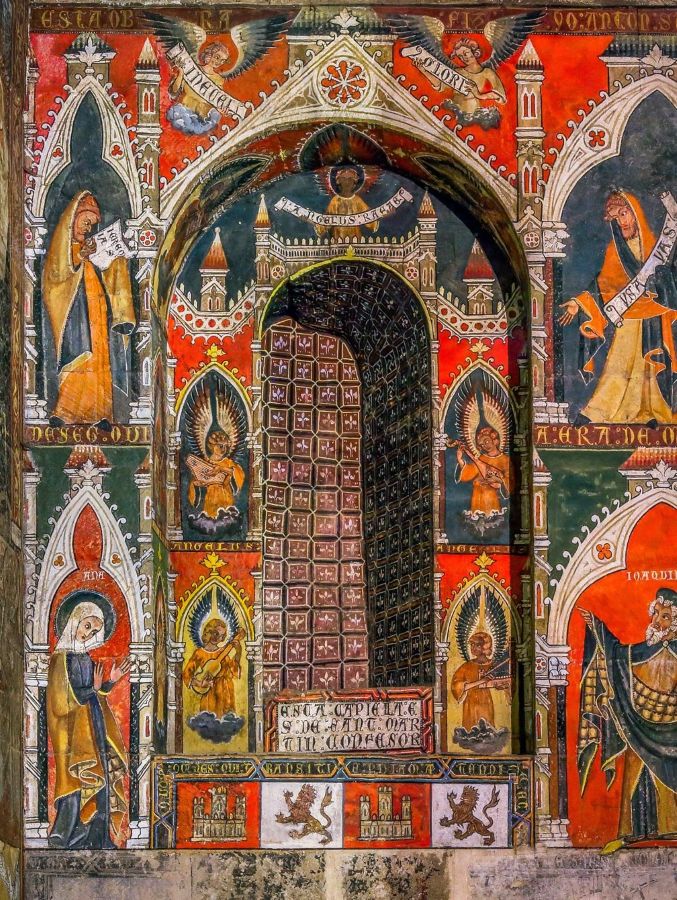
The image on the right has a polychrome altarpiece with a central niche (where there was an opening), which leads us to imagine the possible location of a carving of Saint Martin, surrounded by angels and at the ends Saint Anne, Saint Joachim, Jeremiah, Isaiah and Daniel. Once again, the emblems of Castile and León are represented, which at the time the chapel was built were already one kingdom.
Outside the chapel, a mural evokes the legend of Saint Martin sharing his cloak with a poor man.
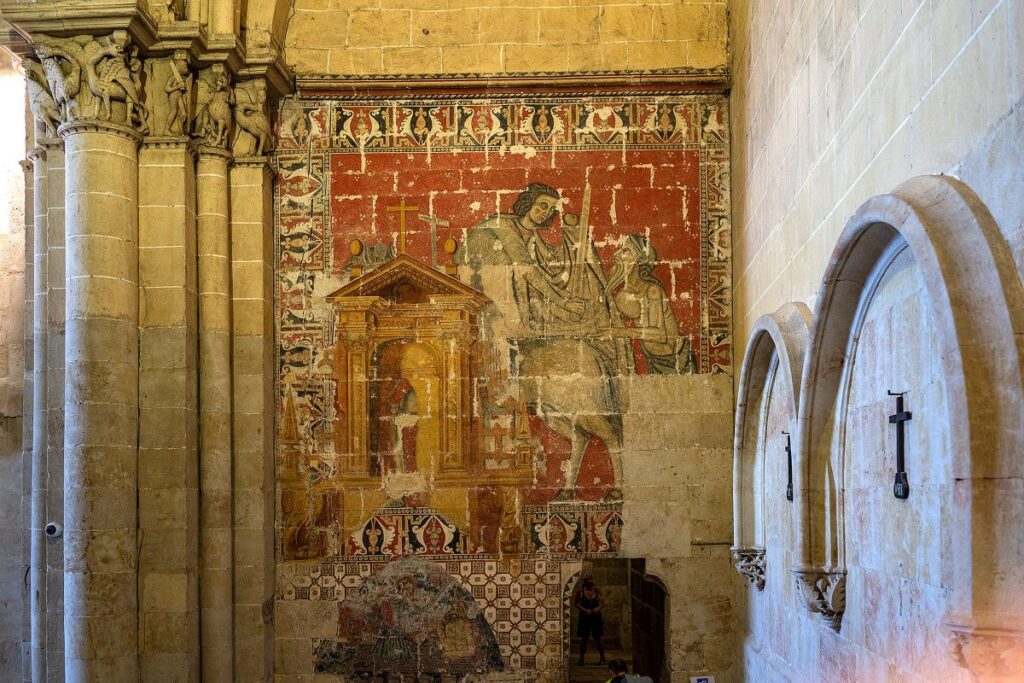
The Chapel of St Saviour or Talavera is the oldest in the entire cloister, and not in vain was it the first chapter house. It is covered by an octagonal dome with 16 columns on which the ribs rest, forming a star-shaped design with its crosses, of clear Islamic influence (13th century). Presiding over the chapel is a valuable 16th century altarpiece, in which a Gothic image of the Virgin was enthroned. In the centre is the tomb containing the remains of the founder, Rodrigo Arias Maldonado, along with those of his wife and family.
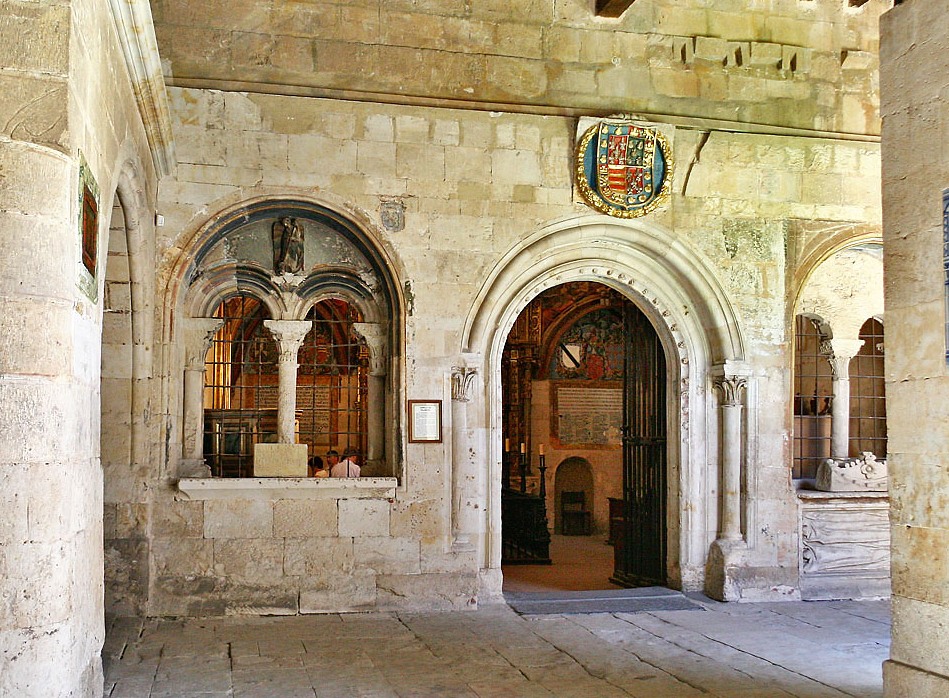
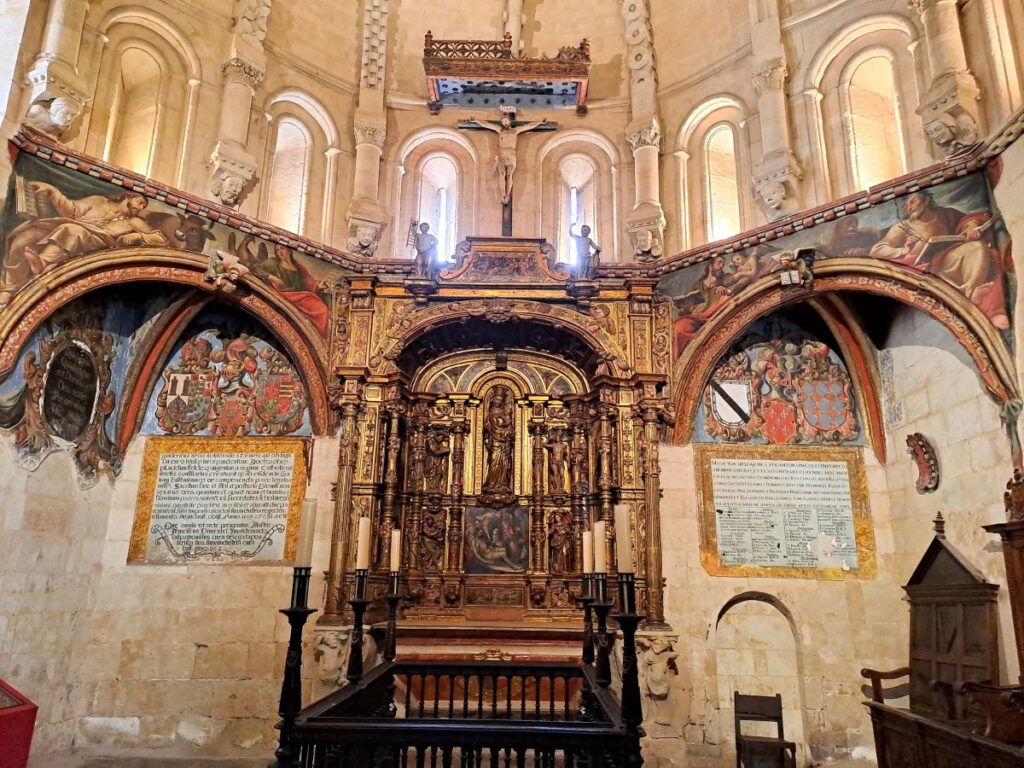
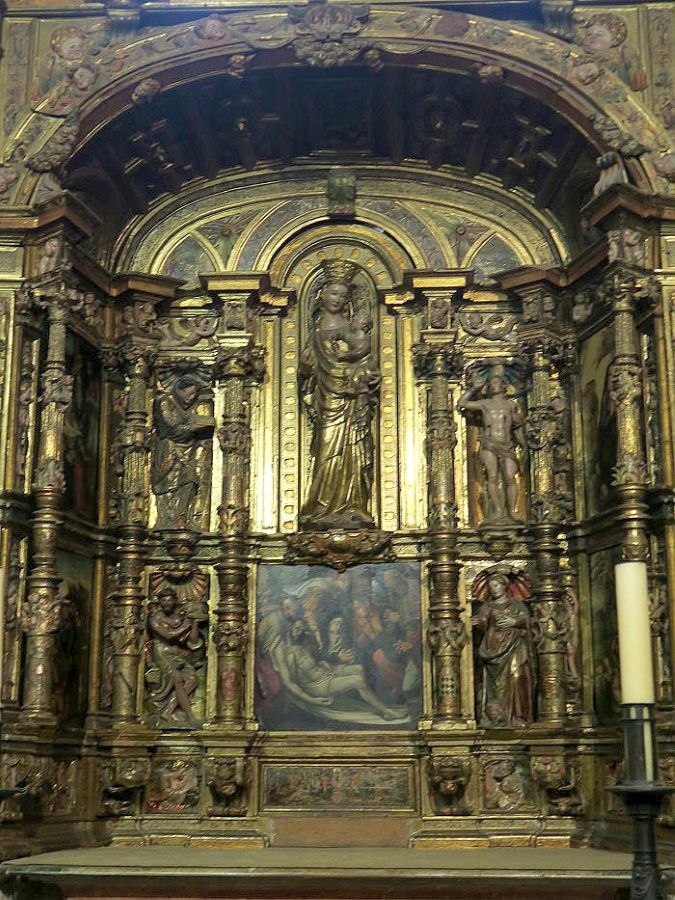
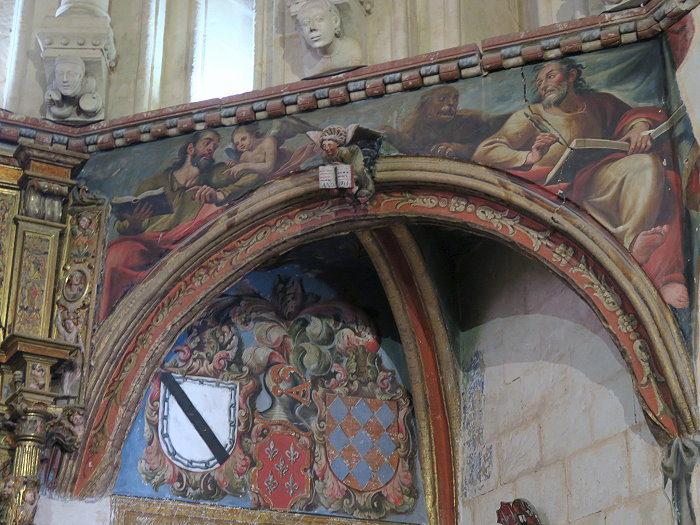
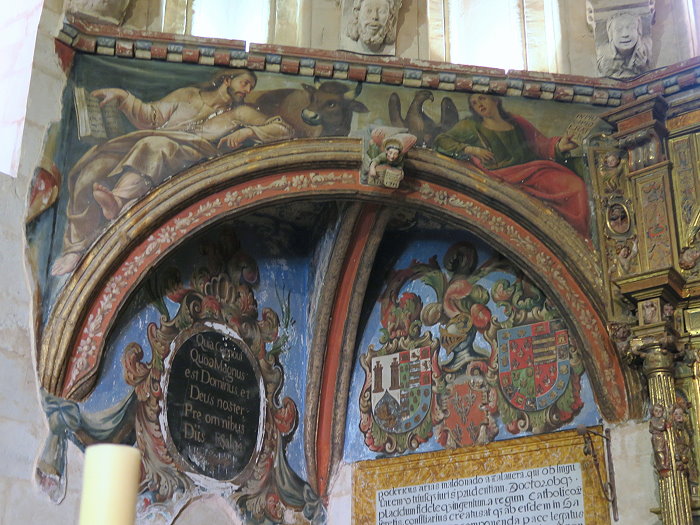
Chapel of Saint Barbara – was founded by Bishop Juan Lucero in the mid-14th century, who is buried in his own tomb located in the centre. The altarpiece, from the 16th century, is dedicated to the life and martyrdom of the saint and is of Italian influence. The decoration of the altar table stands out, with tiles from Talavera. This Renaissance altarpiece concealed the 14th-century Gothic wall paintings depicting 15 scenes from the saint’s life, which were discovered and unveiled in 2020.
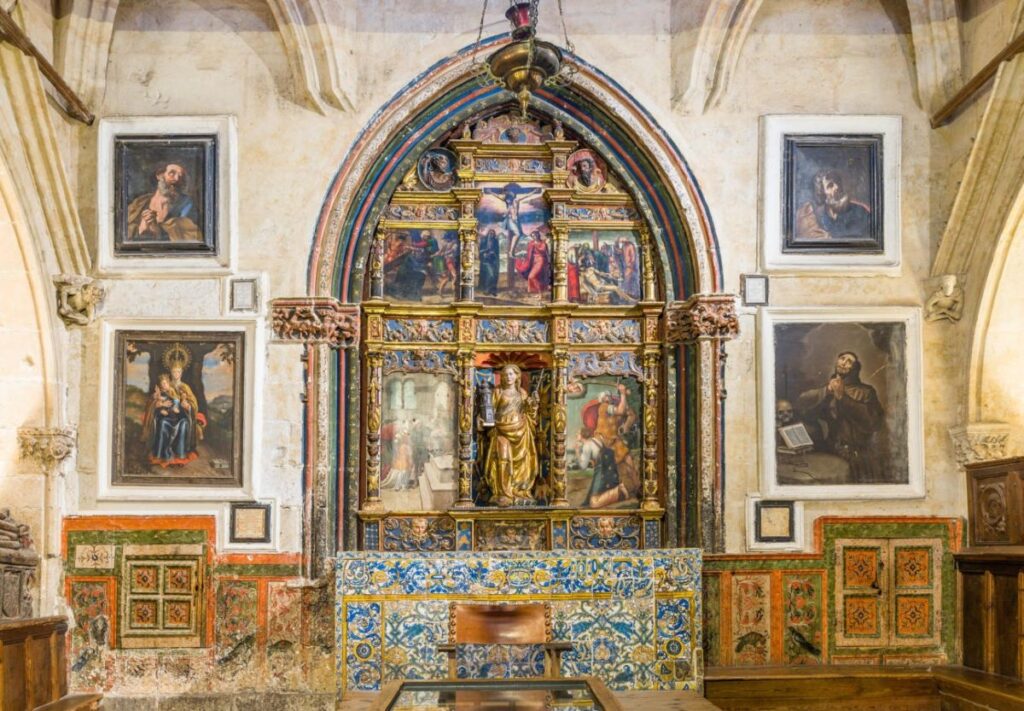

In the image below we have another view of the chapel, where on the right you can see the mural paintings, also from the 14th century, and on the left the altarpiece mounted in such a way as to be able to slide out and show the murals.
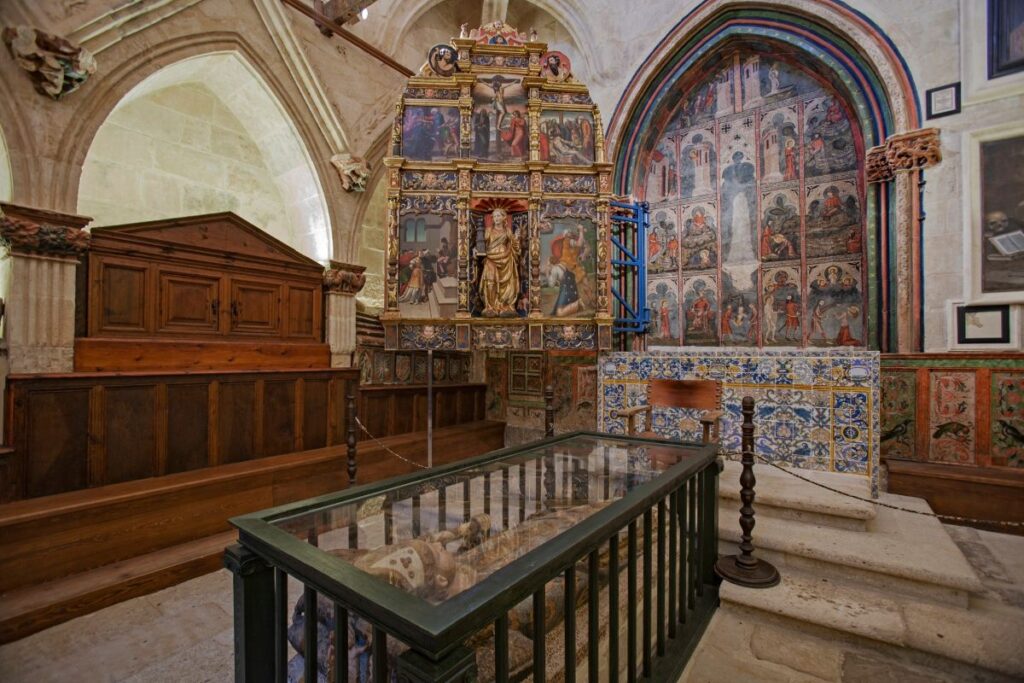
The graduation ceremonies of the University of Salamanca were held here until 1843. The student taking the doctoral exam had to spend the whole night locked in the chapel. If he passed the exam, he left through the main door of the cathedral, where his friends were waiting for him and throwing a party, and if he didn’t pass the exam, he left through another door, known as the Door of the Carros or the Door of the Donkeys, where there were no friends and no party.
The Chapel of Saint Catalina, or Singing Chapel because it was the place for singing rehearsals, was founded in the 12th century by Bishop Vidal and remodelled and enlarged with two more sections in the 15th century, covered by a ribbed vault to house the chapter library. It is the most spacious chapel in the entire cloister, where the cathedral institution carries out numerous activities.
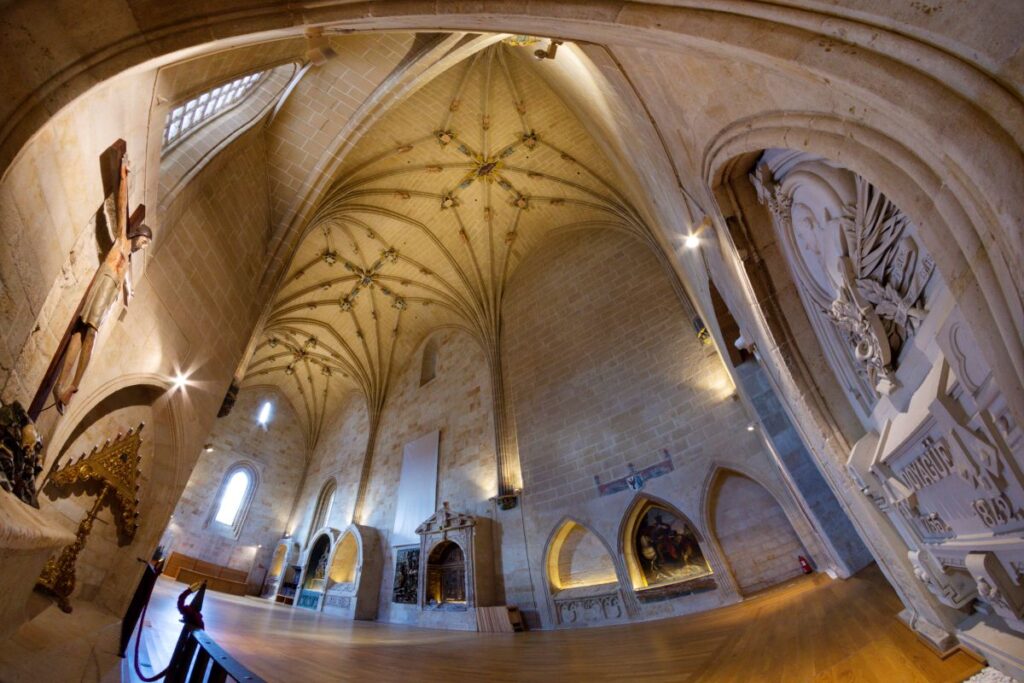
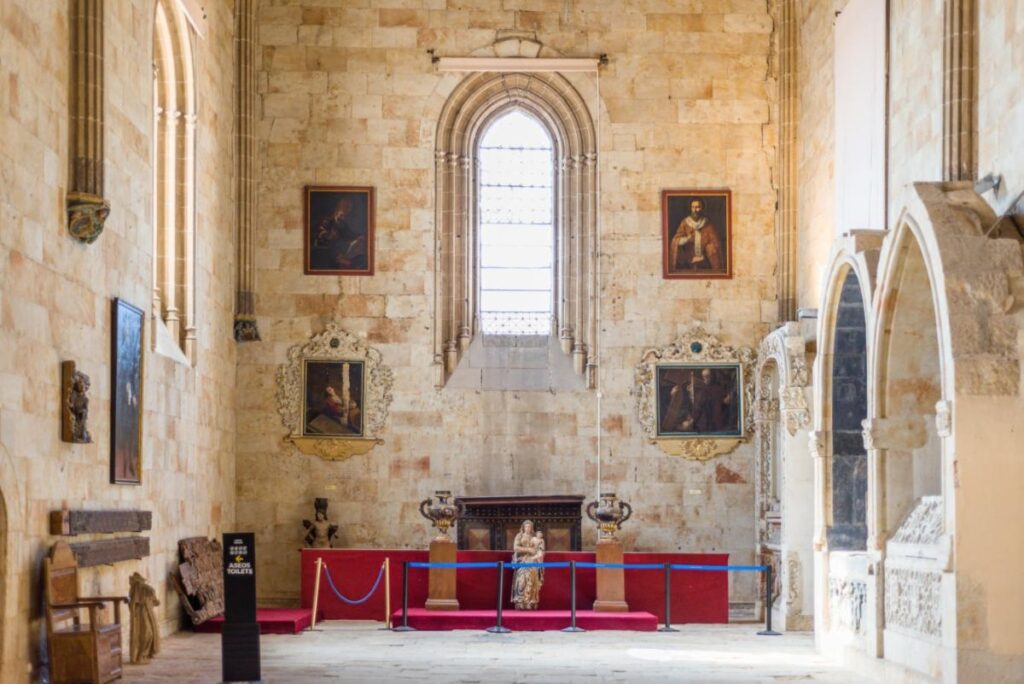
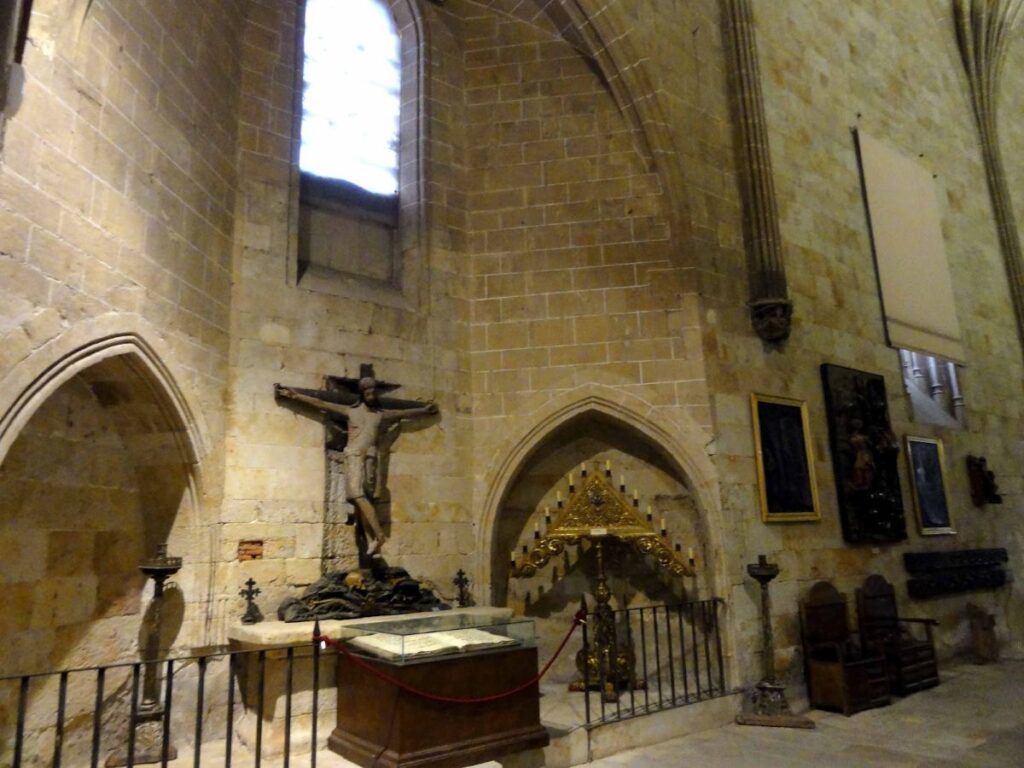
The Chapel of Saint Bartholomew or Anaya is the last and one of the most important in the Old Cathedral, due to the works that can be found there. Among others, the mausoleum of the founder in the centre of the chapel and a beautiful Renaissance altarpiece stand out.

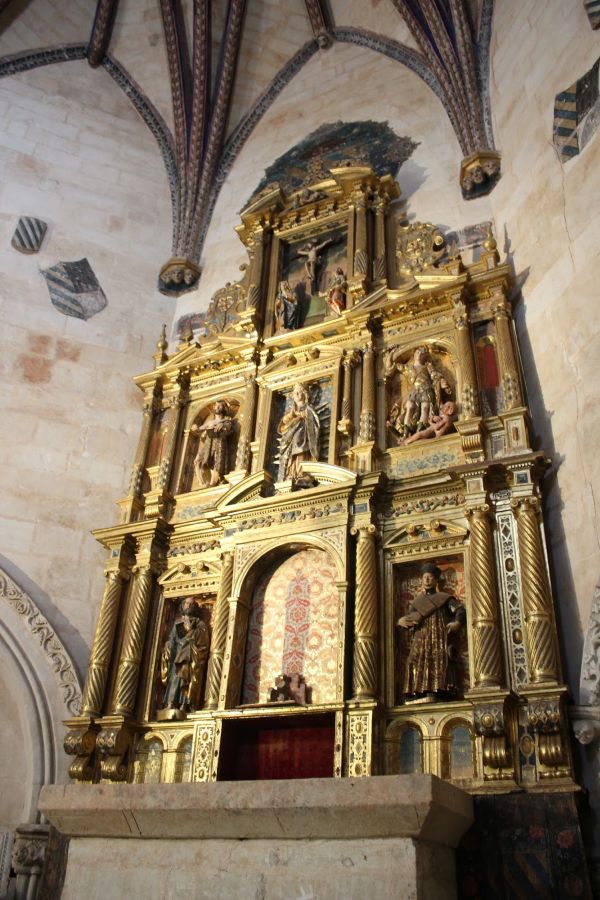
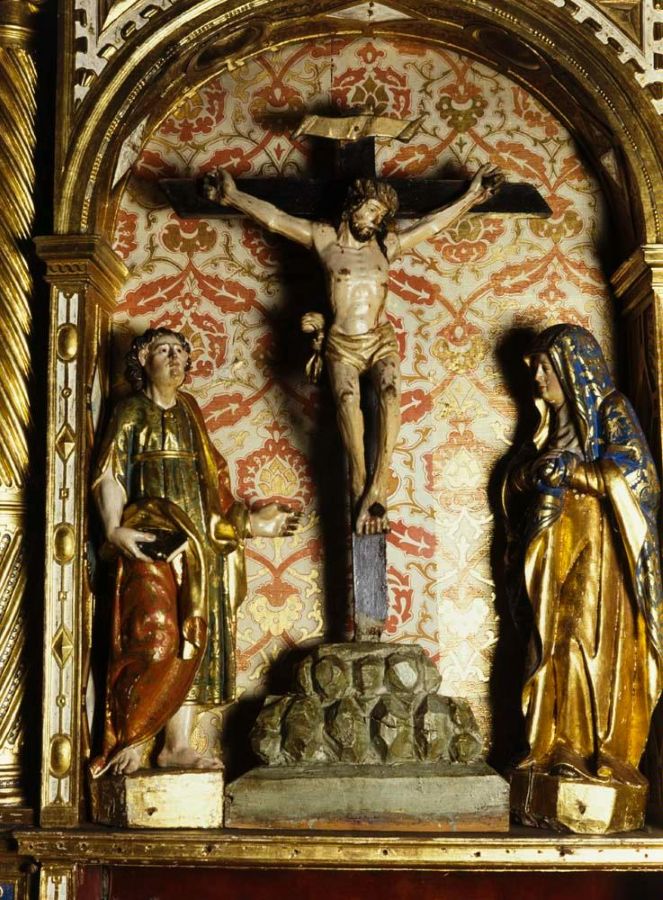
Sepulchre of Don Diego de Anaya y Maldonado – This is a sepulchre supported by lions surrounded by reliefs under arches – Christ, Mary and the Apostles. Above, Don Diego de Anaya, Archbishop of Seville, reclining, with Calvary at the head and a coat of arms at his feet, all in alabaster. It is surrounded by a Gothic railing from the first third of the 16th century, with allusions to death and certain Plateresque touches.
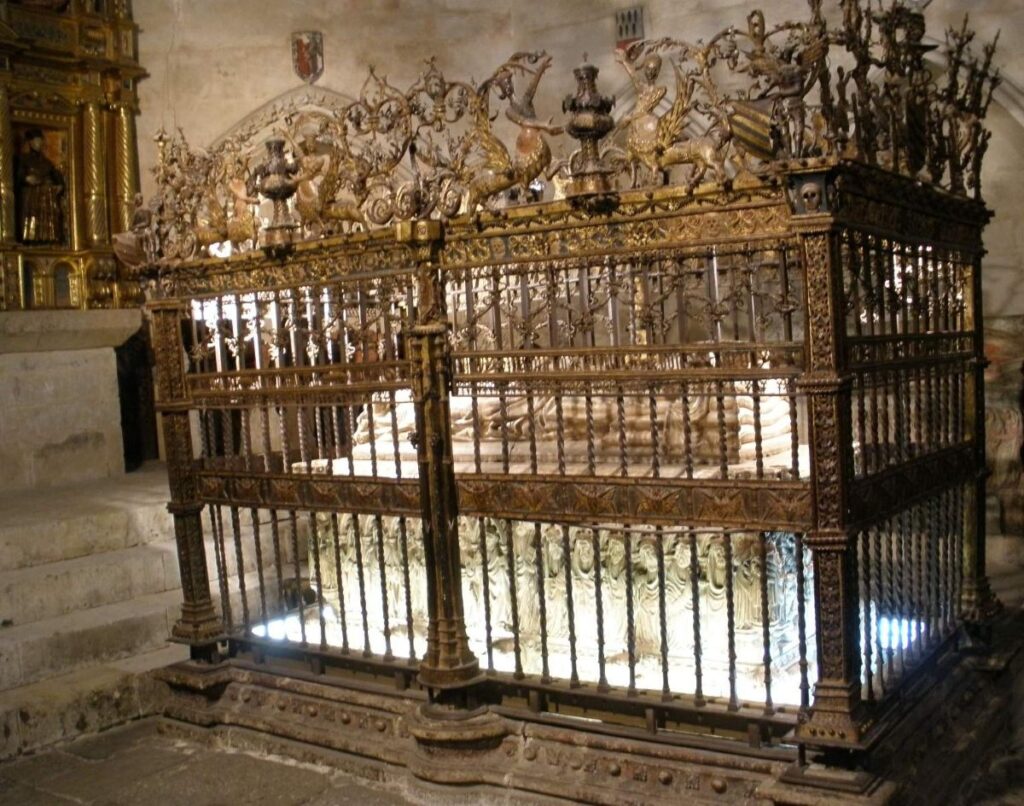

On the walls of the chapel there are other tombs; of particular note are the two arches under the organ tribune corresponding to Don Gutierre de Monroy and Doña Constanza de Anaya, who died in 1517 and 1504 respectively.
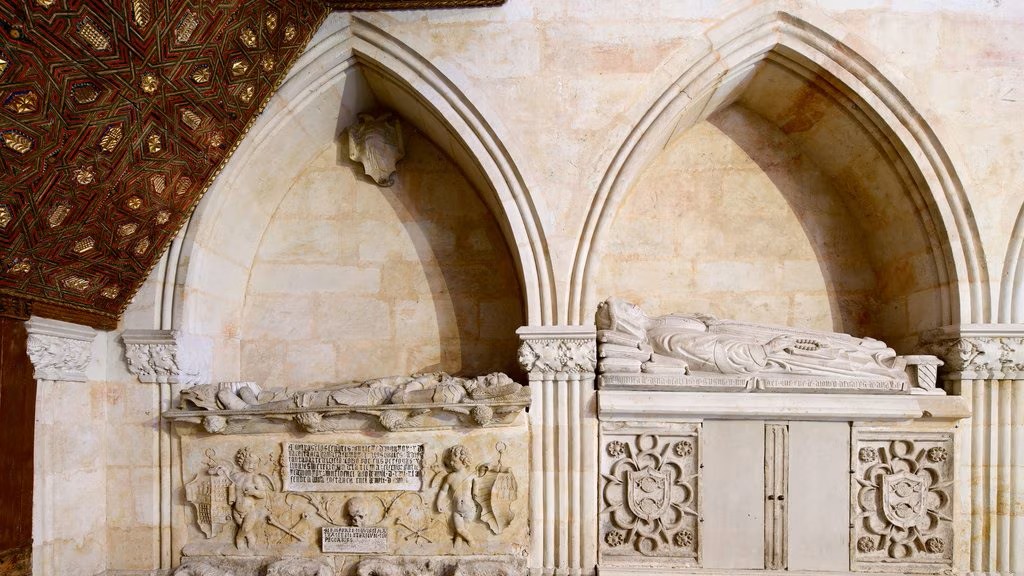
Some tombs retain the original colours in which they were made.
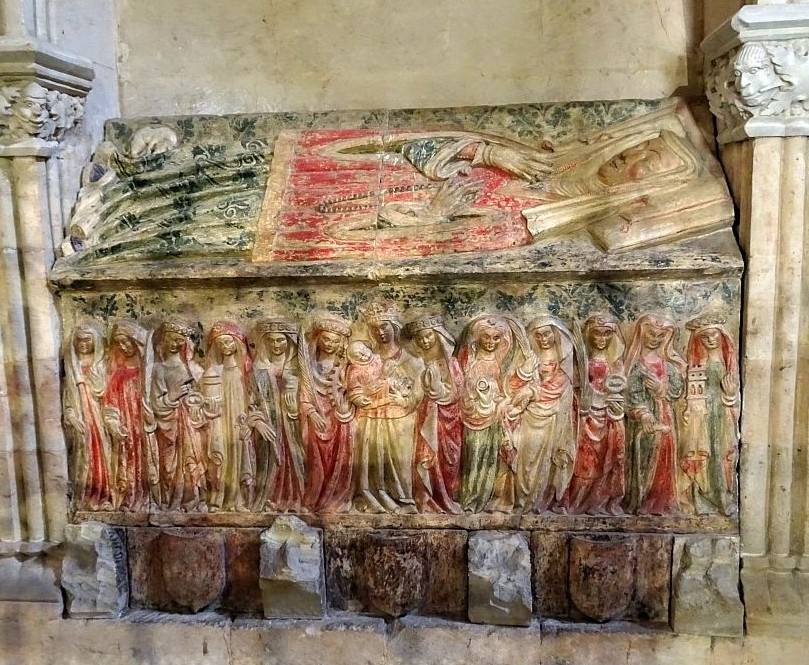
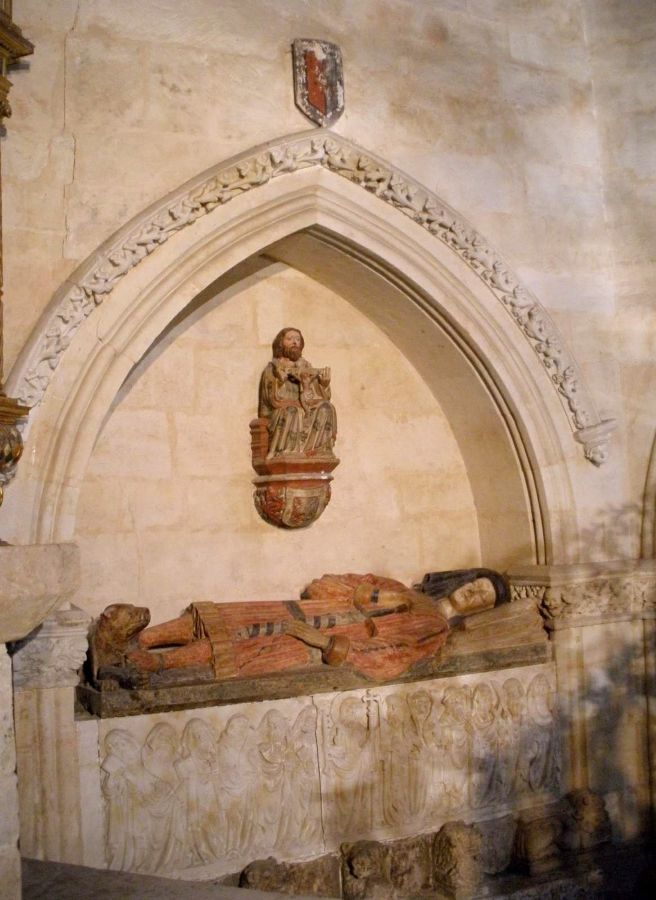
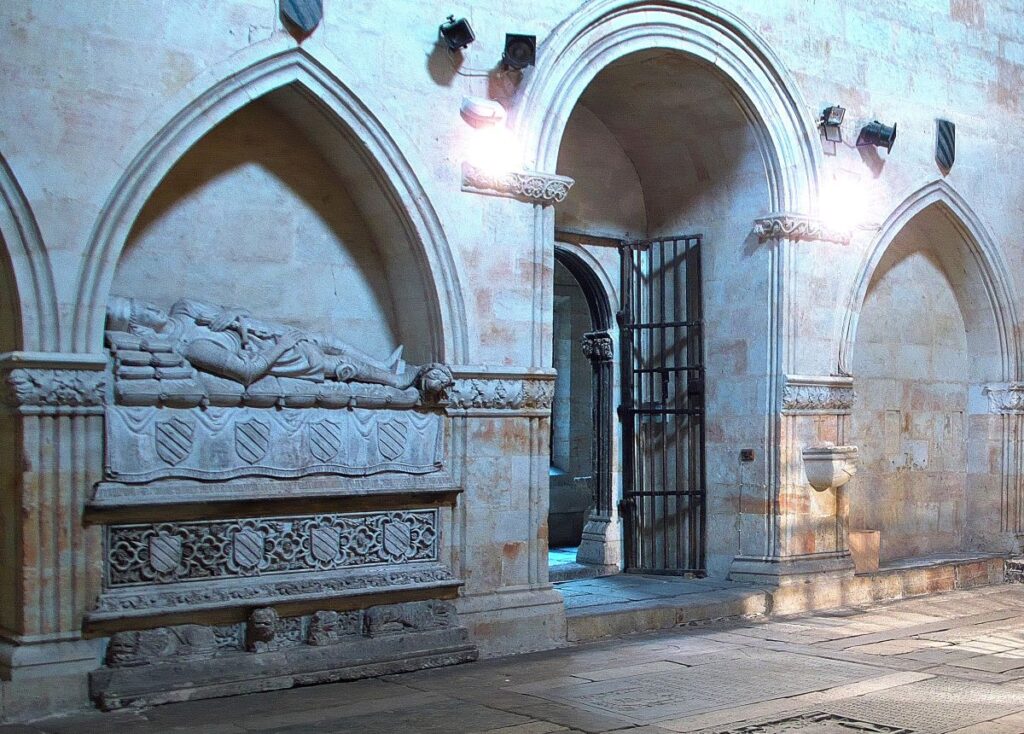
The majesty of the chapel is completed by the organ, one of the oldest in Europe, with paintings of the Anaya coat of arms and an Annunciation.
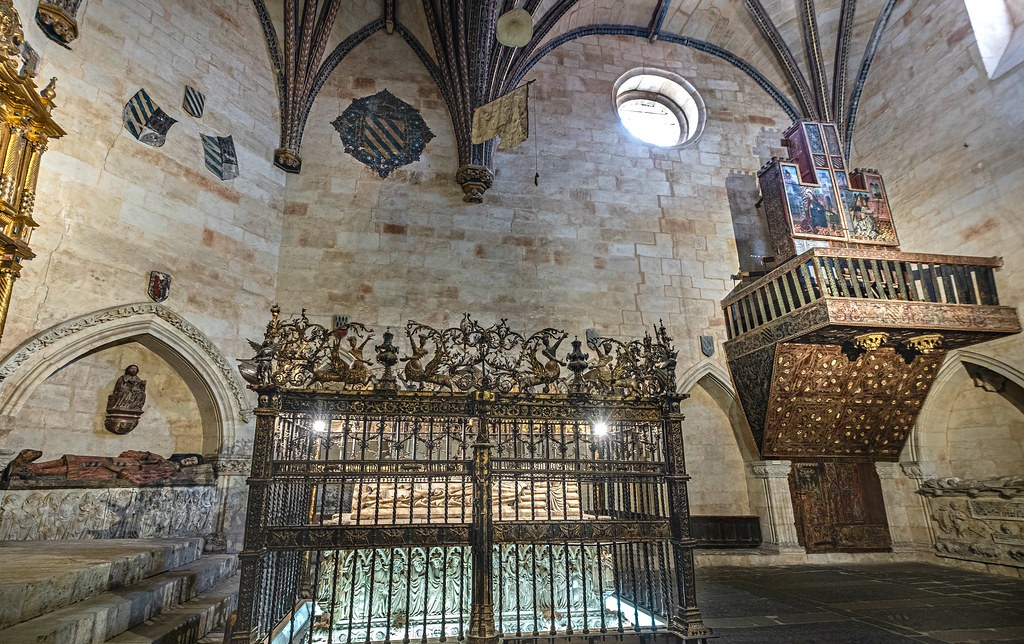
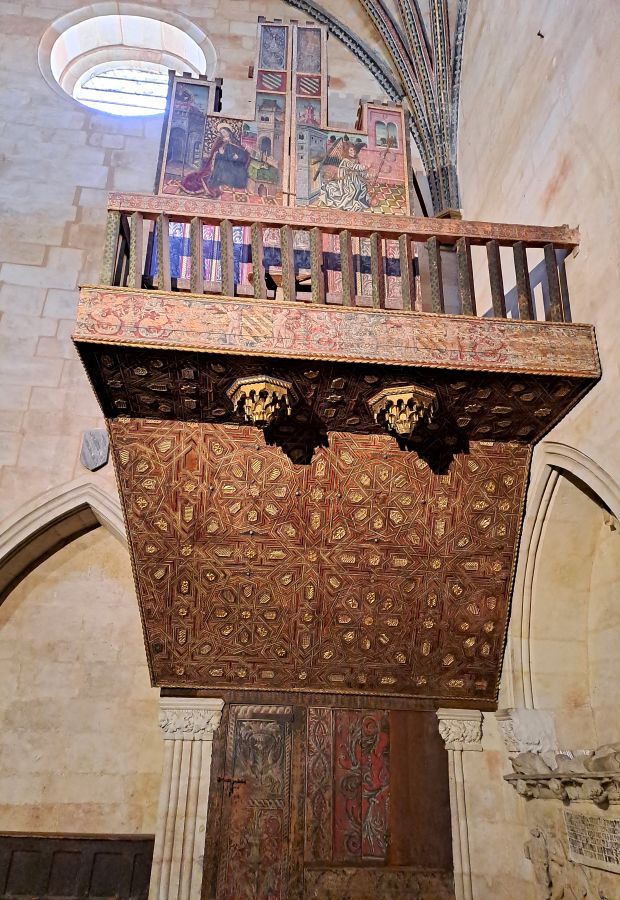
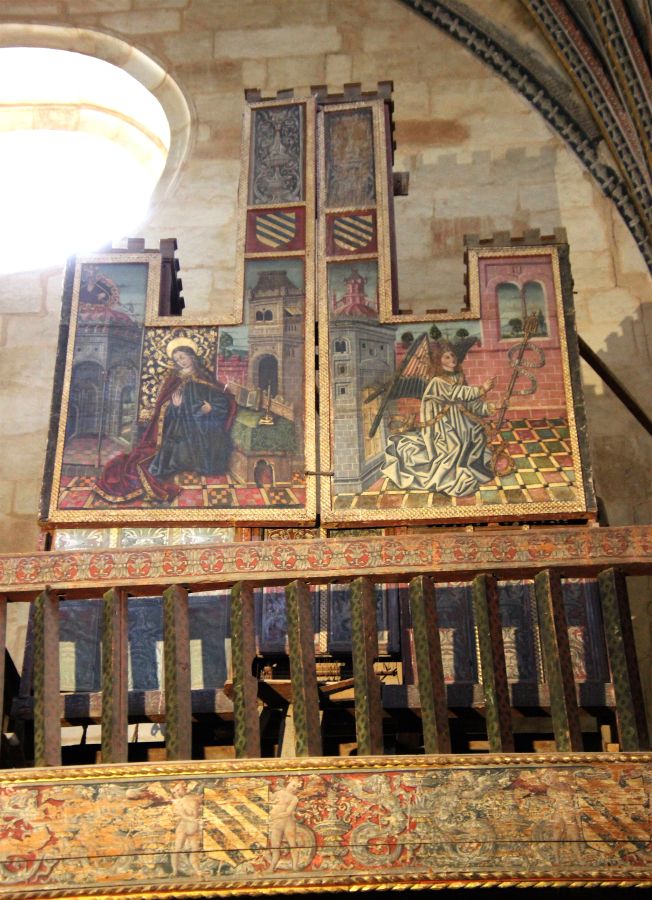
Transept
The south or Epistle transept of the Old Cathedral features frescoes with Progothic iconography about the Resurrection and the Last Judgement. On the back wall, there are two simplified images of the Last Judgement above the arches of Dona Elena de Castro and Don Aparicio Guillén.
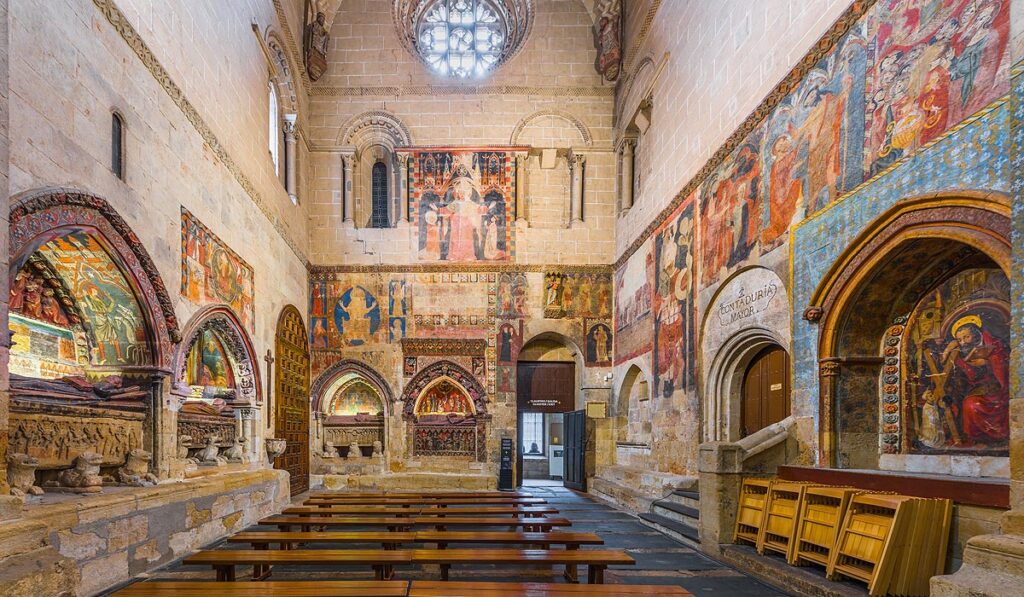
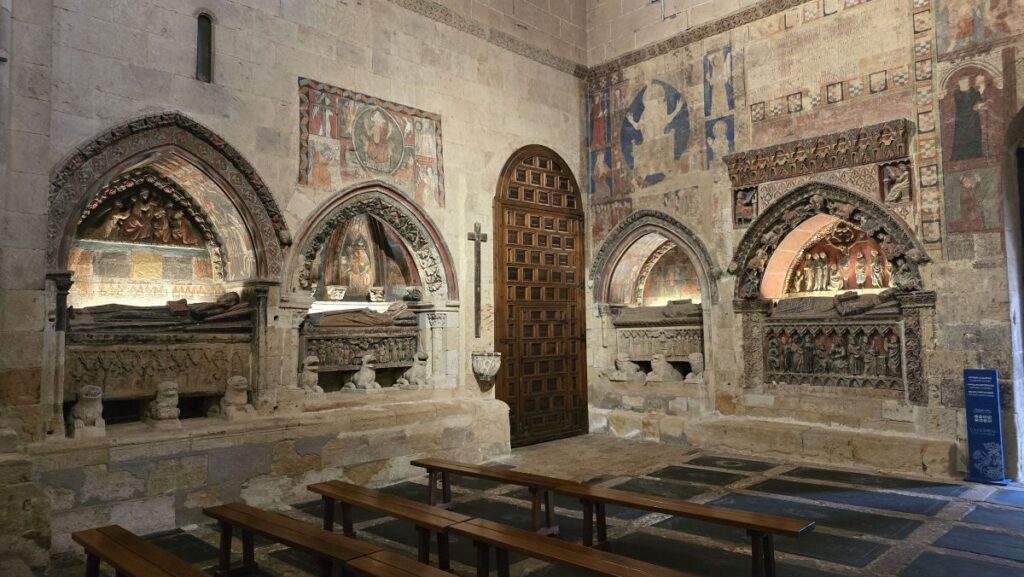
Before finishing our visit to the cathedrals, we also saw this beautiful 16th century archosol by Gutierre de Castro, made of marble, with a beautiful polychrome sandstone sculpture of a lament over the dead Christ, of great drama, attributed to Juan de Juni.
